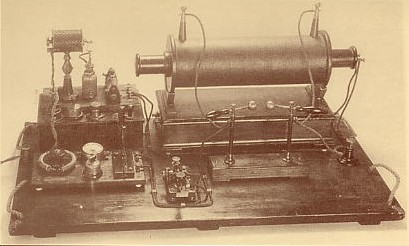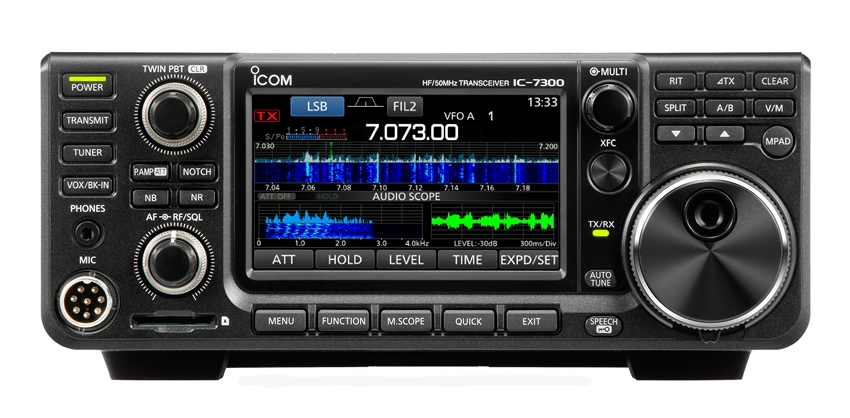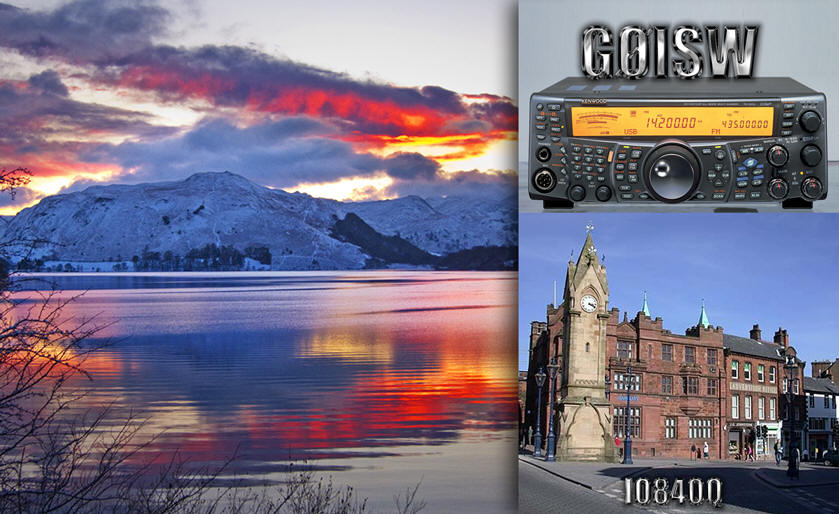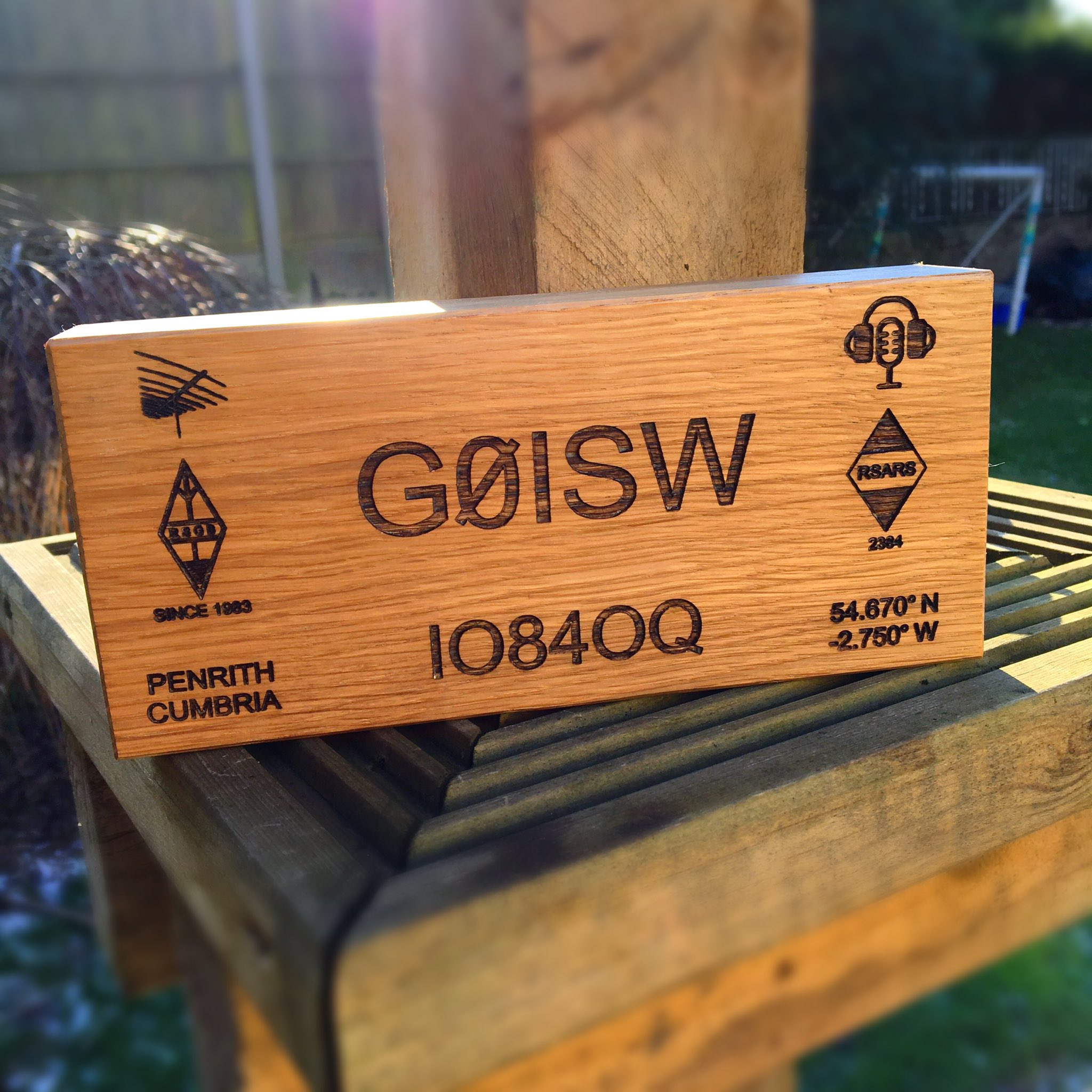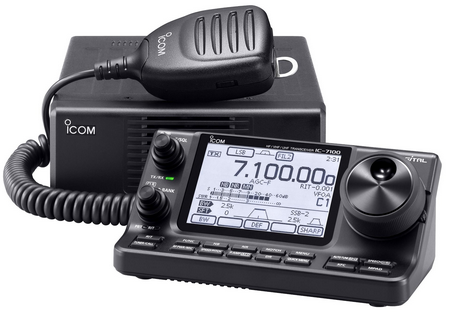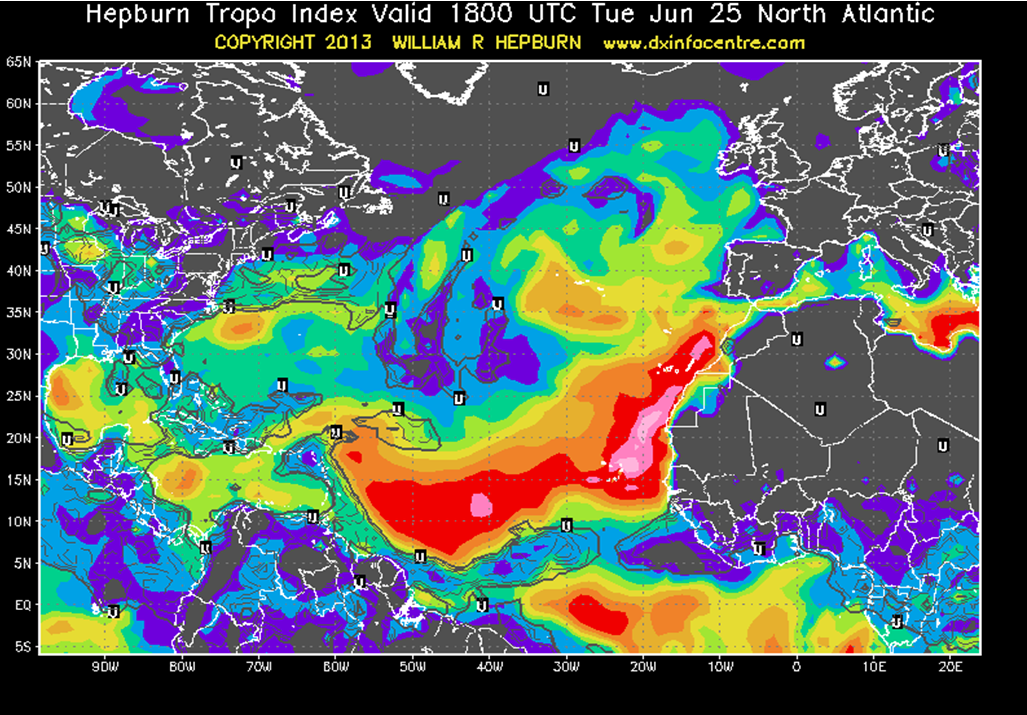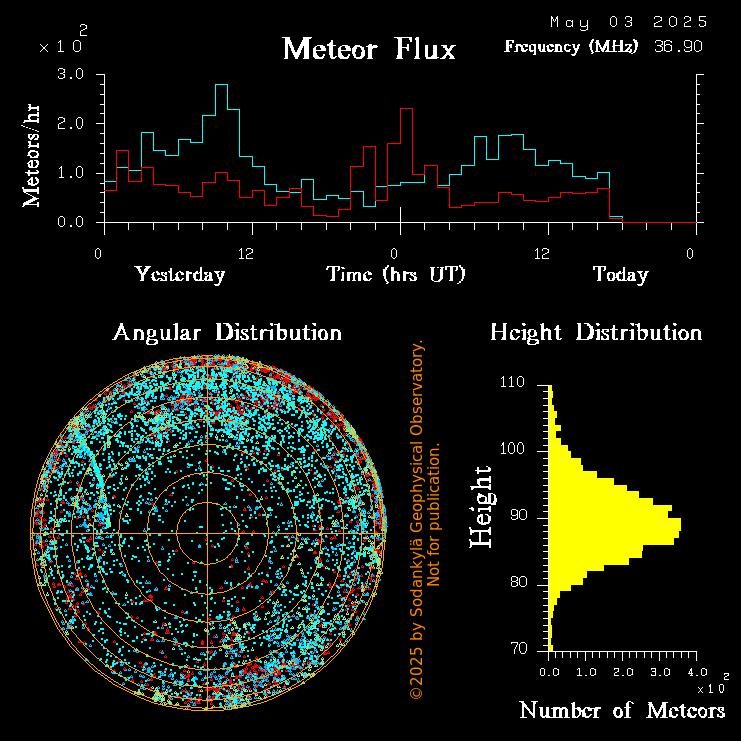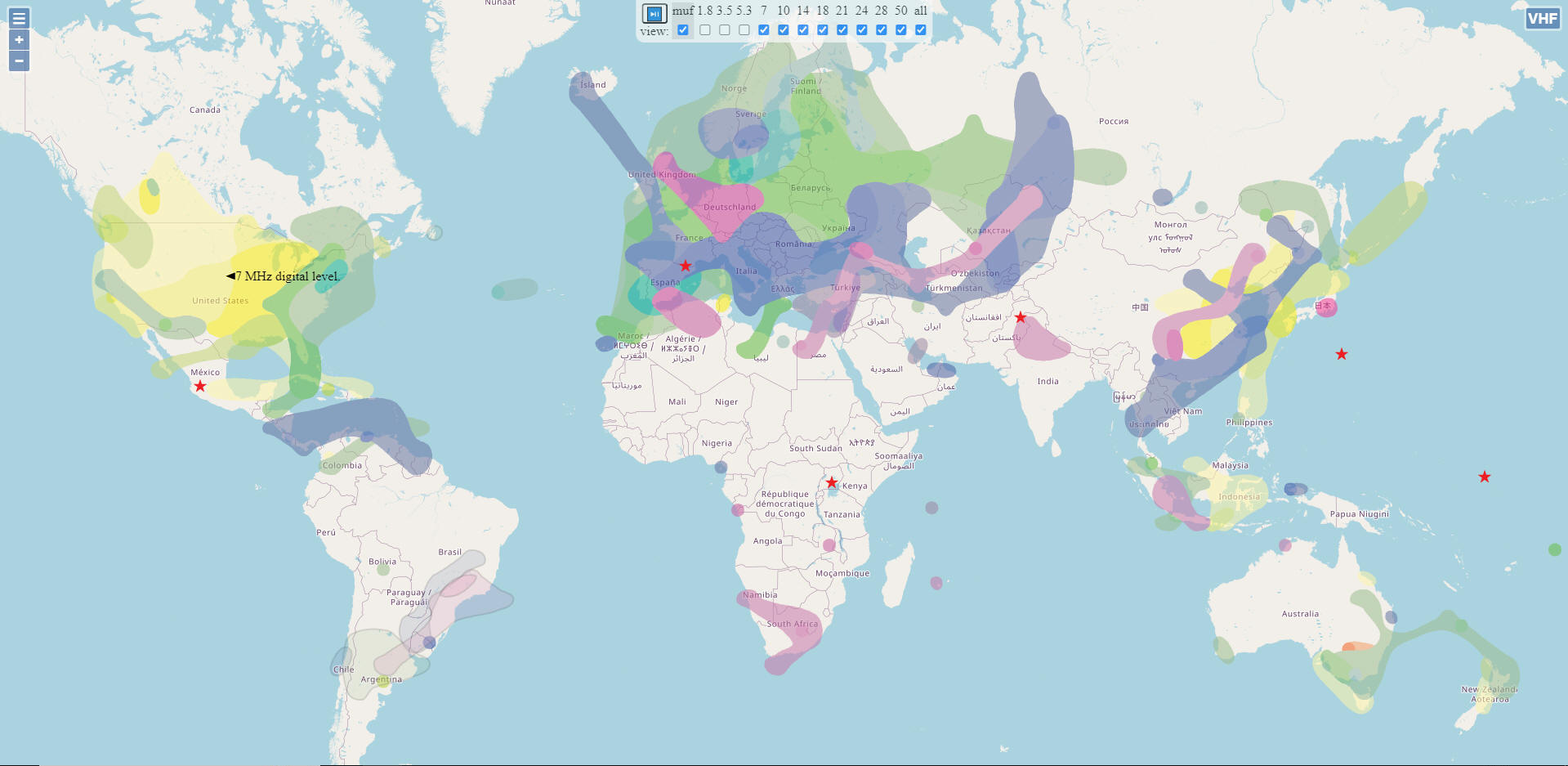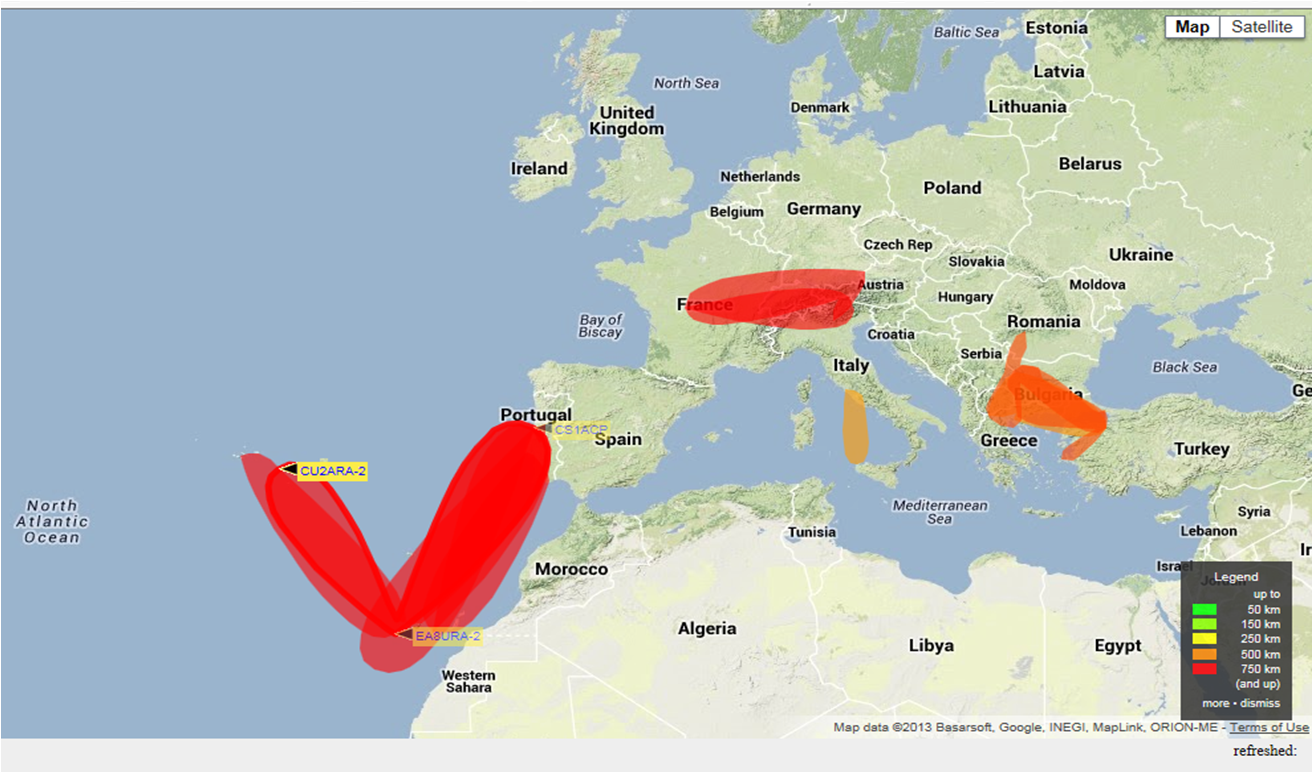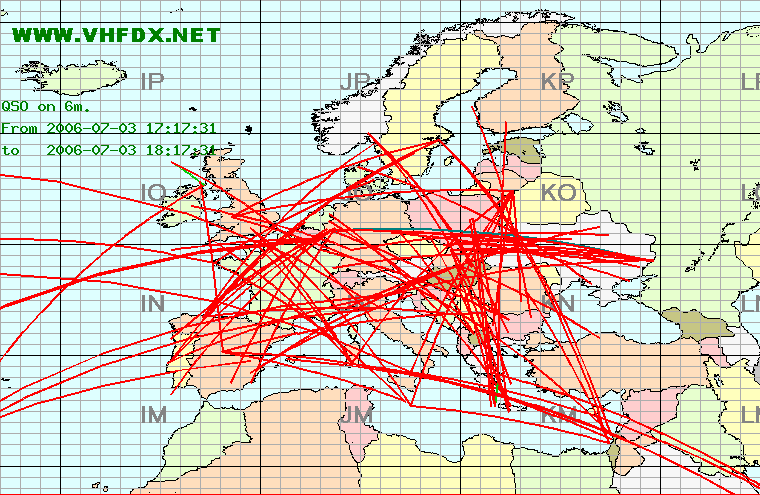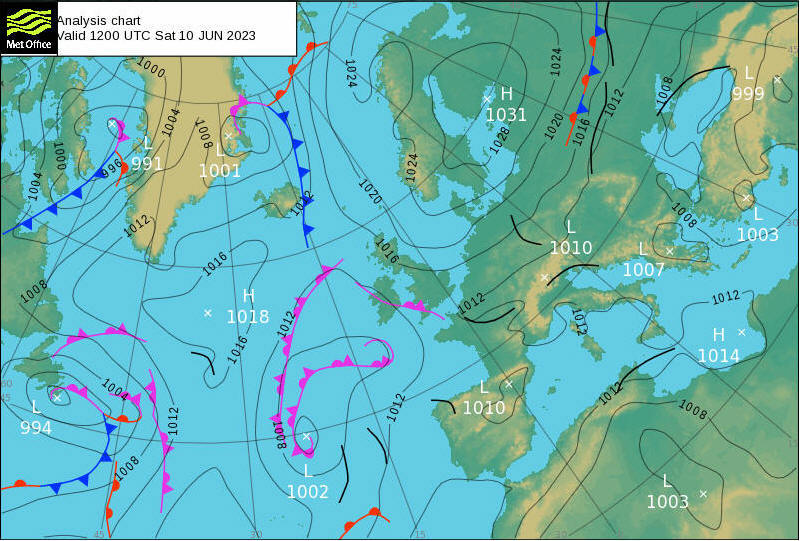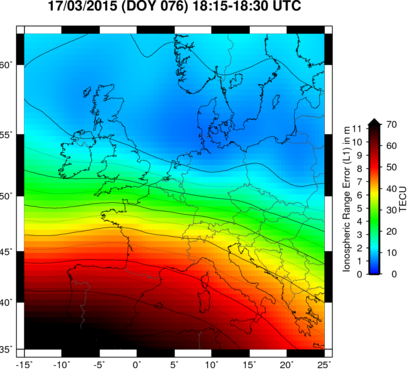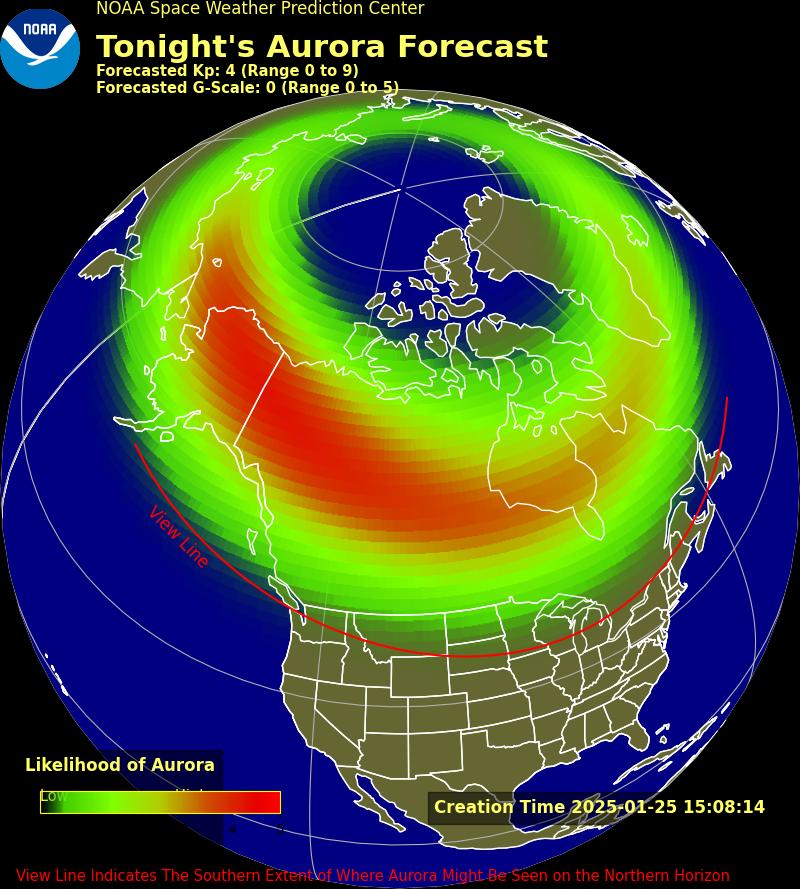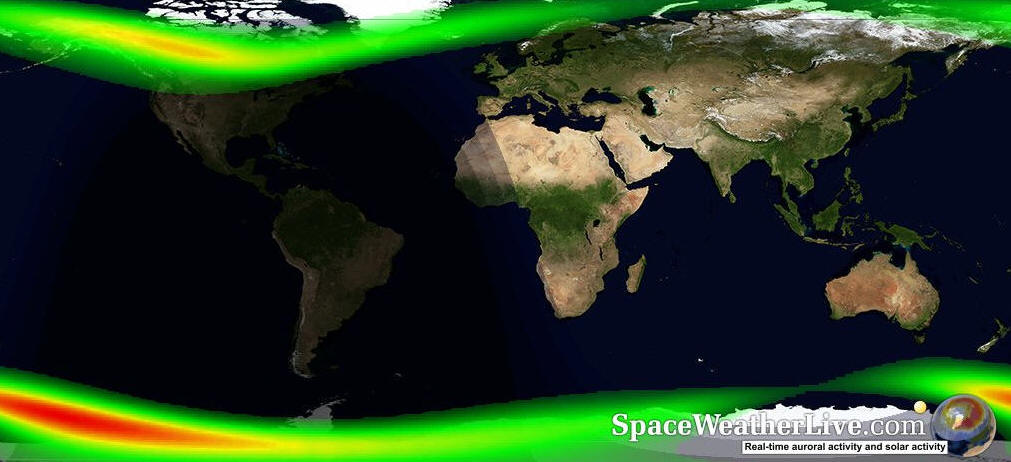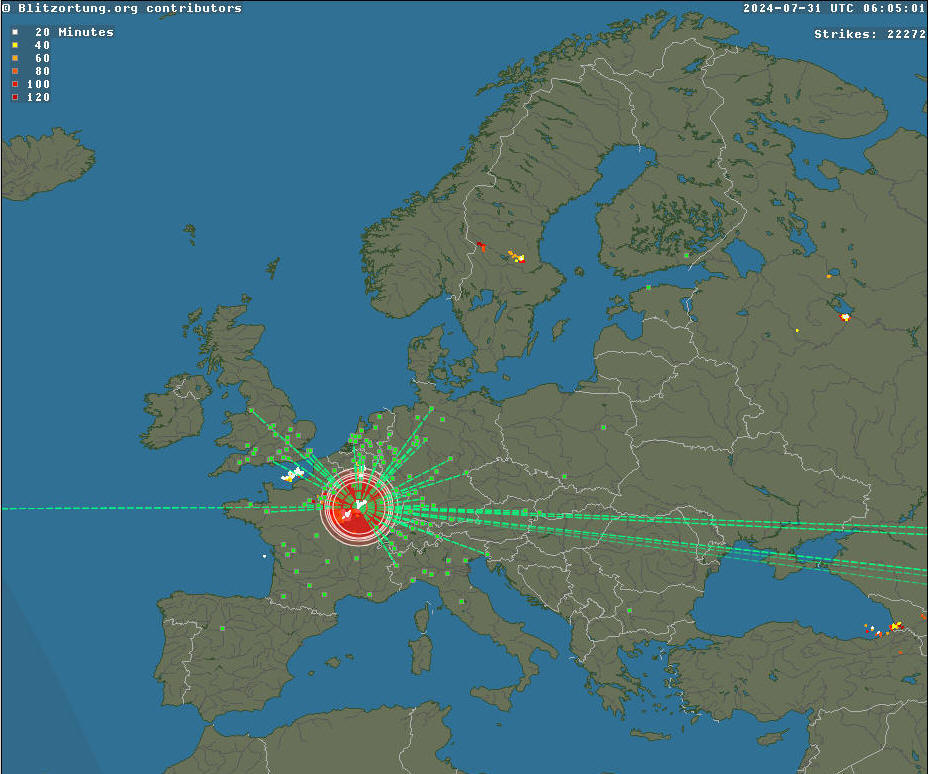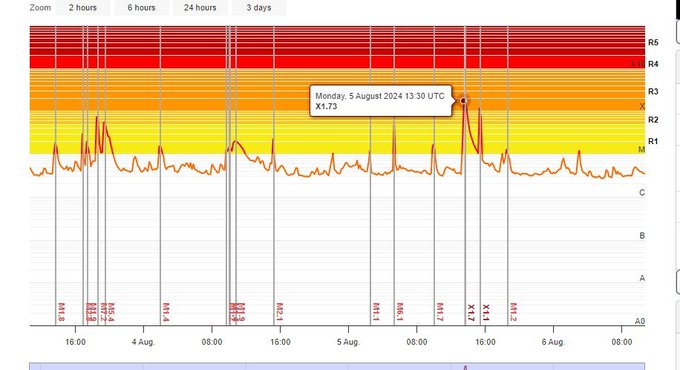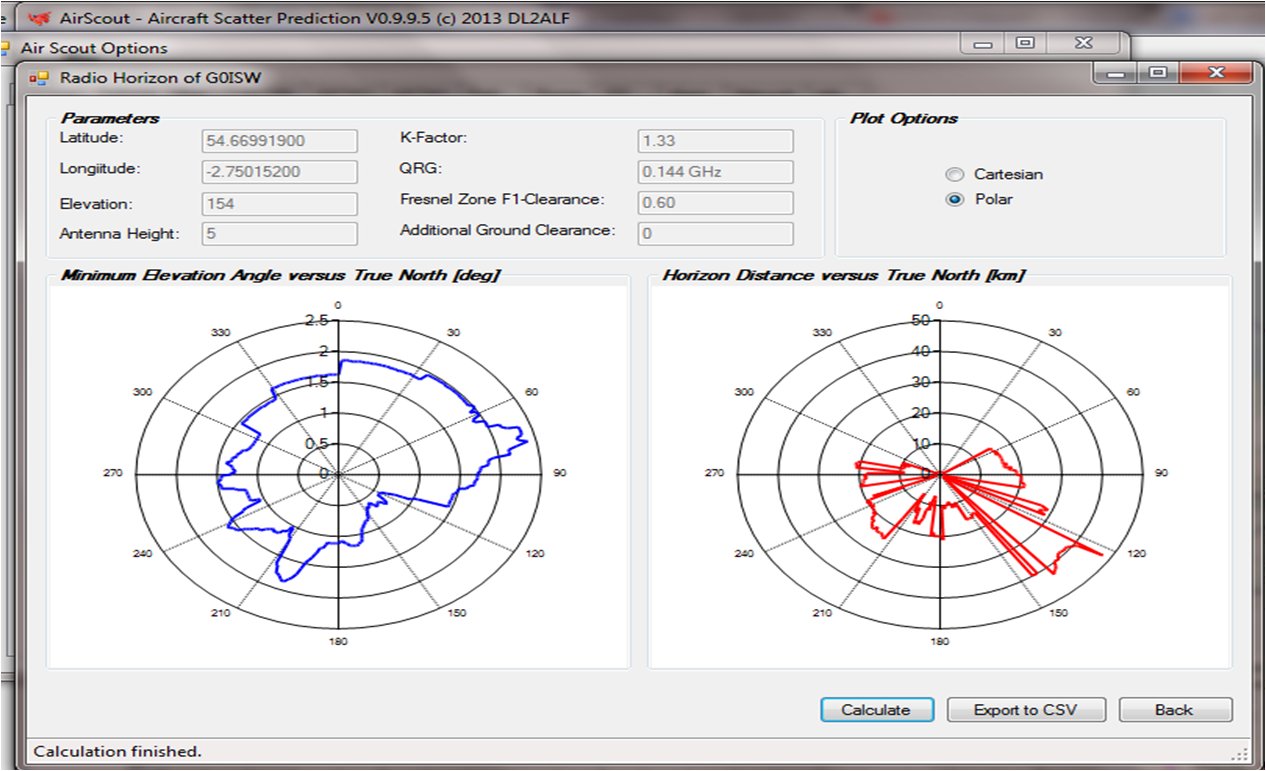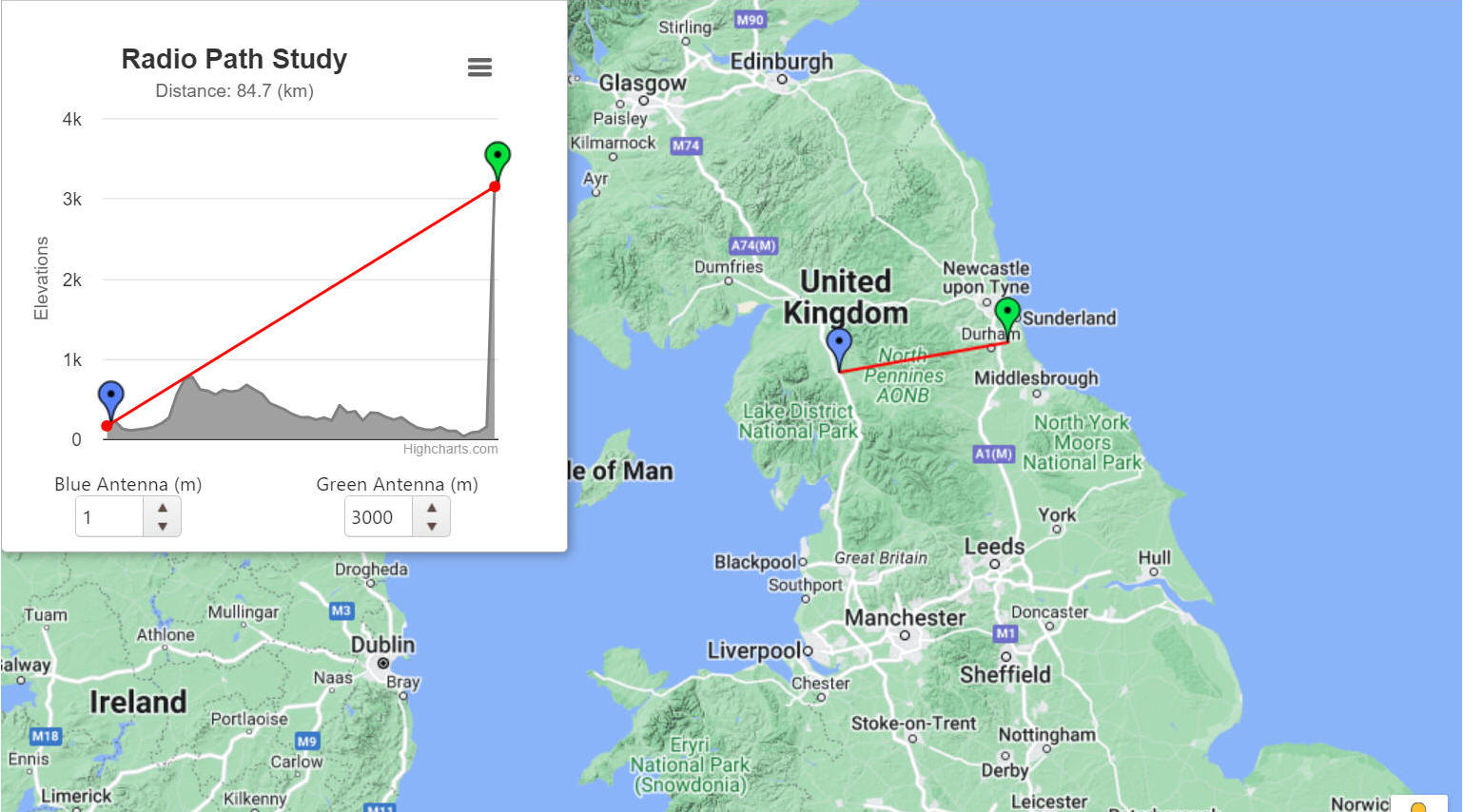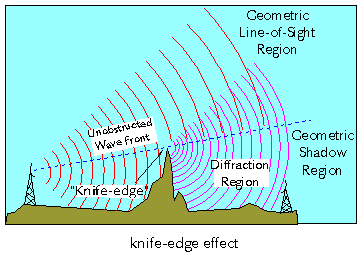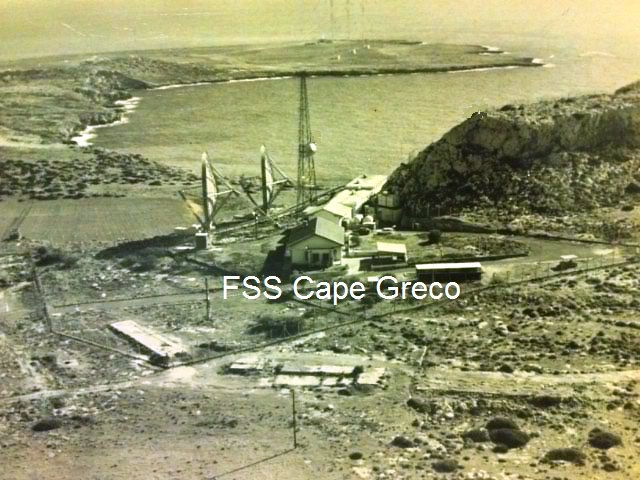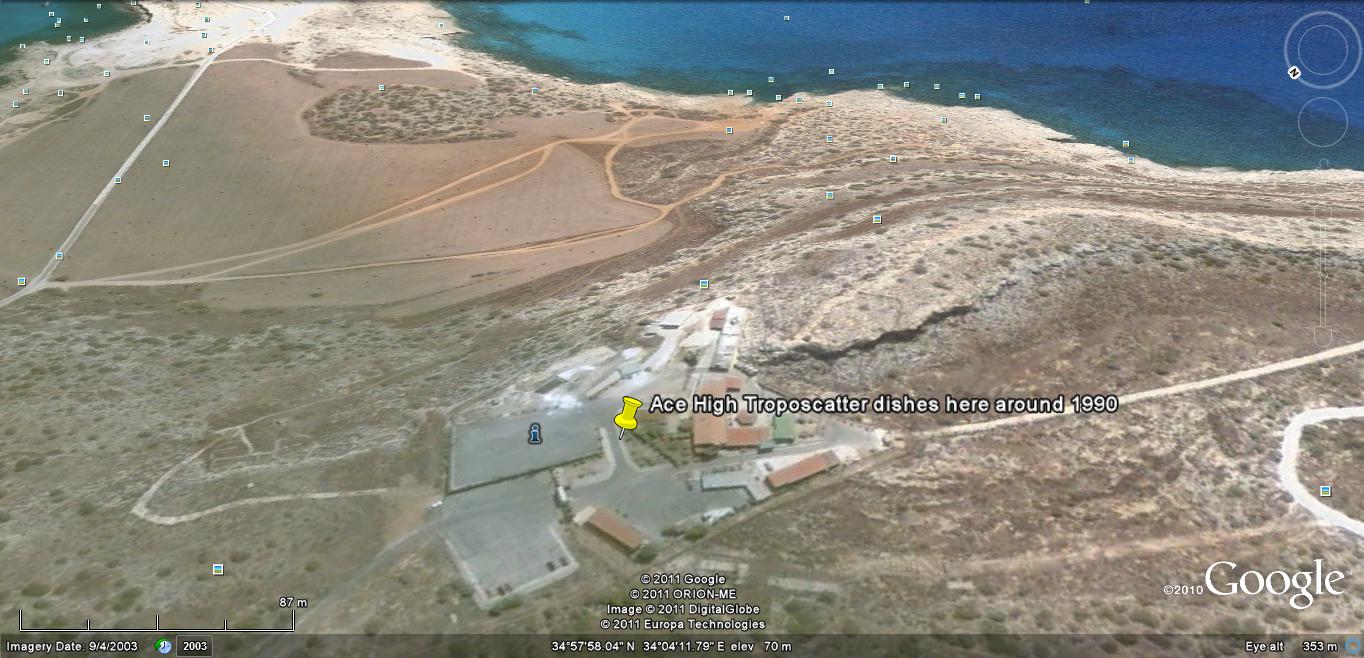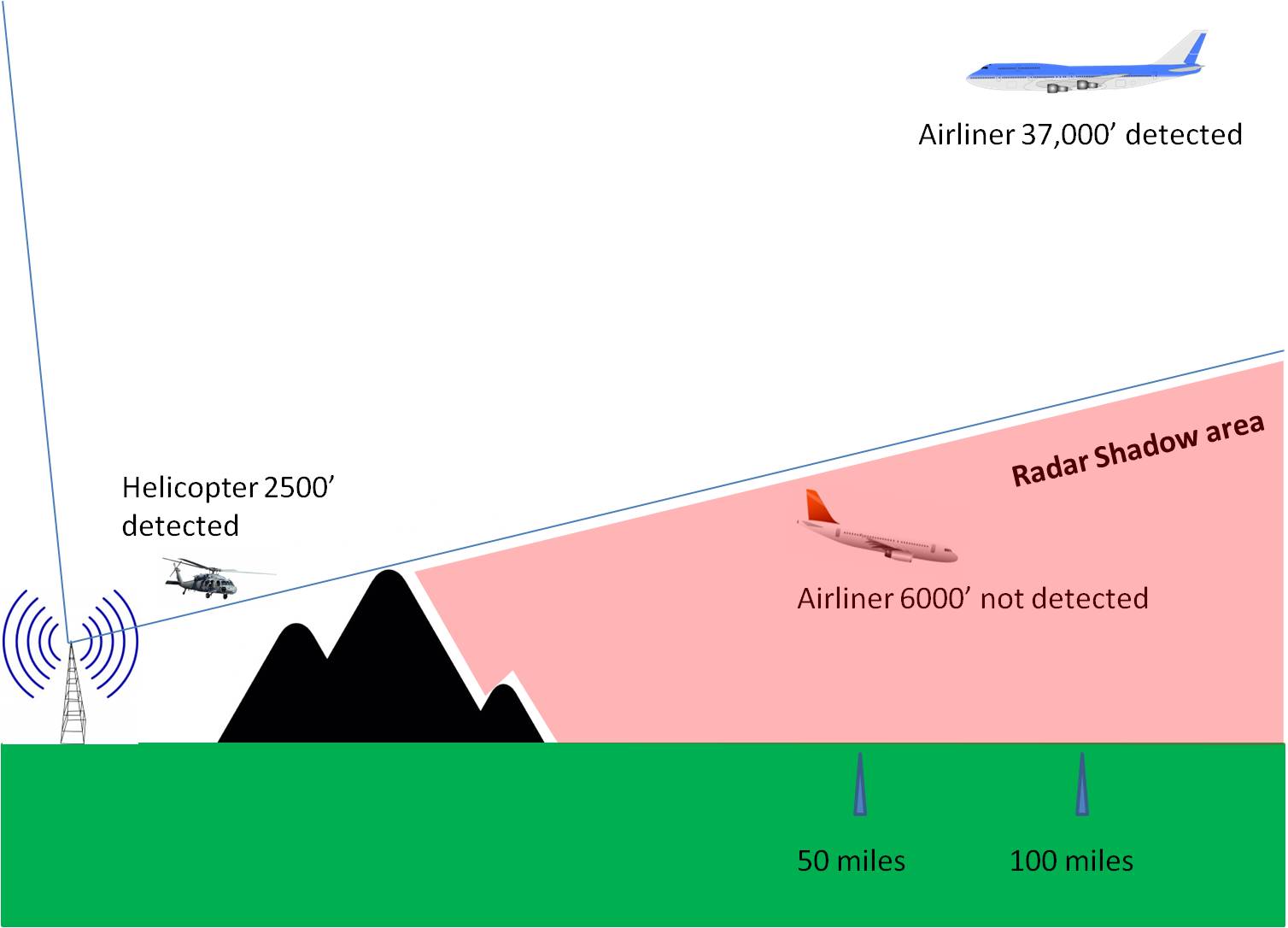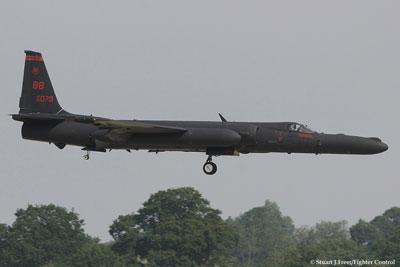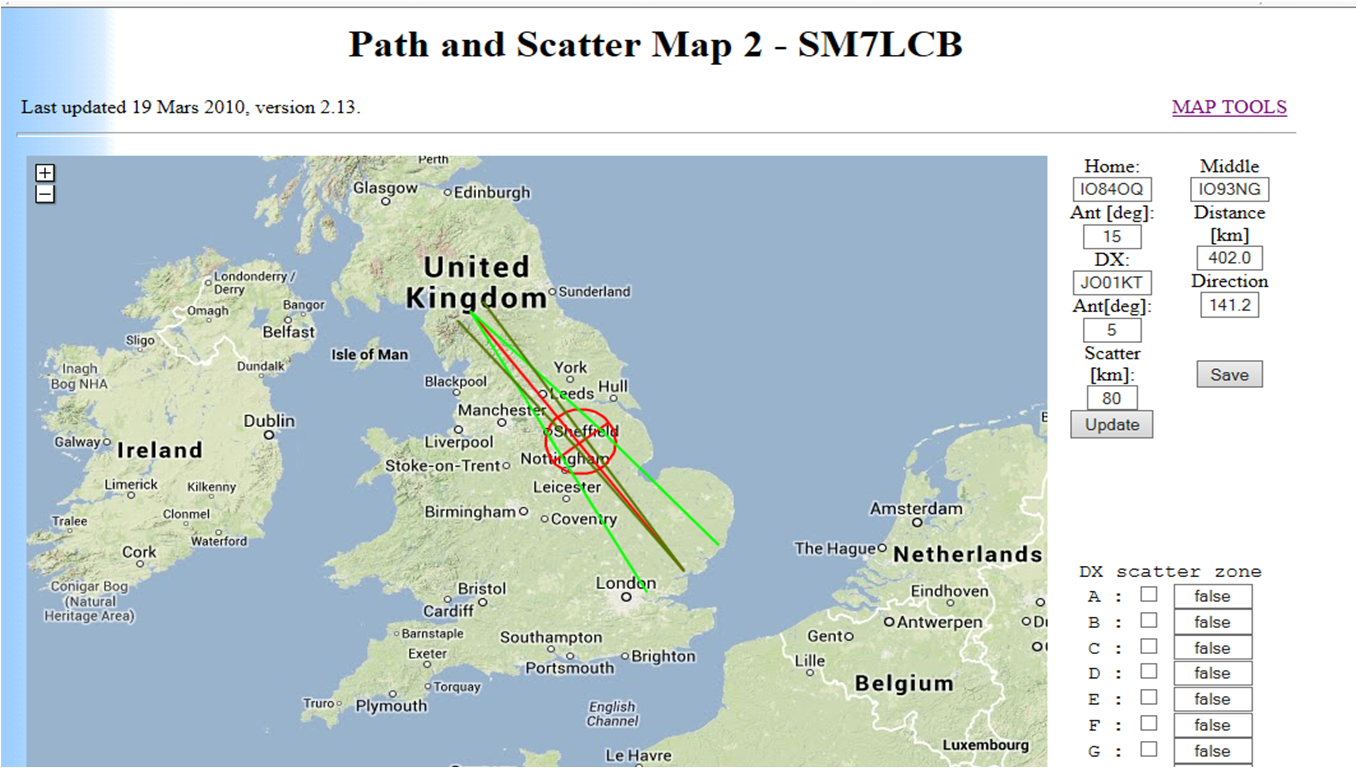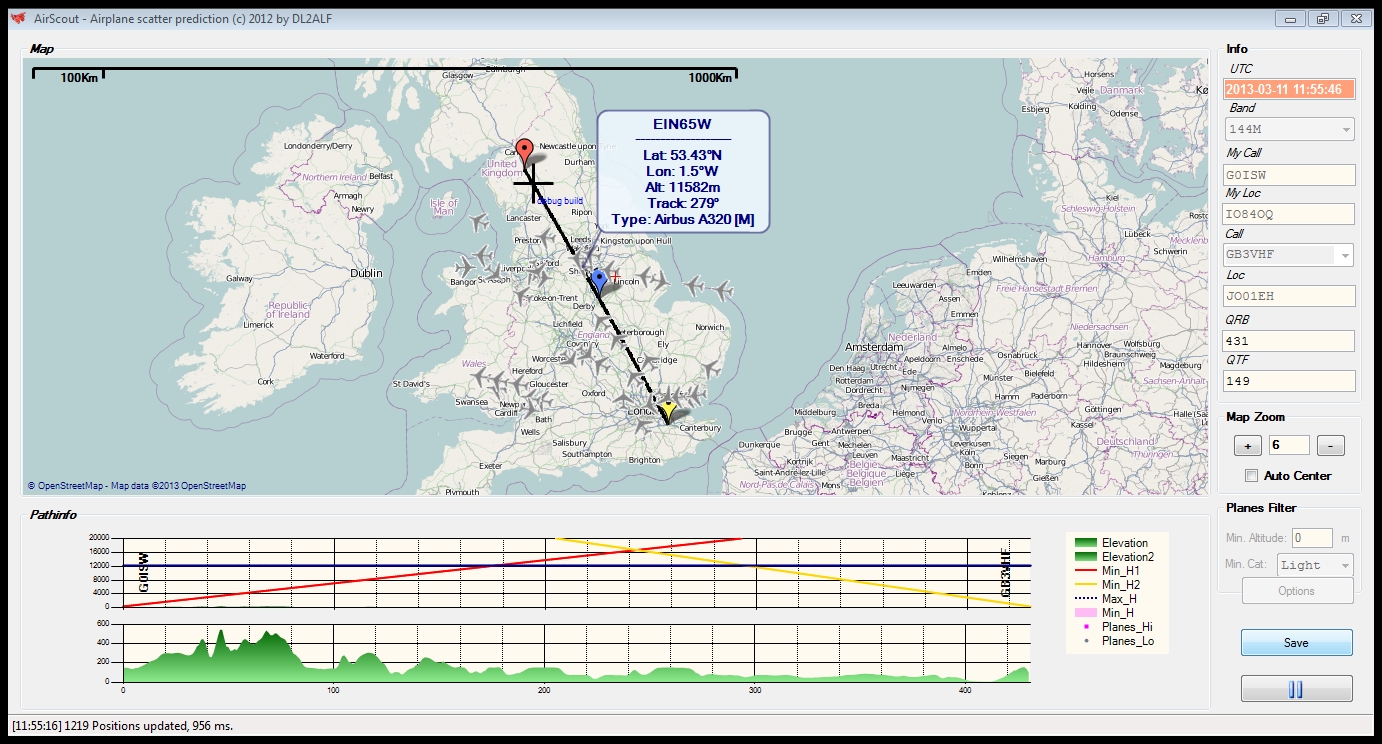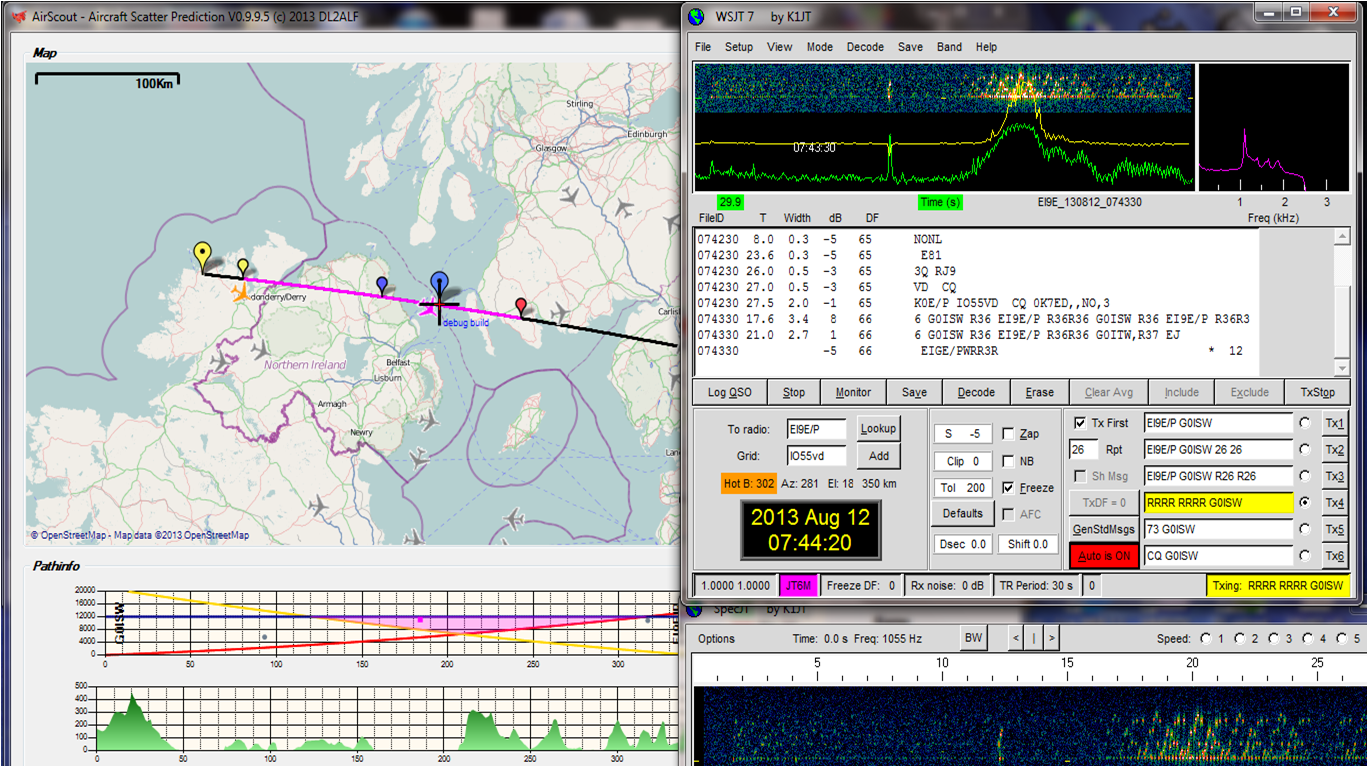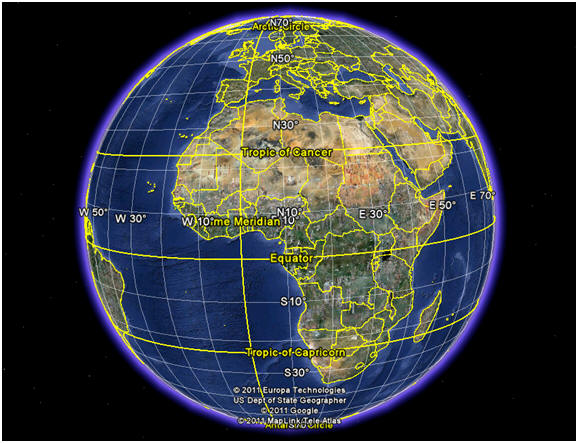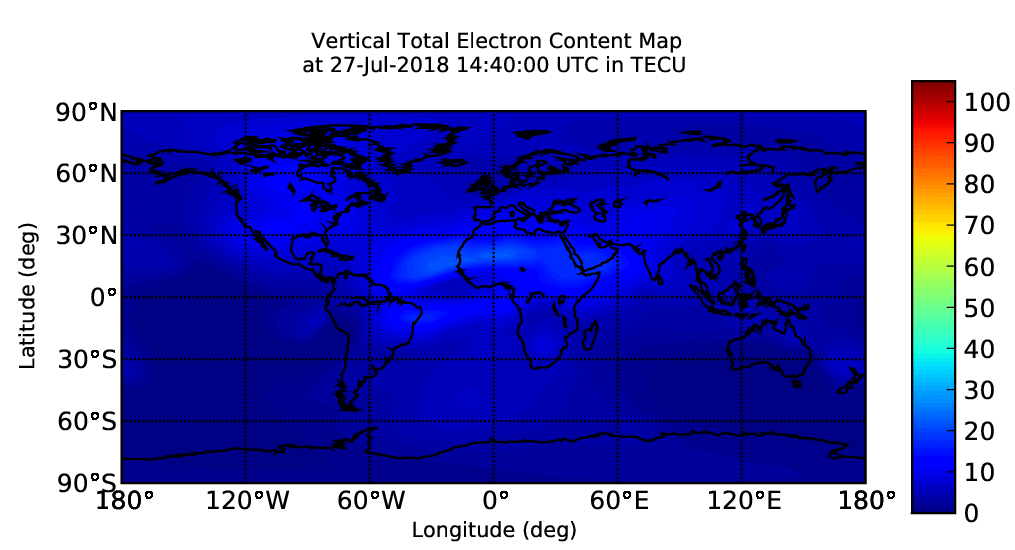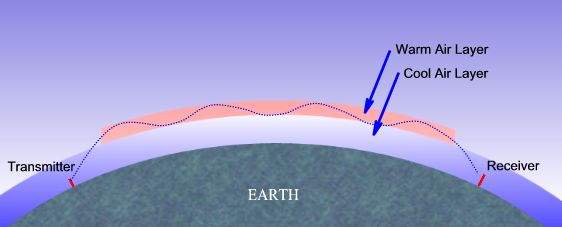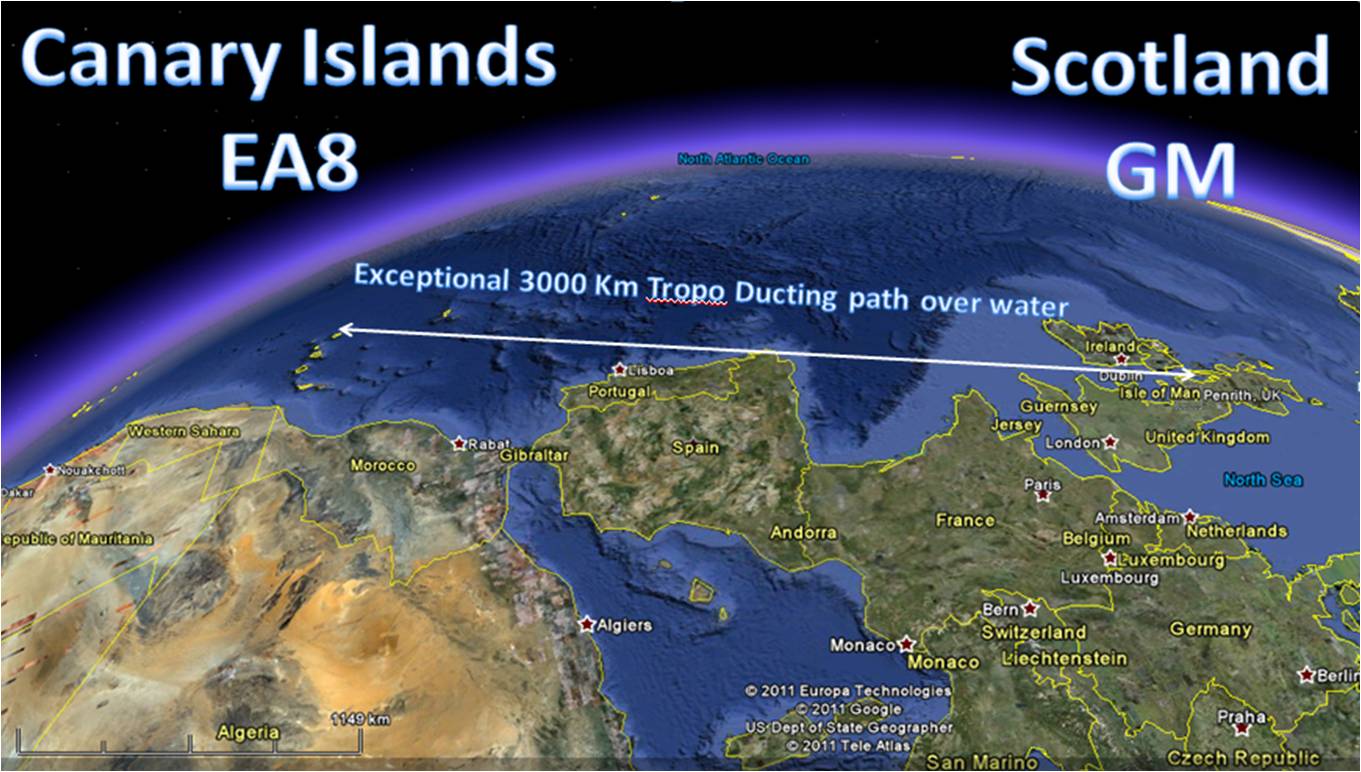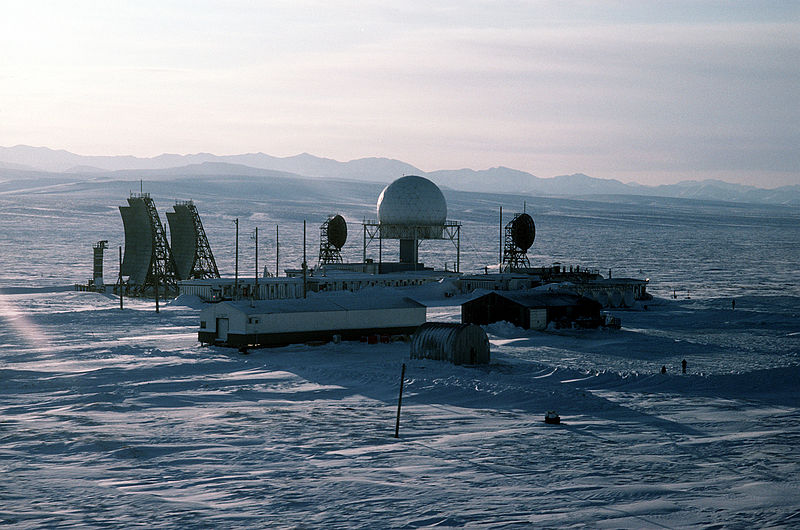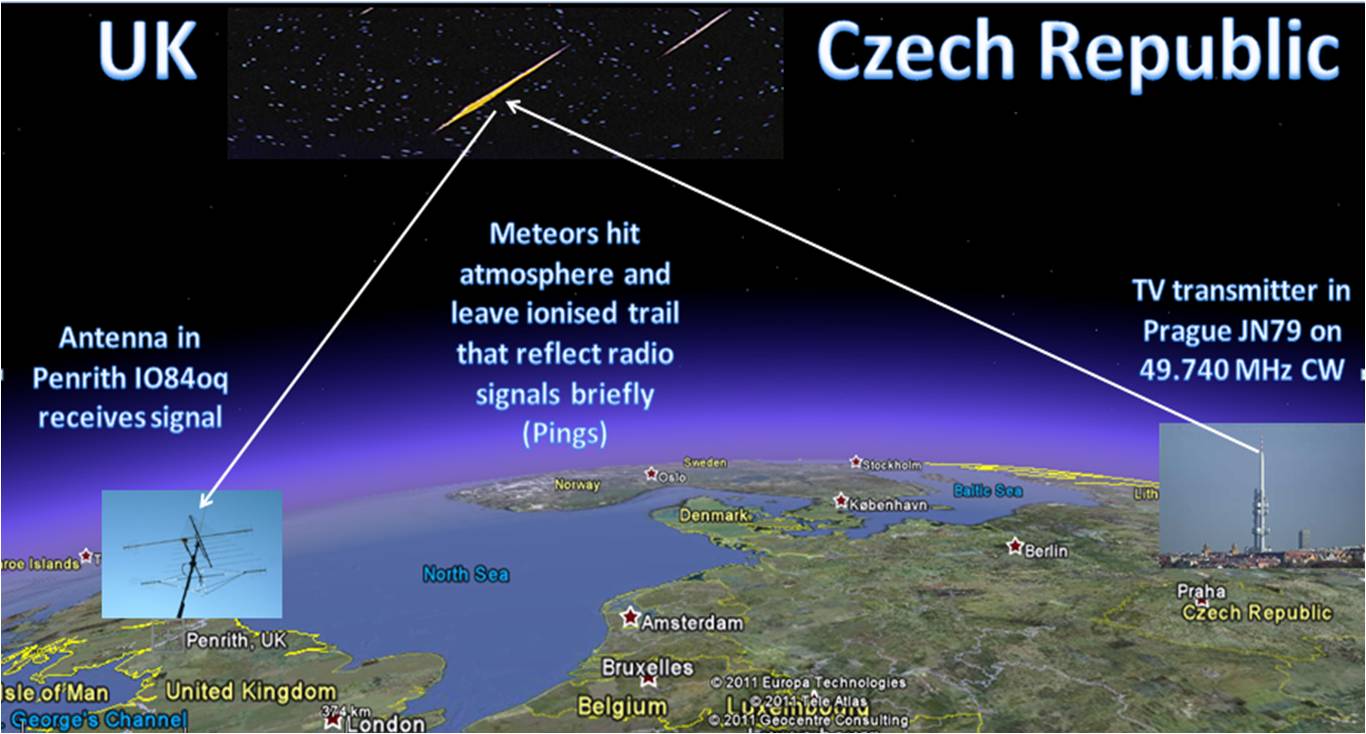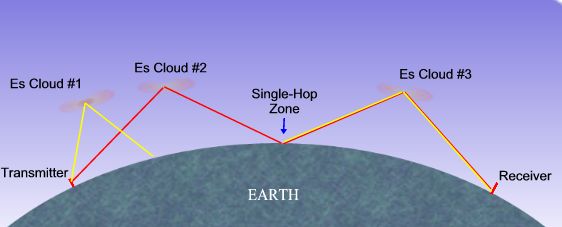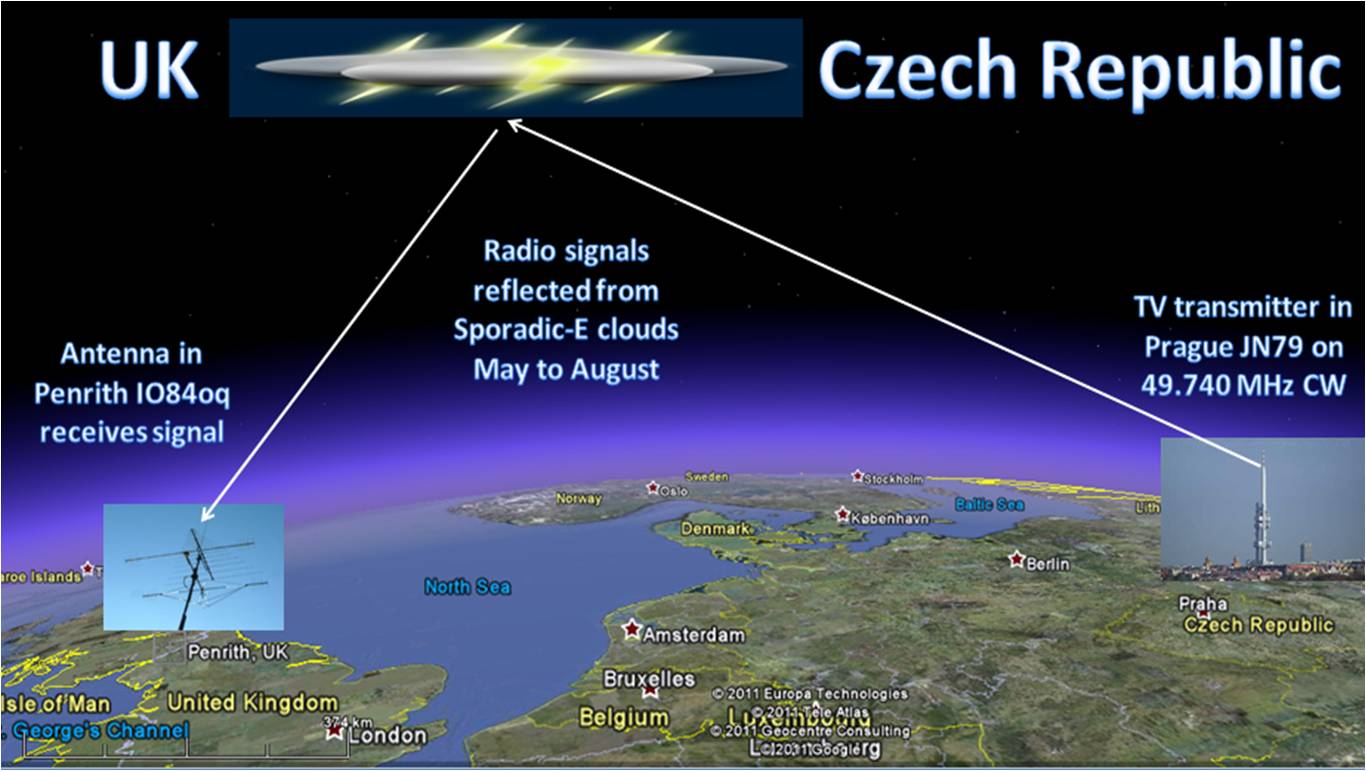|

By far the most exciting VHF propagation mode in my opinion is
Sporadic-E
which can magically appear for a limited time and allow long
distance (DX) VHF radio contacts to be made, often at high signal strengths by
even the most modest radio stations.
Sporadic-E
propagation, also known as
ES
propagation, is a type of atmospheric
phenomenon that occurs in the
VHF (Very High Frequency)
bands of the radio spectrum. It affects frequencies typically
ranging from
28 MHz
to
220 MHz,
which include several amateur radio VHF bands
and the FM
broadcast band of
87-108 MHz.
Sporadic-E
propagation is characterised by the
reflection and limited refraction of radio waves
in the E region of the ionosphere, hence
its name. The E region is located at an
altitude of approximately
90 to 130 kilometres (56 to 81 miles)
above the Earth's surface. Normally,
radio waves in this VHF frequency range pass
through the E region and continue into
space or propagate through other means,
such as ground-wave or Tropospheric
ducting.
However, under certain atmospheric
conditions,
Sporadic-E
clouds or patches form within the E
region. These clouds/layers consist of ionized particles, which can
reflect and refract radio waves. When this happens, radio signals
can be reflected back to Earth over long distances, allowing for
communication beyond the normal
VHF
line-of-sight range which is only around
50-100km.
The
Sporadic-E
clouds are not uniform in shape, size,
surface texture or orientation and are
constantly twisting and turning, so that
radio signals
being reflected or refracted from them
may be of any polarisation or
continuously changing polarisation.
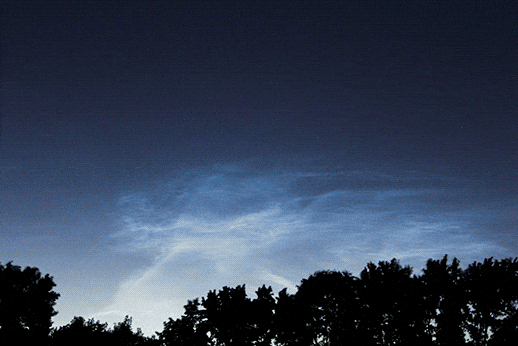
The formation of
sporadic-E
clouds is influenced by a variety of
factors, including solar activity,
weather patterns, and the composition of
the ionosphere. These clouds can appear
and disappear relatively quickly, often
within minutes or hours. They tend to be
irregularly shaped and can cover a wide
range of frequencies, leading to varying
propagation conditions for different VHF
bands.
Sporadic-E
propagation is often associated with
enhanced signal strength, long-distance
communication, and the possibility of
receiving distant television and radio
stations. It can result in unexpected
radio contacts, opening up opportunities
for amateur radio operators to
communicate with stations that are
usually outside their normal VHF short
distance range.
During periods of intense
sporadic-E
activity, multiple signals can be heard
simultaneously, leading to a crowded and
dynamic radio environment.
It is worth noting that
Sporadic-E
propagation is sporadic by nature,
meaning it is unpredictable and can
occur at any time of the year. However,
it is more commonly observed during the
summer months (May to August) in the northern
hemisphere, peaking in June. Monitoring the VHF bands and
staying alert to signs of
Sporadic-E
activity, such as sudden signal strength
increases or the reception of distant
stations, can help radio enthusiasts
take advantage of these unique
propagation conditions.
The exact conditions necessary for the appearance of
Sporadic-E layers have remained
mostly a
mystery until recent years where a gradual consensus is being formed, if likened to a recipe, the key ingredient always required
is
the
High Meteoric
metal deposition in the E-Layer
and intense
E-layer ionisation, with
the most intense solar UV radiation being at local midday
during the Summer months
(May to August)
in the Northern hemisphere.
Below
is a table of theorised
Sporadic-E required ingredients and
observed strong data correlation for the Northern hemisphere.
|
 |
|
|
50/70/90 MHz |
144 MHz |
|
Summer Es Main Season from May to August (Peak in June) |
Usual
main season |
Usual
main season |
|
High
Meteoric metal deposition rate |
Essential |
Essential |
|
Intense
E-Layer ionisation |
Essential |
Essential |
|
Ionospheric
vertical Wind Shear from the Jet Stream |
Alternative trigger |
Alternative trigger |
|
Atmospheric Gravity Waves (AGW) |
Alternative trigger |
Alternative trigger |
|
Solar Flares (M or X-Class/CME) |
Alternative trigger (0-4 days later) |
Alternative trigger (1-4 days later) |
|
Thunder
storms/-Lightning/Sprites |
Alternative trigger |
Alternative trigger |
|
Leonid Meteor Storm
(every 33 years) |
Alternative trigger |
Alternative trigger |
|
Intense
Solar UV Radiation |
Enhancer,
helps ionisation |
Enhancer,
helps ionisation |
|
Meteor Shower
|
Enhancer
for metallic deposition and ionisation |
Enhancer
for metallic deposition and ionisation |
|
Mountain
Ranges (Jet Stream interaction) |
Enhancer
for Wind Shear/AGW |
Enhancer
for Wind Shear/AGW |
|
Solar Kp index usually
needs to be <5 |
Kp:7 observed
12th August 2024 |
Kp:2
observed 6th August 2024 |
|
Daylight hours only |
Predominantly daylight hours, but can occur during darkness hours up
to around local midnight and very rarely beyond |
Theorised |
|
Capable of x2 hop
<4800km |
Yes,
seen regularly |
Yes
<3200km |
|
Capable of x3 hop
<7200km |
Yes,
Europe to USA
(seen up to 90.7 MHz) |
Never
observed |
|
Capable of x4 hop
<9600km |
Yes, Europe to Japan in mostly daylight paths seen on 50 MHz |
Never
observed |
T he
alternative triggers shown above don't necessarily initiate
Sporadic-E
every time, for example
vertical wind shear
from the
Jet Stream
can sometimes take as long as several days to build up the
required conditions for the formation of
Sporadic-E
clouds, depending on wind speed, continuity, direction and
interaction.
Thunderstorms
and their associated
-lightning/sprites
sometimes trigger
Sporadic-E
and often don't with
X-class solar flares
being the same.
Random Meteors
burn up in the
atmosphere daily, the highest daily meteor rates being at dawn
and during the Summer months when 3 times as much deposition
occurs as it does in the winter months.
Meteor showers
can additionally
generate significant further deposition enhancing the normal
daily rates, this can sometimes lead to much rarer
Sporadic-E
openings being generated during the winter months too.
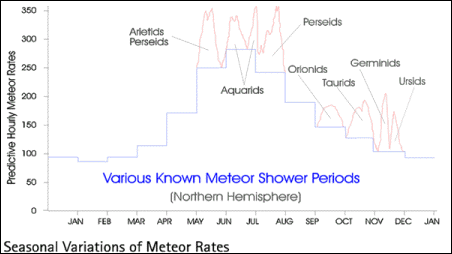
In
addition to random meteors there are regular Meteor showers
where greater numbers of meteors occur during specific dates,
see below.
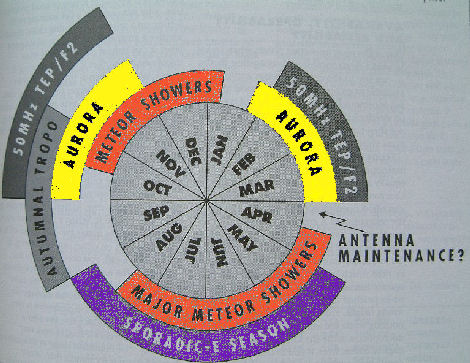
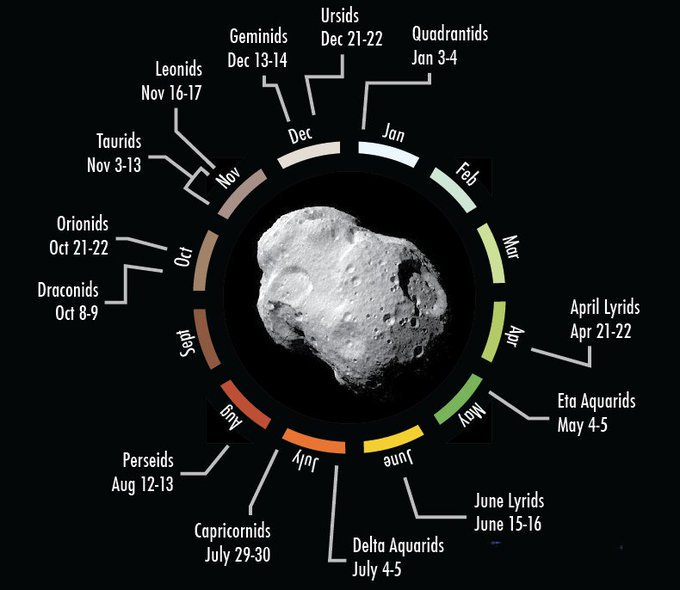
Extremely rarely these
Meteor Showers
can be so intense
(ZHR 1000+ Meteors per hour)
they are then classified as
Meteor Storms.
I have only ever witnessed this once on
19th
November 2002
during the
Leonids Meteor Shower when
over
2300 meteors per hour
were being recorded
in Europe from 0430 UTC.
Apparently this particular
Leonids Meteor Storm
occurs
every 33 years,
so will next be seen in
2035, but
between times the Tempel-Tuttle comet debris trail responsible
for the Leonids metoer showers will pass close to Jupiter and may be
adversely affected by its enormous gravity, as has happened before. In Europe
in 2002 the '1767 debris trail' was observed and later the same day in the USA the
'1833 debris trail' was also observed, there being two distinct and
separate debris trails from this Comet.
The
effect of this
19th
November 2002
Meteor Storm was that an absolutely huge
amount of metallic meteor deposition
and ionisation occurred
in the E layer, leading to a widespread European
Sporadic-E
opening on
144 MHz
that lasted non stop for around three hours, with very high
59+ signal strengths being observed.
I have
pondered over whether or not these radio signals on that day
should be classified as being via
Meteor Scatter or
Sporadic-E
and have come down on the side of
Sporadic-E. My rationale is that
Meteor Scatter
propagation outside of this event has a clear time duration
time measured in seconds or at most a few minutes. For there to be an
opening so intense and lasting non-stop for 3 hours, with no
audible indication of individual bursts or pings, associated
with MS,
it has to be categorised as being more closely similar to
Sporadic-E,
which also has the essential requirement of there being
significant metallic meteor deposition and ionisation. Other
scientific research papers on
Sporadic-E
have also made the same classification as me.
Below the famous engraving by Adolf Vollmy
of the November 1833 Leonids Meteor
Storm
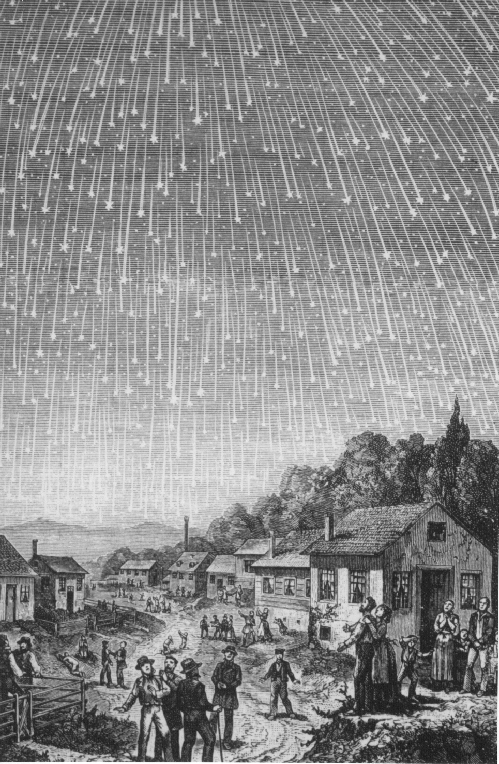
Below a
depiction of the November 1833
Leonids Meteor Storm over Niagara
Falls

Atmospheric Gravity Waves
(AGW)
can be produced by both
Thunder Storms,
rapid air flow
over Mountains
or
Jet Stream
instability.
Thunderstorms do not always initiate
Sporadic-E
nor do mountains have to be present as can be observed with
Transatlantic
openings.
There is significantly more VHF
ES observed
in Europe
than in the USA
every year, why is this? Well it appears it may be due to the
predominantly Summer season Eastward bound
Jet Stream,
which flows across the Atlantic from the
USA towards
Europe. It
causes
Wind Shear
and
Atmospheric Gravity Waves
(particularly when it hits mountain ranges),
which in turn travel vertically up into the E layer of the
atmosphere and cause the metallic particles from meteoric
deposition to be condensed, charged and moved vertically upwards
in tandem with the Earth's magnetic field, due to the
Lorentz Force
effect. This forms the up to 4km thick
Sporadic-E
layers in random locations, which permit reflection or
refraction of VHF radio signals. See the pdf linked below from
Flavio Egano IK3XTV

Observations over many years show
consistent repeating areas of European VHF
ES clouds in
the following locations:
Bay of Biscay, Pyrenees mountains, Balkan
mountains, Swiss Alps and to a
lesser extent the
North Sea.
Looking at the raised relief map of Europe
below, the mountain ranges thought to assist with Wind Shear in
these areas are clearly visible. The Polar Front Jet Stream is
what influences Europe and whilst it is moving in a prevailing
West to East direction pattern it buckles when warm air moves
further North than usual or cold air moves further South than
usual.

The jet stream regularly flows
over the
Spanish Pyranees
mountains thereby causing
ES to form
over the
Bay of Biscay.
However the precise direction of movement of the Jet Stream
depends on the weather, ES
in 2024 was noticeably poorer than normal and this appears due
to the Jet Stream being stuck much further South than normal
leading to poor Summer weather in the UK too. If the Jet Stream
moves and misses the mountains altogether then Wind Shear is
much less likely to occur and ES
becomes rarer.
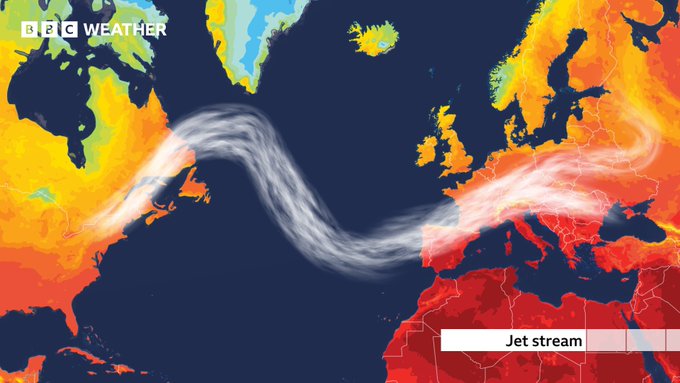 
In the image
below we can clearly see
144 MHz
ES signals
converging over the Balkan mountains
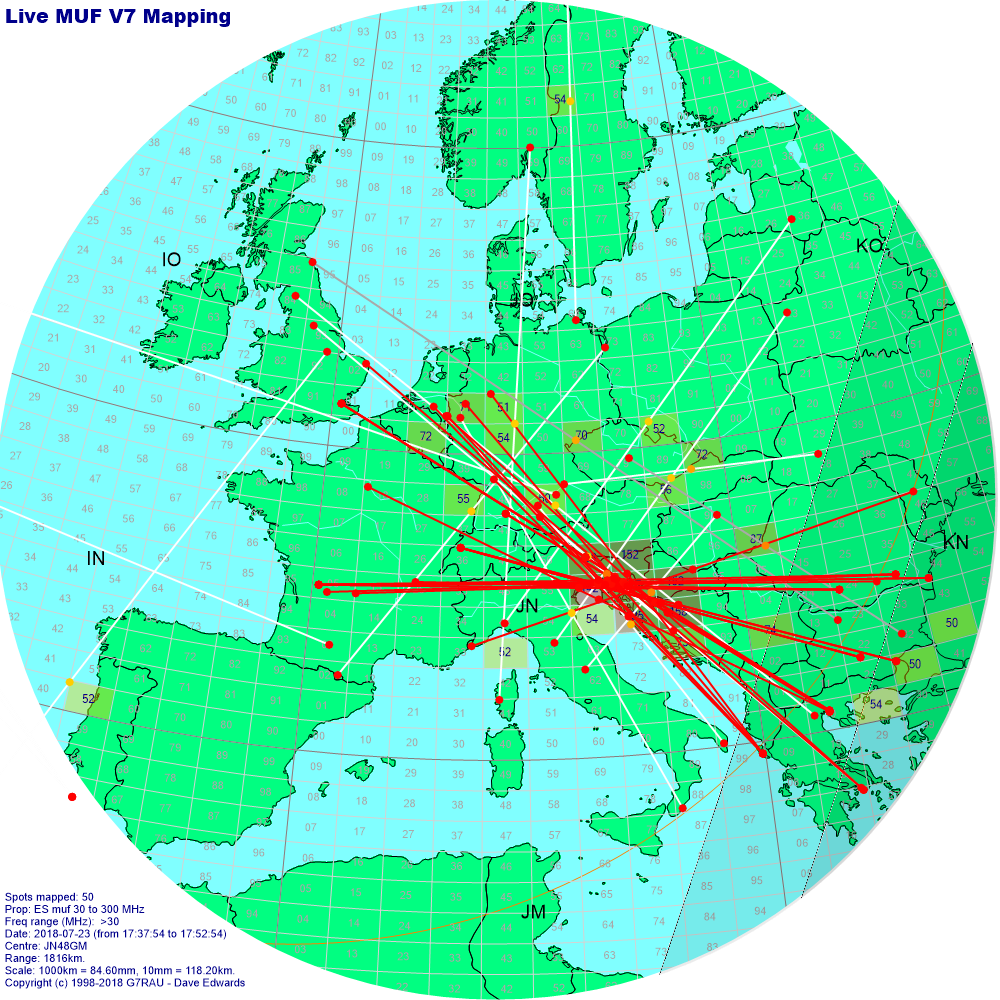
When there is no
wind shear available from the Jet Stream, or with no mountains in
the correct location, then catching
Sporadic-E on VHF can be problematic.
We can see on the
relief map of
North America below that the
significant mountain ranges
sit primarily on the
US West coast, over
which you would expect the Jet Stream to cause vertical Wind Shear
and VHF
Sporadic-E in the Summer months, the
problem is that radio stations are usually all located on land and anything
further West would be in the Pacific, so this explains why the
USA 'sees' far less
Sporadic-E than
Europe each year. However
thunderstorms/-lightning and X-class solar flares
can also trigger
Sporadic-E.

However
thunderstorms can generate Atmospheric Gravity Waves (AGW), which
can also initiate
Sporadic-E. Here is a good example from
the USA on
Tuesday 30th July 2024 where the middle
of the Broadcast FM
(87-108 MHz) Sporadic-E
paths shown coincide with the areas for thunderstorms that were
forecast.
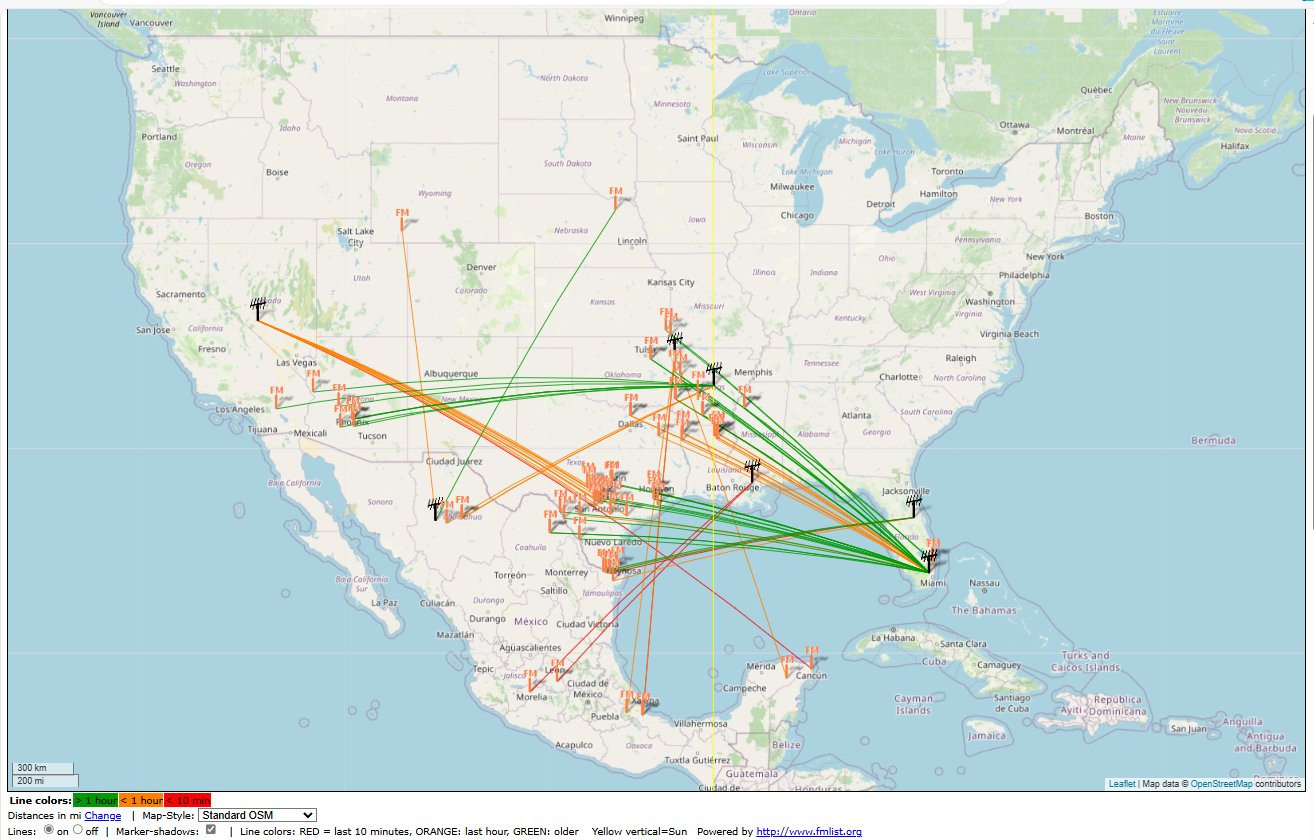
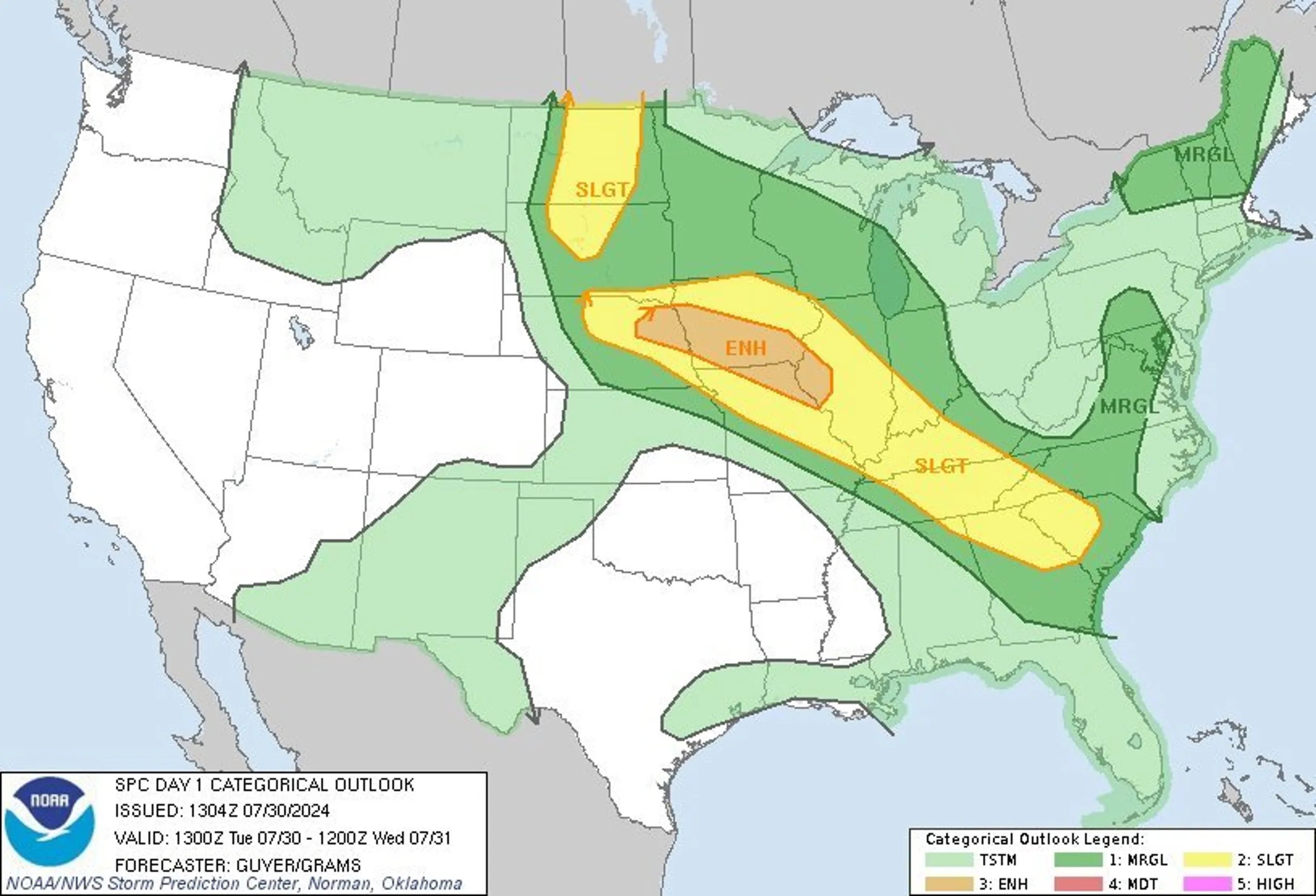
VHF
radio signals may be reflected from a steeper angle, where the
Sporadic-E
cloud MUF is high enough, or be
reflected usually at a shallower angle. If the
Maximum Useable Frequency (MUF) isn't high enough to support the
transmitted VHF frequency in use, then
the radio signal will pass straight
through the
ES
cloud layer.
These
ES clouds
are sometimes static in position or may move in a
particular direction, they appear to
often descend from their maximum peak altitude over time,
particularly at sunset.
Propquest by
Jim Bacon G3YLA
uses Jet Stream and other data to forecast the likelihood of
Sporadic-E formation in a visual format, right click on image below
to view current data.
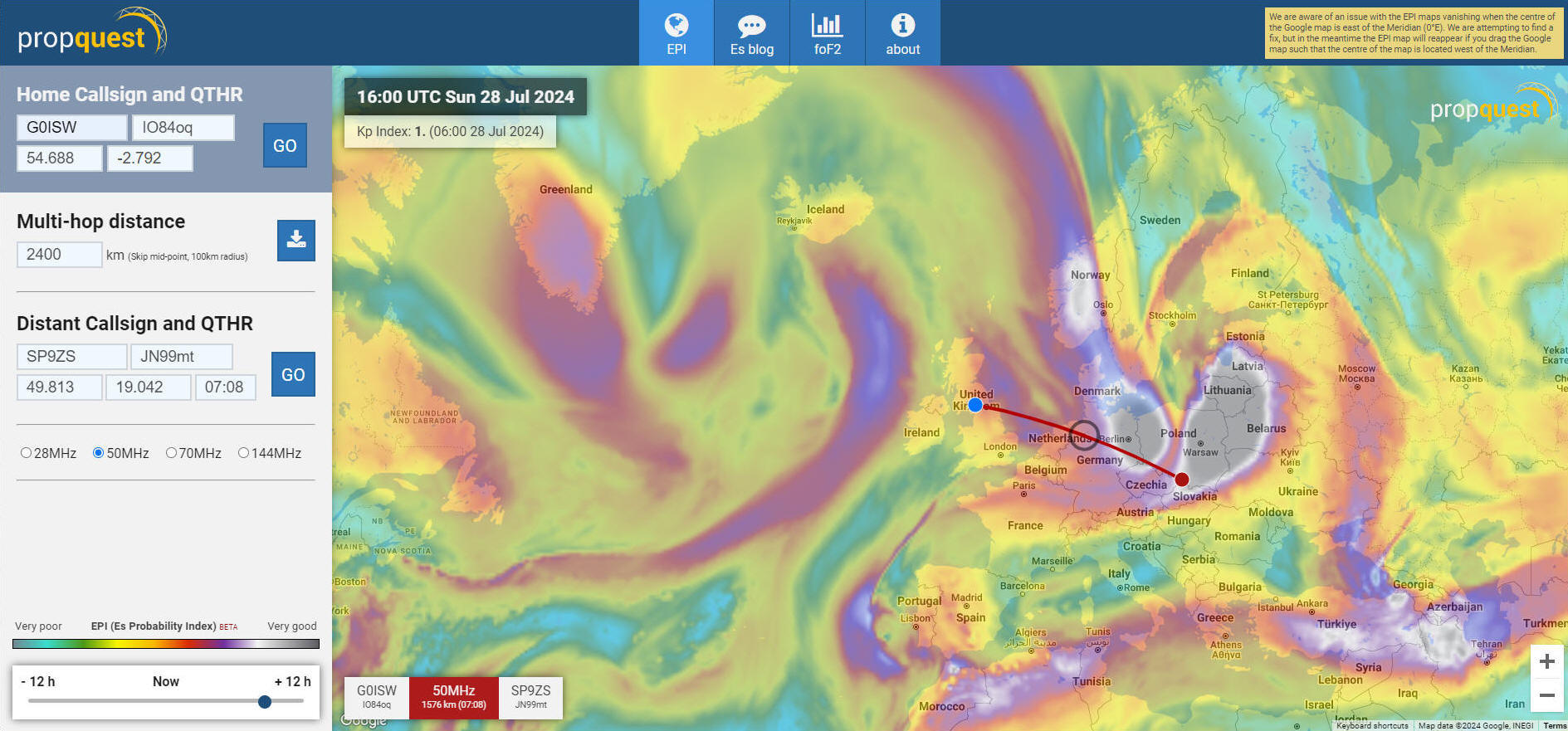
Signals can be
bounced from one
Sporadic-E
cloud to another, with many recorded VHF
signals at
50 MHz
bouncing between two clouds.
Due to the specific signal reflection
angles, at the time, the
ground areas able to receive them can be
quite specific, so a Radio Amateur in
one location may be working DX, but his
neighbour a mere
10km
away may hear nothing.
When viewed from above the area in which
two-way communication should be possible
via a
Sporadic-E
cloud can be described as looking like a
'doughnut'. The centre missing part of the
doughnut is the
Sporadic-E
cloud location and the main part of the
doughnut is the area in which stations
either side of the centre may be able to
reflect their VHF radio signals, if the
MUF supports the frequency in use.
If a
station is outside the doughnut, or
directly beneath the
Sporadic-E
cloud in the centre, they will be unable to bounce
their signals off it. An example is
shown below, courtesy of
FMlist,
where we can see two
Sporadic-E
cloud areas observed on the morning of
17th June 2023
in the FM Band II
87-108 MHz
frequency range.
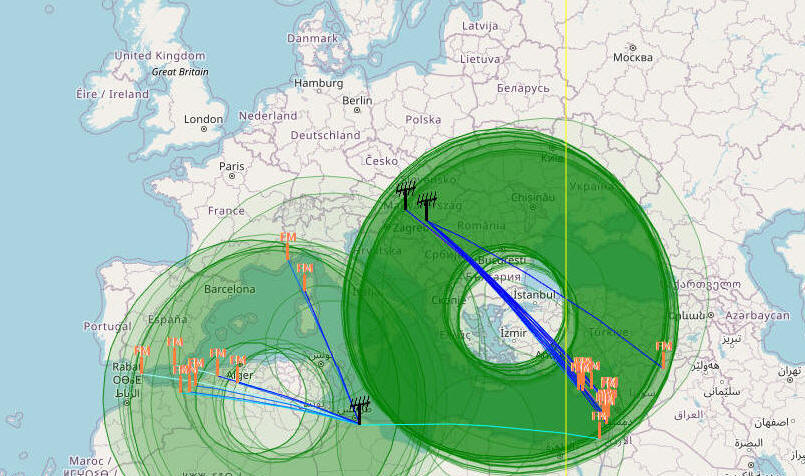
Sporadic-E
clouds support the reflection of VHF
radio signals at fairly shallow angles
of up to around 25 degrees,
the higher the radio frequency the
shallower the angle of incidence needed,
too high an angle or too high a radio
frequency for the MUF, will result in no VHF signal
reflection and the signal will travel
straight through the
Es
cloud into space.
All angles of antenna elevation for
Sporadic-E
propagation should be less than
<28 degrees
above
the horizon. For the very longest
Sporadic-E
distances, antenna elevation needs to be as close as possible to
horizontal
0 degrees.
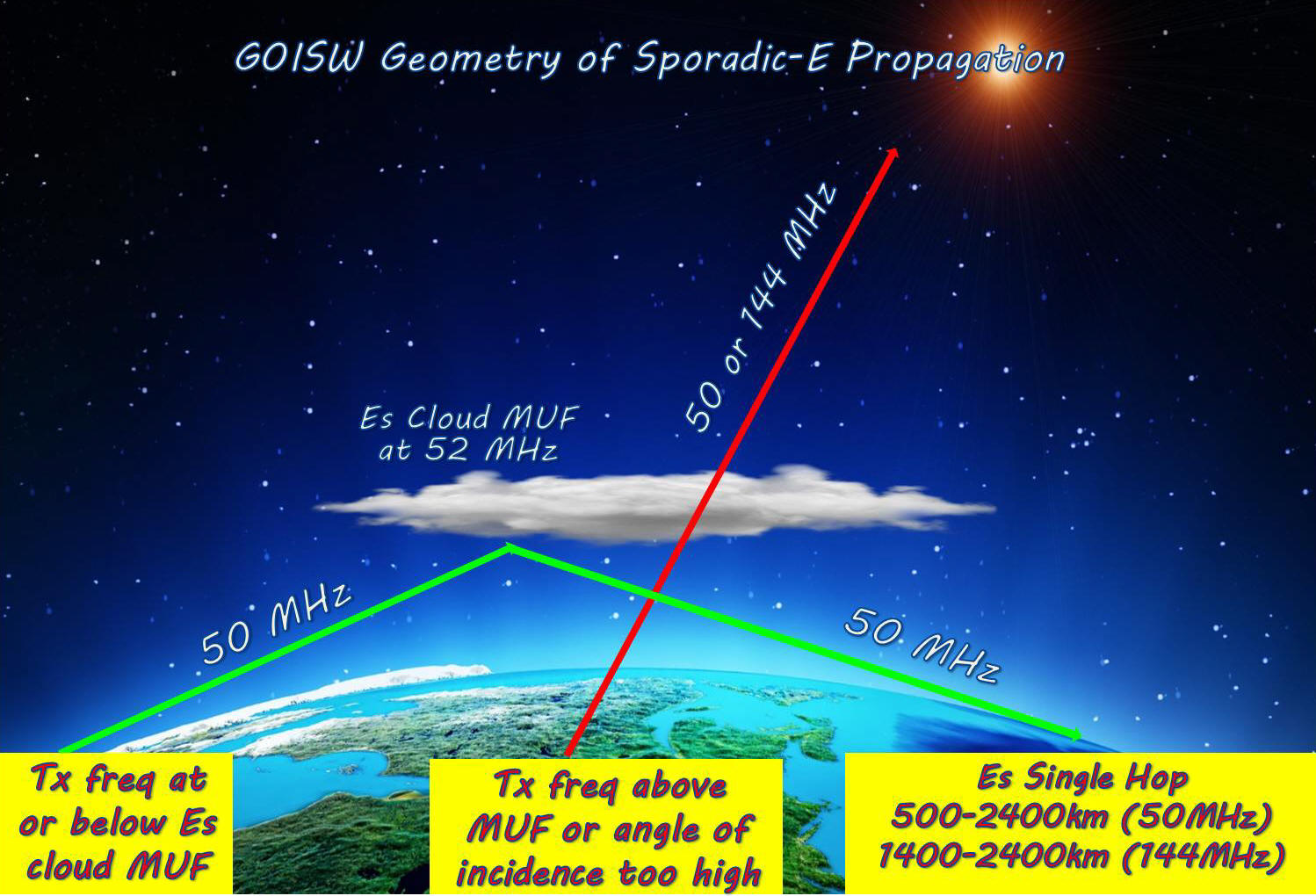
This means that the centre of the
'doughnut' referred to earlier is a
distance around a transmitting station
where
Sporadic-E
cannot be utilised. The minimum
distances observed for
Sporadic-E
propagation for
50 MHz
normally
is around
800km,
but with an exceptionally high MUF of
138 MHz or higher which support steeper
angles for
50 MHz signal reflection, the
minimum distance can exceptionally be as little as
400km.
This is for VHF signals within the
50/70 MHz
bands, but for higher frequencies such as
144 MHz,
the minimum distance is usually in the order of
1400km.
To put that
minimum
Sporadic-E
skip
distance for VHF signals into a visual context, let us superimpose the
exceptional
138 MHz
MUF minimum distance of
400km
radius
for 50 MHz
signals around my station located in
Penrith, Cumbria, locator IO84
almost at the centre of the
United Kingdom.
We can now
see clearly that with the exception of the England
South Coast,
Channel Islands, North coast of Scotland
and the
Shetland
Islands
it should be impossible for me, even with an unusually high MUF of over
138 MHz, to send or receive any
radio signals via
Sporadic-E
propagation with stations located elsewhere within the
United Kingdom
on 50 MHz
or higher frequencies. This is the hole in the
Sporadic-E
doughnut.
|
Sporadic-E
400
km 'doughnut' hole for my QTH - No
50 MHz
or
higher frequency
ES QSO's are possible,
even with extremely high MUF, anywhere within this minimum range circle |
|
 |
Let us not forget that the higher the VHF frequency the larger the doughnut
hole is, at
144 MHz
the minimum
Sporadic-E
hop distance increases to around
1400km,
the angle of incidence needs to be shallower. The map below shows this together with the maximum single hop (1xEs)
distance of
2400km.
We can see that unlike on the previous
50 MHz
map the size of the doughnut hole has significantly increased, so we can now no longer work on
144 MHz,
via Sporadic-E, Countries such as
Belgium, Netherlands, Denmark or Germany
as they are too close.
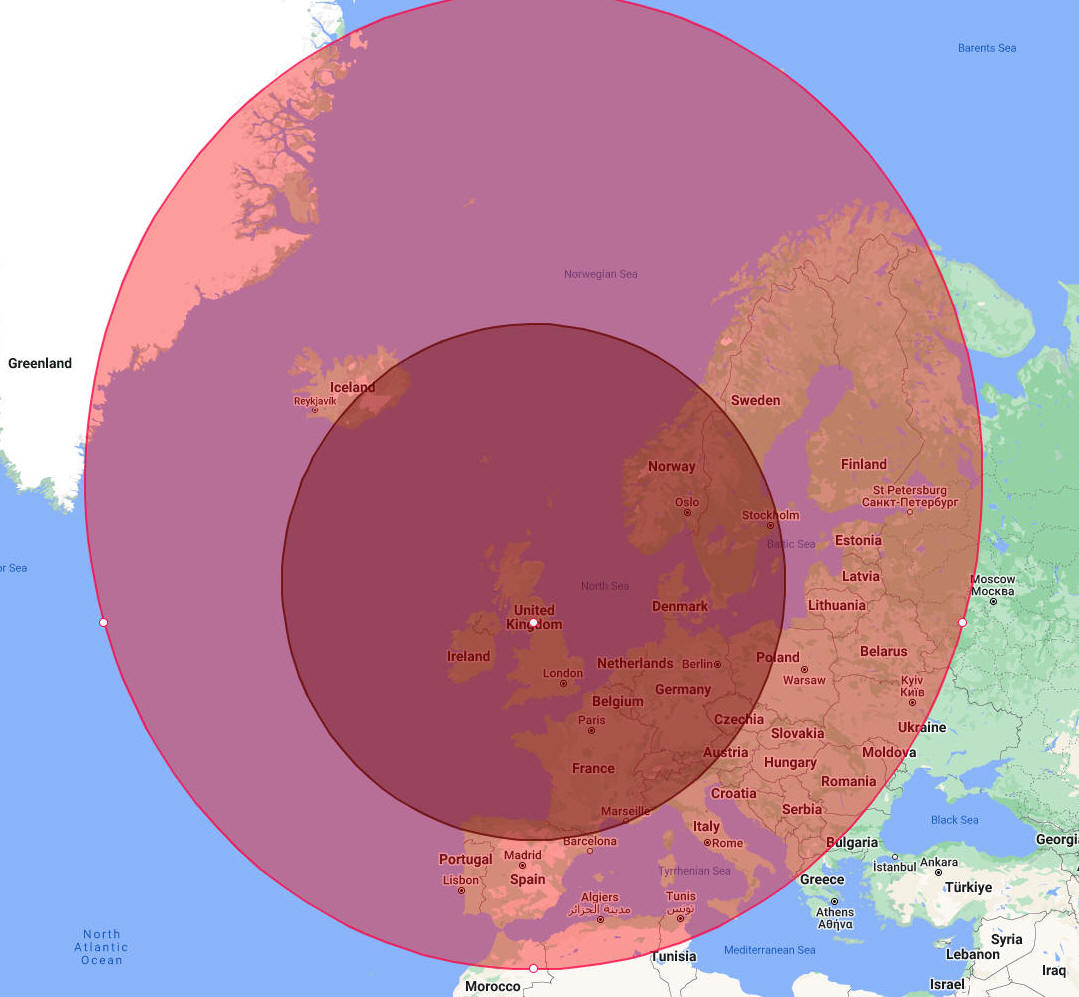
For the
400km
minimum
Sporadic-E
communication distance the following minimum MUF is required by band (calculations
made with
rauMUF software
by
G7RAU)
50 MHz
requires a MUF exceeding
134 MHz
70 MHz
requires a MUF exceeding
188 MHz
90 MHz
requires a MUF exceeding
241 MHz
144 MHz
requires a MUF exceeding
387 MHz!!
i.e. impossible for this short a distance, which is why the minimum
Sporadic-E
skip
distance for this frequency is
1400km.
Typical
Sporadic-E
propagation MUF observed by me online using the
G7RAU
Live MUF page, during the
May to July
2023
season,
has most often been in the range
50-60 MHz,
sometimes on a very few days reaching
95 MHz.
However on 14th May 2021 I worked several
70 MHz
stations at distances as low as
406km
with a MUF of around
186 MHz!
There had been a solar flare two days earlier and there was a widespread
opening on
144 MHz
the same day.
Shortest observed VHF ES
distances by band
50 MHz >401km 6th
June 2018 G0ISW IO84OQ to G3TXF IO71VE
MUF 134.9 MHz Elevation 27.6
degrees
70 MHz >406km 14th
May 2021 G0ISW IO84OQ to G8HGN JO01FO
MUF 186.4 MHz Elevation 27.3
degrees
90 MHz >603km
14th May 2021 Paul Logan IO64GG to BBC R2 Talconeston JO02NM
MUF
177.5 MHz Elevation 18.5 degrees
144 MHz >1481km
12th July 2006 G0ISW IO84OQ to EA3ESE JN01WR
MUF 159.5 MHz Elevation
5 degrees
The highest
frequency I can find online records for, showing the propagation mechanism to be via
Sporadic-E,
is for the
220 MHz
band in the
USA
back in
June 1987
Any shorter
than
400km distances observed on
50 MHz,
or higher frequencies, and considered at first to be possibly via
Sporadic-E
are most likely to be due to
Aircraft
Scatter (AS),
where VHF signals can be reflected at much steeper angles and shorter
distances, due to the large metallic bodies of the aircraft being
significantly better VHF radio signal reflectors.
The
MUF on
14th May 2021
was exceptionally high being at least
186.4 MHz,
the highest I have personally ever seen. Below is the Jet Stream for
that day showing significant wind shear in the area of the English
channel, where the purple and red zones meet. This Wind Shear
together with a significant solar flare two days earlier on the
12th May 2021
appears to have generated this incredible MUF.
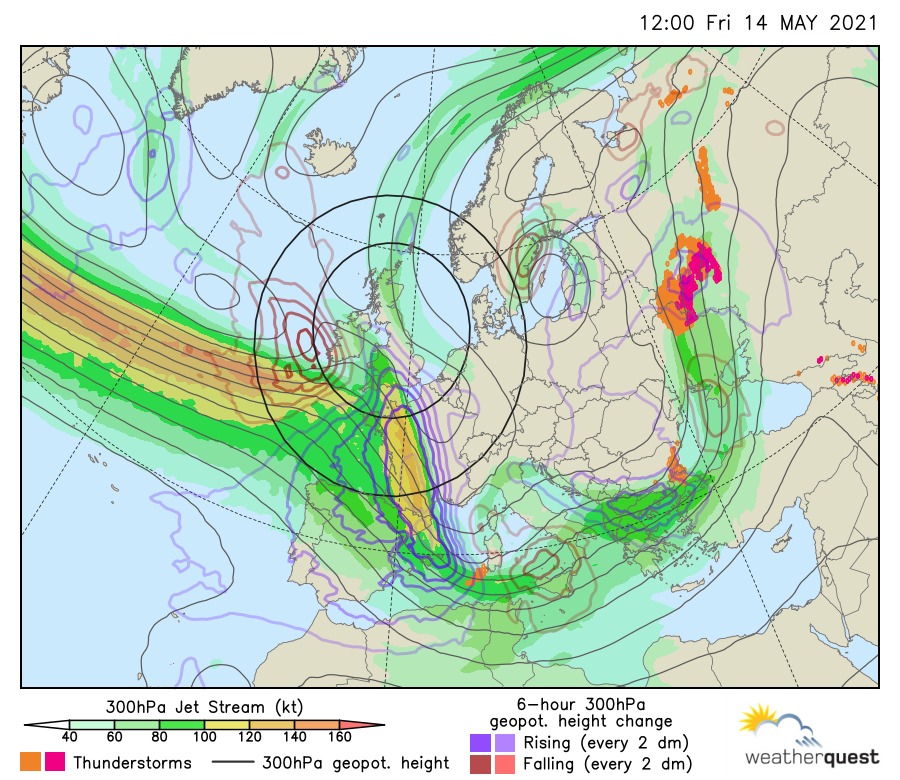
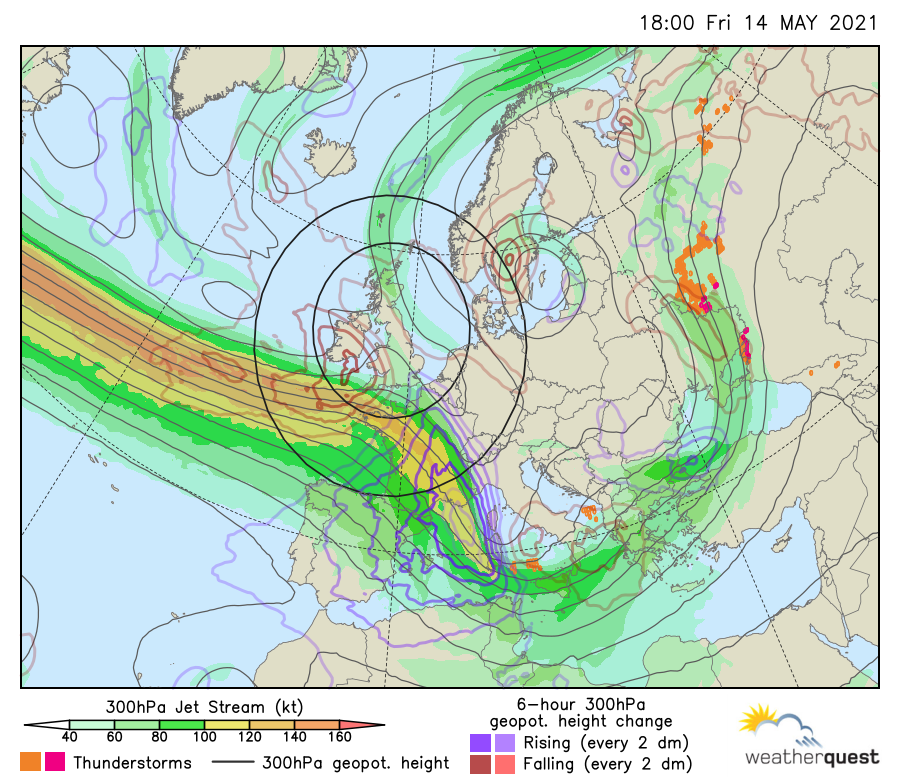
If we know the minimum single hop
Sporadic-E
skip distance is
400km
at
50 MHz
and the maximum single hop distance is
2400km, we
can use mapping tools
(https://www.mapdevelopers.com/draw-circle-tool.php)
to create our own
Sporadic-E
visual doughnut, below is mine. The dark
grey circle centred over the UK is the
400km
minimum hop distance area within which
no two stations can communicate with
each other via
Sporadic-E
propagation, as they are too close
together.
Due
to the map using Mercator projection of the Earth, the doughnut
shape is not perfectly circular at the outside edge. We can see that
all of Continental Western Europe is within single hop (1xEs) range,
as is a lot of
Eastern Europe, Iceland, North Africa and Scandinavia.

Let us now look at the maximum double
hop
(2xEs) Sporadic-E
distance of
4800km
superimposed over the same map, shown
below. This brings
Newfoundland, Canada
and some of the NE
US States
into range. It also brings into range
all of the Mediterranean Countries such
as
Israel, Turkey, Lebanon and Cyprus.
Double hop
(2xEs) Sporadic-E
is a quite common occurrence on
50 MHz.
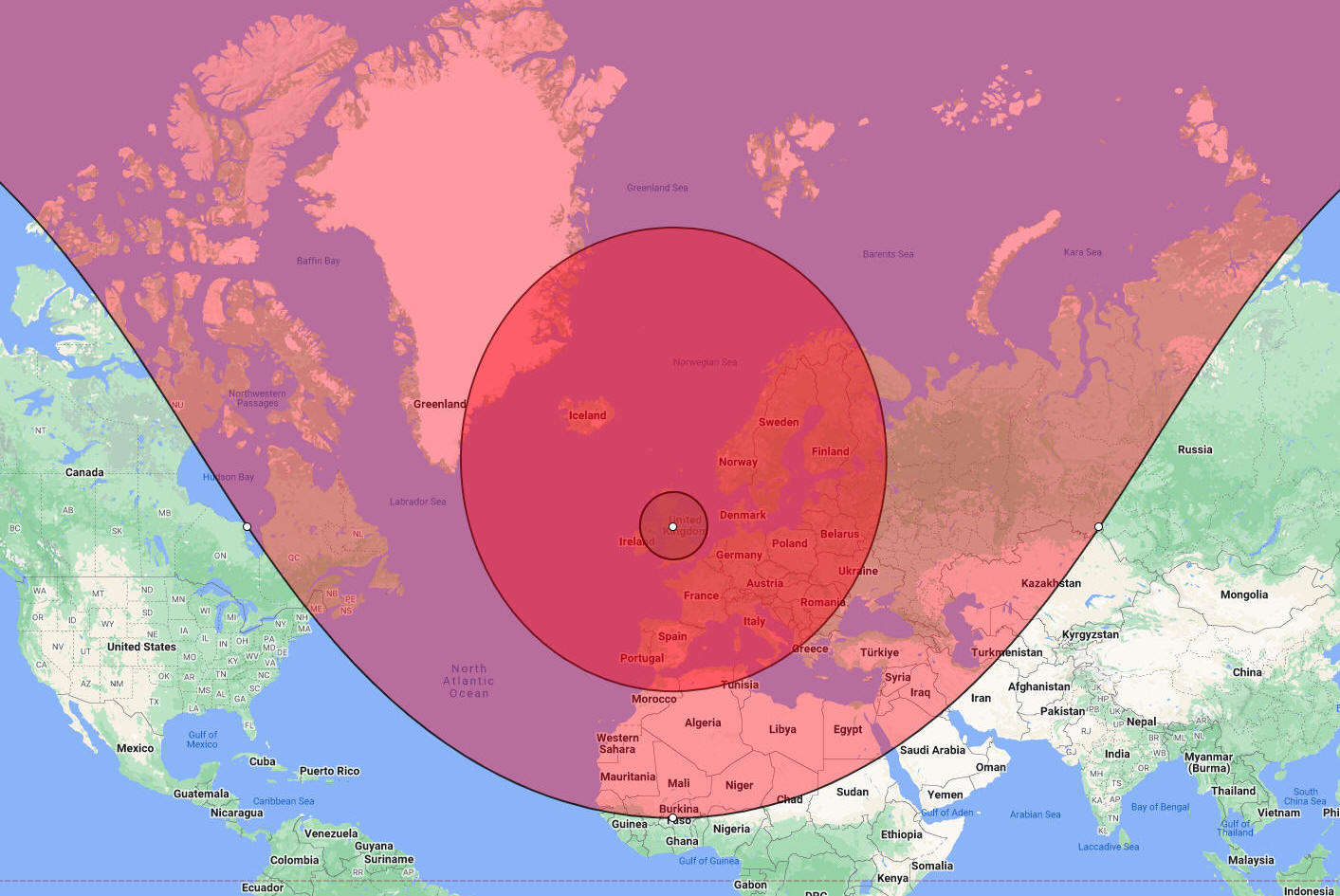
Finally let us look at the maximum
Triple hop
(3xEs) Sporadic-E
distance of
7200km
again shown over the same map, see
below. This brings into range much more
of the
USA, some of the Caribbean islands, such
as Cuba and just touches a small part of
South America.
Triple hop
(3xEs)
is much rarer, but does seem to show up
each year, particularly towards the
USA.
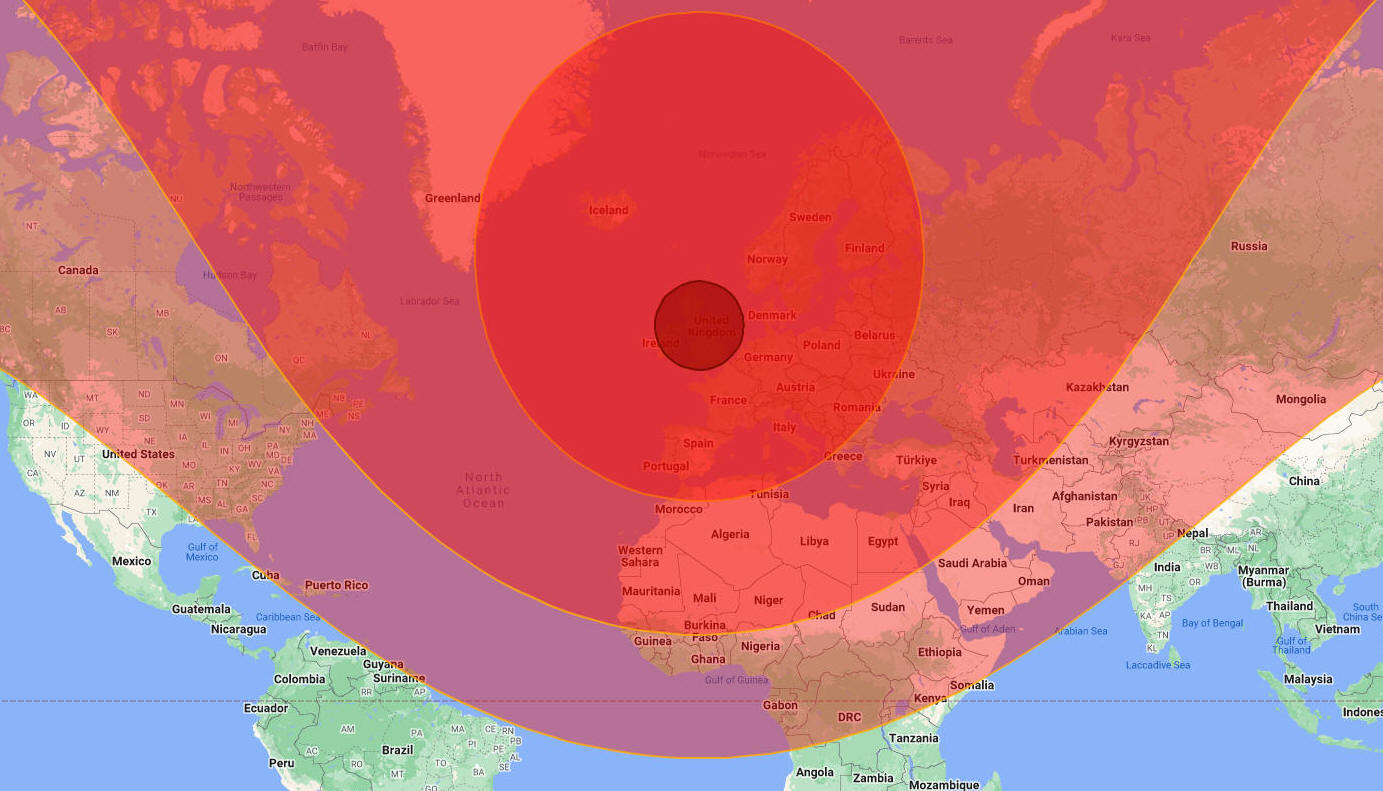
Sporadic-E
(abbreviation Es)
enhanced VHF radio propagation is just that,
sporadic yet present most days for several hours at a time during daylight hours on
50 MHz
usually most years
between May to August
in the Northern hemisphere,
peaking in June
sometimes with rare short duration openings supporting radio signal
reflections on frequencies as high as
144 MHz,
and with daily timings
over several years showing the greatest chance of
Es
being present between
11:00-12:00 UTC
and
16:00-18:00 UTC.
Sporadic-E
is observed on 144 MHz
less than 10% as often as on
50 MHz.
For
many years there have also recorded a much weaker and shorter
Sporadic-E
season around the Winter solstice (21st December)
when the intensity of the sun's solar radiation is at its maximum over the
winter months. I have only ever worked it a few times.
However in
2020/2021
things changed quite noticeably from previously recorded years, the usual
Es
season didn't end in August,
but carried on throughout
September, October, November, December and into January 2021
with at least 3 large European wide
Sporadic-E
openings each month on
50 MHz
workable even from here in the far North of England. I don't know if this is
because many more Radio Amateurs are using the weak signal data mode FT8 and
are able now to detect and work Es openings in a way that wasn't previously
possible with CW and SSB and/or is it because so many people are at home
monitoring the VHF bands due to Covid-19 lockdowns. Or is some unexplained
physical change in the atmosphere.
Excellent
Sporadic-E
144 MHz
events occurred in 1989, 2006, 2009, 2010, 2011, 2017, 2020,
2021 and 2022
which have been at both
maximum and minimum points in the 11 year sun solar cycle,
which demonstrates that is not a factor required for
Sporadic-E
to occur. For an excellent evaluation summary of
144 MHz Sporadic-E
from 2001 to the present day I highly recommend viewing the
MMMonVHF
website which shows you all the data collated and broken down into time, day, month,
year, quantity and Es
cloud positions.

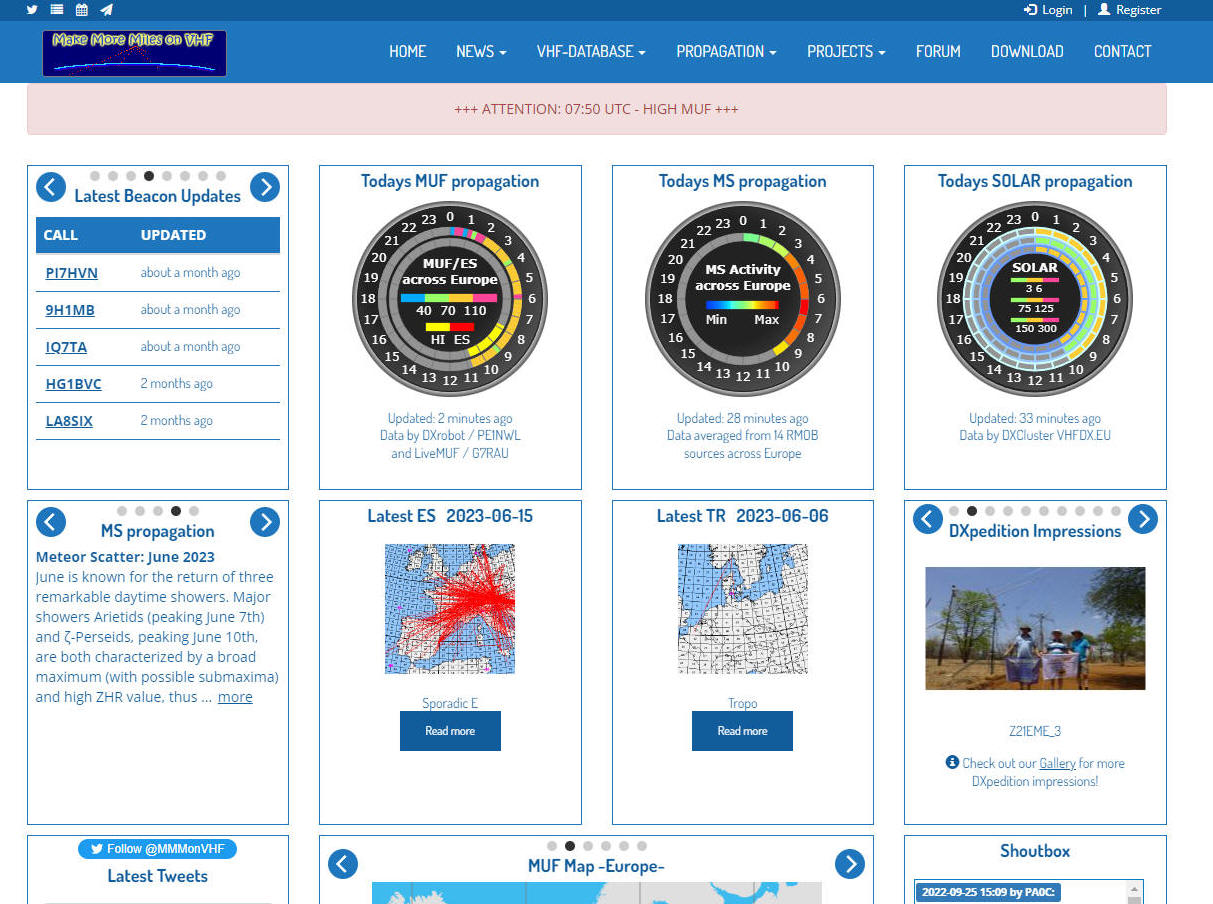
Another characteristic supported by my own live monitoring over nearly 40 years and
extensive collected data from DXcluster spots since 2001, in the Northern hemisphere for
European propagation, is that the vast majority of
Sporadic-E
reflection areas or clouds seem to occur mostly over the
Bay of Biscay, Switzerland and the Balkans.
Here in the UK it is probable on most days in Summer to work
Italy and Spain
easily on 50 MHz, it is much rarer perhaps 5-10%
of Es
days for the
reflecting Es
cloud to be situated over the
North Sea
allowing communication from the
UK to Scandinavia,
however when this does occur it is in this very marked direction.
Even rarer openings occur in the direction of
Iceland from the UK,
but several triple hop
Sporadic-Es
clouds do reasonably often open paths from the
UK to the USA
on
50 MHz.
Sporadic-E
(Es) occurs in the
Ionosphere at heights of between
90-130 km
(110 km average)
altitude and appears to concern strong areas of non-uniform and patchy plasma metallic ion
and electron density irregularities that cause VHF radio waves to be
reflected back to Earth by forward scatter. The metallic ions necessary are
deposited in the Ionosphere by daily meteor activity (heating and ablation)
even in the absence of major shower or meteor storm activity, the primary
metal types being iron (Fe) and Magnesium (Mg). The total metal ion density
determining whether or not the
Es
layer can support VHF signal forward scatter or not. The winds and electric
fields at these altitudes act to compress the ions into thin layers of
around 4 km
in depth.
There
are minimum distances for each band for propagation via
Sporadic-E,
lesser distances seen would be impossible by this propagation mode as the required MUF would
be simply too high and must therefore be by another mechanism such as
Aircraft Scatter
or Tropo scatter
etc. The minimum distances by VHF band are
shown below.
50
MHz minimum
Es
distance 800 km (exceptionally down to
400 km, but usually around 800 km)
70
MHz minimum
Es
distance 1000 km (exceptionally
down to 400 km, but usually around 1000
km)
144
MHz minimum
Es
distance 1400 km
The
minimum distances are important because if the angle of incidence is too
high and acute the MUF will not support the reflection and the VHF radio
waves will simply pass through the
Sporadic-E cloud layer and not be
reflected. The higher the frequency the shallower the angle of incidence
needs to be.
The
height of the
Sporadic-E
cloud relative to the Earth's curvature is also important. It has been
established that Sporadic-E
clouds gradually descend as time goes by during the day, before eventually
disappearing some time after sunset,
exceptionally lasting until midnight.
The
generally accepted Sporadic-E
heights are between 90-130 km (110km
average)
Research and published papers indicate that it is the daily ablation of
thousands of metallic meteors from all directions that are required, rather
than just intense meteor showers from single radiants.
During the Summer months there is approximately
three times more metallic meteorite deposition than in the winter months.
Sporadic-E occurs most notably on
the VHF 28 MHz, 50 MHz, 70 MHz and
144 MHz amateur radio bands
where the ionized E layer of the atmosphere at around
110 km altitude reflects
forward scatter VHF radio signals back
to Earth, rather than them normally travelling straight through the
atmosphere into space,
with received radio signals being extremely strong.
Monitor the VHF amateur radio bands and beacons and if
Es
signals are
exceptionally strong on a lower band such as
50 MHz
and at the lower end of the single hop distance range
(<500 km)
this can be a good indicator that
Es
will be supporting even higher frequencies, so consider listening up on the
70 MHz
or 144 MHz
bands too. If travelling in your car away from your shack try monitoring
87.6 MHz
FM on your analogue vehicle radio to see if you can hear
Es
broadcast station signals from outside the UK
(Tip from Dave Edwards G7RAU, thanks!)

Long distances
on 50 MHz can be
worked via Sporadic-E clouds at
altitudes between 90-130km
above the Earth's surface. Most of the rarer multi hop
Sporadic-E
events appear to occur between a maximum of up to three separate clouds.
Some extensive
144 MHz
very long distance Propagation Studies in Germany by
Dr. Volker Grassmann DF5AI
and Udo Langenohl DK5YA
include their theorised possibility of VHF signal reflections
from one Sporadic-E
cloud hitting the ground and being reflected back up to a second
Sporadic-E
cloud, where there are either large bodies of water, such as lakes
or rivers and even the theorised possibility of ground reflections from
railway track metal lines.
A separate paper discusses Thunderstorm effects
on Sporadic-E propagation at 144 MHz. Click on images below and open in new
tab to read their research papers.
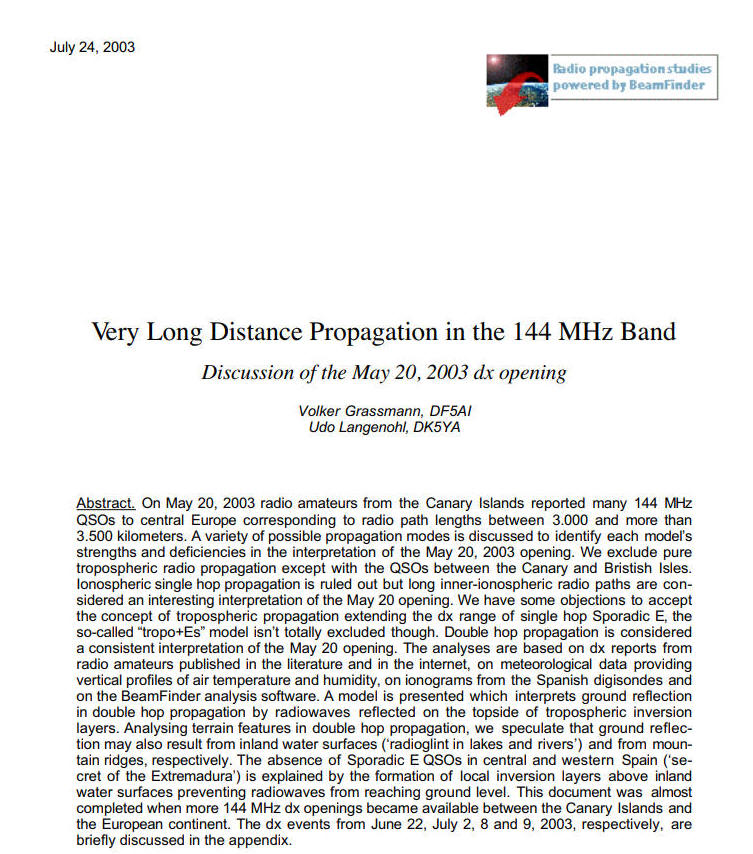
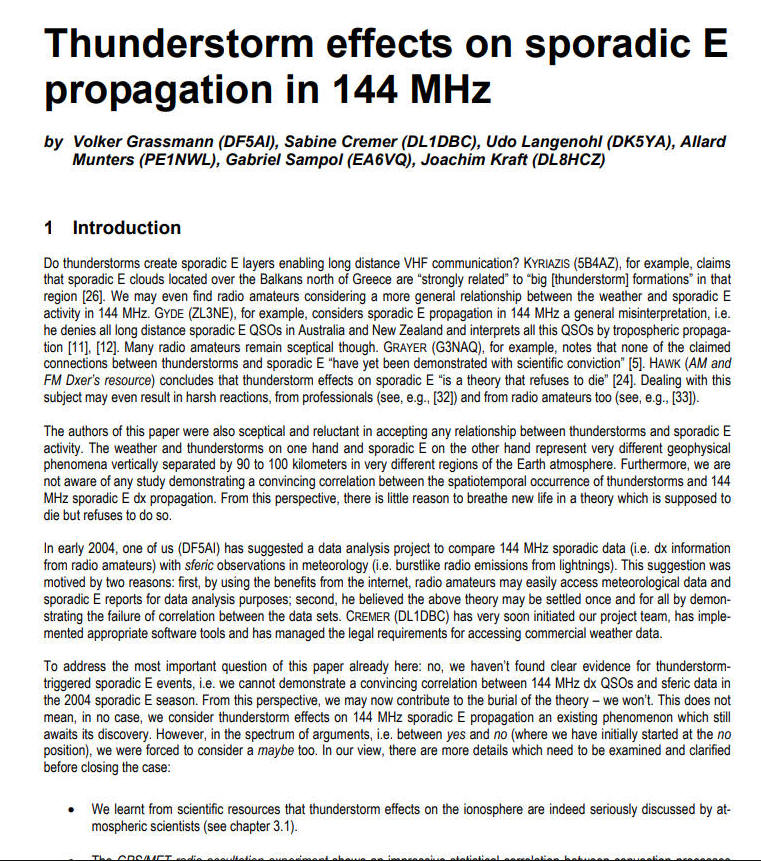
Single hop
Sporadic-E
400-2400 km
where the path is
Earth-Cloud-Earth
(exceptionally down to
400 km when MUF is near maximum)
Double-hop
Sporadic-E
up to 4800 km
where the path is
Earth-Cloud-Cloud-Earth
Triple-hop
Sporadic-E
up to
around 7200 km
where the path is Earth-Cloud-Cloud-Cloud-Earth.
(N.B. Triple hop
Sporadic-E
has been observed on
50 MHz,
90 MHz
(extremely rare from Europe to USA only recorded once), but never seen on
144 MHz
With the advent of special weak signal data modes
many more observations of the
triple hop Sporadic-E
are being observed on
50 MHz,
seemingly favours the path from Europe to North America.
Very rare quadruple hop Sporadic-E
(4xEs) on
50 MHz has been observed on a daylight path from Japan to Europe
in July 2023 after a 5.8 magnitude solar flare with SFI 214
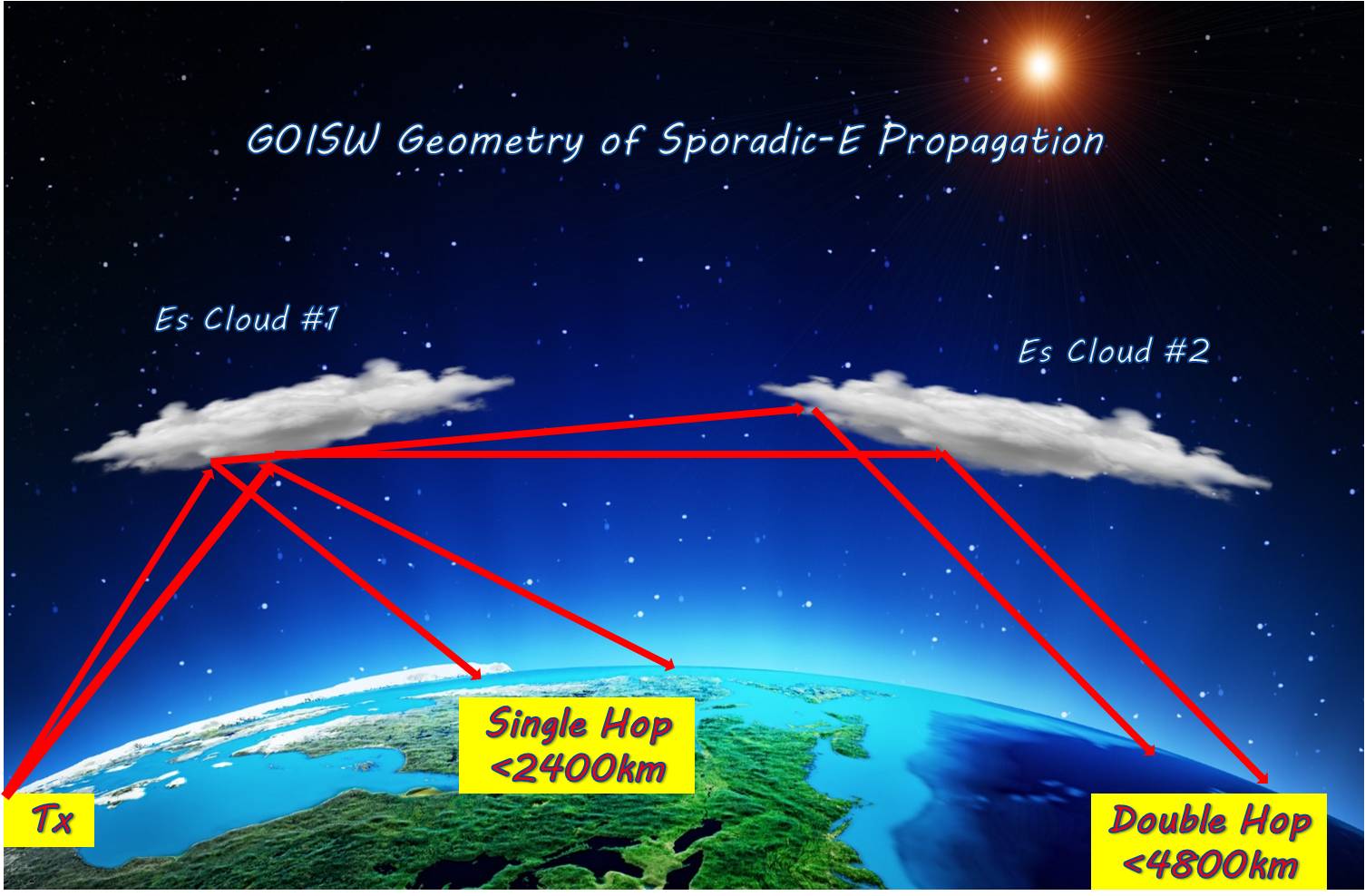
Distances
for VHF radio signals in excess of
7200 km are extremely unlikely to be
via Sporadic-E
alone, as the chances of more than three sporadic and random
Es
clouds all being in the perfect positions at the same time, in day and night
areas is almost zero,
instead look for Sporadic-E
propagation joining up with another Propagation mechanism such as
Trans Equatorial Propagation (TEP),
Meteor Scatter
or via
F2
propagation. F2
propagation supporting
50 MHz
occurs only near or during, the 11 year average, Solar Cycle maximum when the F-layer supports
refraction (bending) of signals at
50 MHz
from that much higher altitude layer, ranging in height from
200-500km, back to Earth
where they may bounce from the ground/sea back to the F-Layer again. This is
how it is possible to work Australia from the UK on
50 MHz.
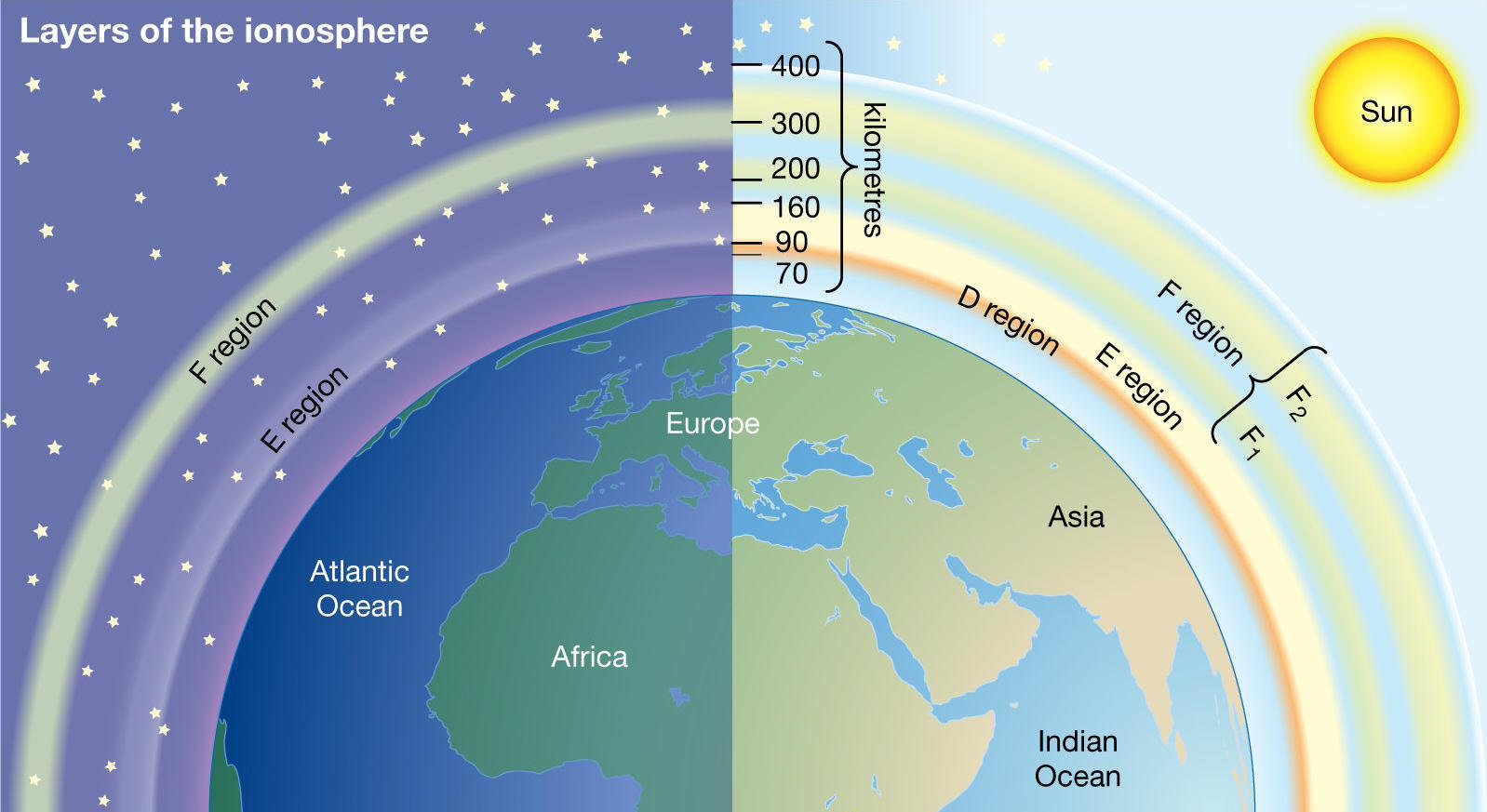
With any long distance
50 MHz
propagation the
polarisation of the transmitted VHF signal may be changed from horizontal to
vertical, or vice versa, after it is reflected or refracted by a single or
multiple Sporadic-E
clouds, indeed the signal should not be thought of a like a narrow laser
beam striking a mirror, but should be likened to a much wider car headlight
striking a corrugated shiny tin roof, with the reflected light or radio
signal scattered in multiple different forward directions. This can lead to
the VHF radio signal having differently polarised mixed components, or the
same polarisation, which
can become out of phase and create an unusual twisted 'barbers pole' effect
visible on the spectrum screen of SDR receivers.
Some
really good image examples of this twisted 'barbers pole' out of phase signal effect, which is particularly, or only evident, on double
hop
Sporadic-E,
have been kindly provided to me by
Paul
Logan from Fermanagh, Northern Ireland,
who is a very active and well known Broadcast FM DXer on Twitter
@FMDXIreland
as observed by
him in the frequency band of
87-108
MHz. The twisted 'barbers pole' out of
phase signals at 2800-3000 km
distances, shown in the images below, stand out as clearly different from the
single hop Sporadic-E
distance stations signals, that do not have the
twisted barbers pole effect visible.
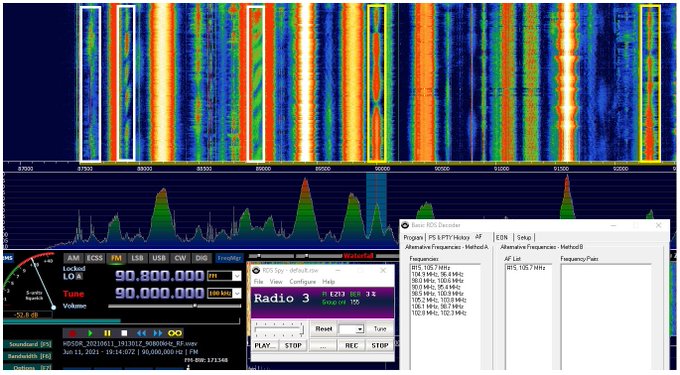
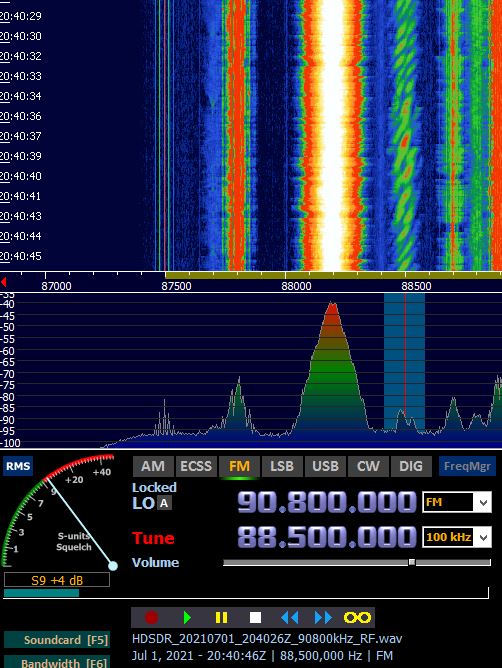
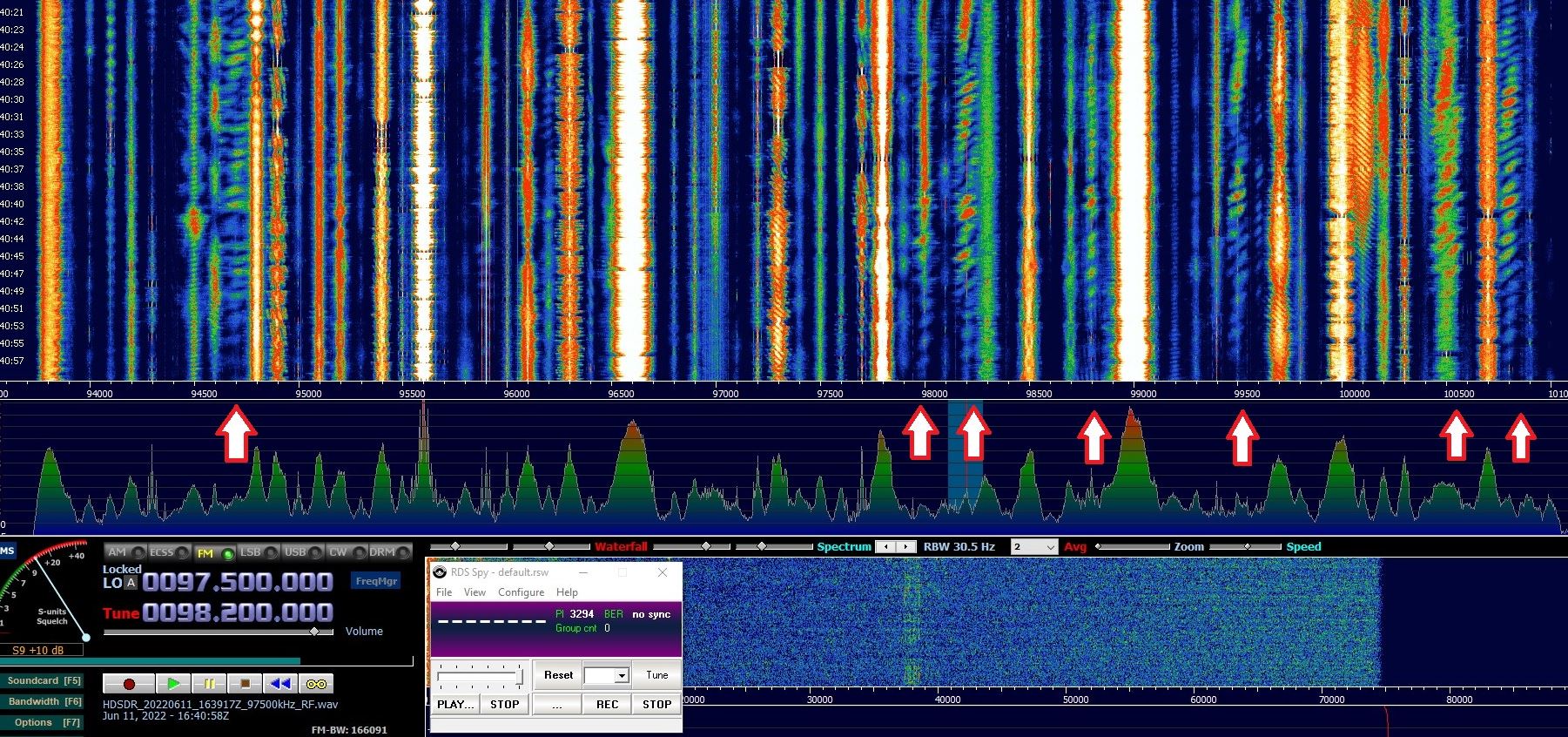
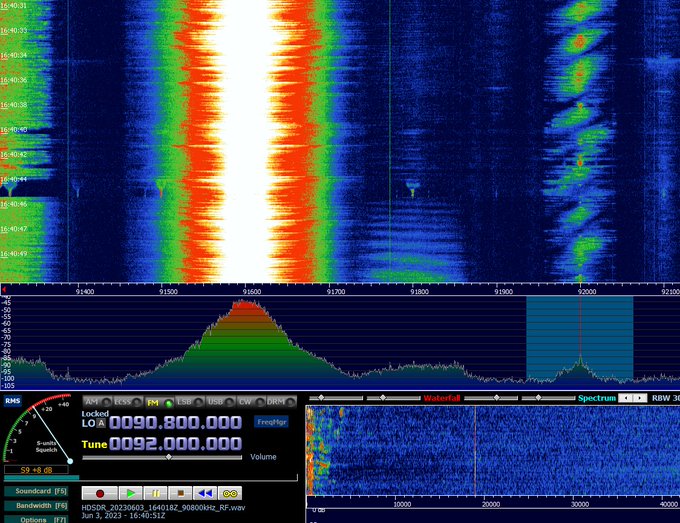
Whilst on the subject of FM DX in Band II
between 87-108 MHz
the fantastic website of
FMList
has a
visual mapping system showing in real-time
DX spot paths via Sporadic-E,
which reveal readily Es
skip 'doughnuts', with the missing centres being the approximate location of the
Es
clouds. As can be seen in the image below, dated
17th June 2023
at 1000 UTC, where two separate simultaneous
Sporadic-E
clouds can be visually observed.

Single hop
Sporadic-E
is routine, double hop considerably rarer and triple hop rarer still, as
all the clouds must perfectly align and be at the right heights and with
sufficiently high MUF to support such high VHF frequencies.
Triple hop
Sporadic-E
signals in Band II VHF
frequencies 87-108 MHz
are extremely rare
On
26th
June 2009 Paul Logan from Lisnaskea, Northern
Ireland IO64GG had triple hop Sporadic-E
reception on the Broadcast FM band from eight US States and one Canadian province. The
most distant signal received was that of WVAS
radio in Montgomery, Alabama, USA on
90.7 MHz at a distance of
6456 km (4012 miles).
The reception was recorded and later confirmed by
WVAS newsreader Marcus
Hyles.
On
5th July 2022 Bryce Foster (K4NBF)
Co-host of the
VHF DX podcast
received a triple hop
Sporadic-E FM signal on
87.8 MHz
from Portugal to Cape Cod, USA

I have found strong
Sporadic-E
stations within 87-108 MHz
can be heard and received here in the
UK
from
Spain, often
accompanied by openings on the Amateur Radio
70 MHz
band, but sometimes without
any 70 MHz
Amateur Radio stations being heard. I can only put this down to the
transmitter powers of the FM Broadcast stations being often measured in many
kW and therefore with magnitudes higher ERP.
This also used to be the case
when the old Band 1 TV transmitters
47-68 MHz
were heard easily in the
UK
from
Spain,
before any openings were received on the Amateur Radio
50 MHz
band due to the difference in ERP levels. This was via
Meteor Scatter or Sporadic-E.
Unfortunately the Band
1 TV transmitters in Spain have all since closed down.
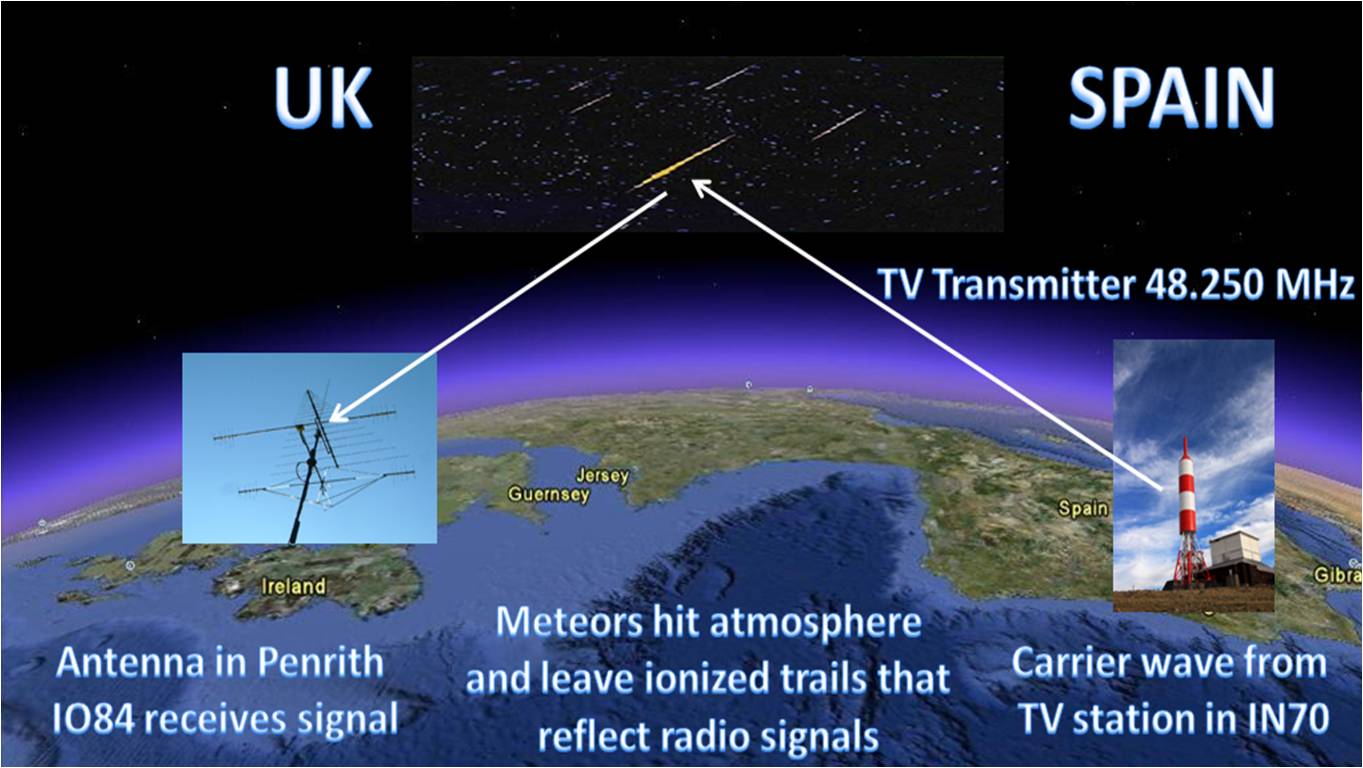
On
144 MHz
the distances for single hop Es
contacts appear to all be in the range of between
1400-2400 km
with rarer double hop
Es extending this to a
recorded maximum of 3600 km.
Longer distances can be found online, however they all appear to be via
Tropospheric Ducting + Sporadic-E
(TRDES),
analysis of the Callsigns/locators show them all to have an extensive over
water path (Sea) and intense
Tropospheric Ducting was reported at
the time to be the main Propagation mechanism.
No triple hop
Sporadic-Es
has ever been recorded for frequencies as high as
144 MHz,
the highest frequency this has been observed has been
90.7
MHz. The angle
the radio signal hits the
Sporadic-E
cloud needs to be shallow enough to permit
reflection, depending on the MUF value, otherwise if too steep or not
supported by the MUF it will not be reflected and instead pass straight
through the Es
cloud and off into space.
The exact multi hop mechanism
for each signal may not be readily identifiable and
may be signals reflecting off a single
Es
cloud layer or multiple separate
Sporadic-E clouds and/or
various mixtures of Cloud and the Earth (TBC) with potential reflections from water offering
significantly less attenuation than from land. It has also been suggested that
metal train tracks might also permit ground reflections, as well as bodies
of water such as lakes and rivers or the Sea.
It is also theorised
and pretty much correlated that the
Es cloud
layers are not uniform and flat, but may have parts or all tilted at times at up to 45
degrees where they often have an irregular wavy surface, like corrugated metal
sheeting (see image below). This can slightly
complicate understanding the precise
Sporadic-E
hop
mechanism being observed on
50 MHz
with the theory being of many instances where two cloud
Es formations exist, the
Es layers
being
tilted towards each other.
This two cloud
Es
formation appears to account for
50 MHz signals in the
distance range of 2400-3200 km
i.e. more than a single hop maximum
(2400 km), but much less than for
double-hop (4800 km).
The signal path being
Earth-Cloud-Cloud-Earth.
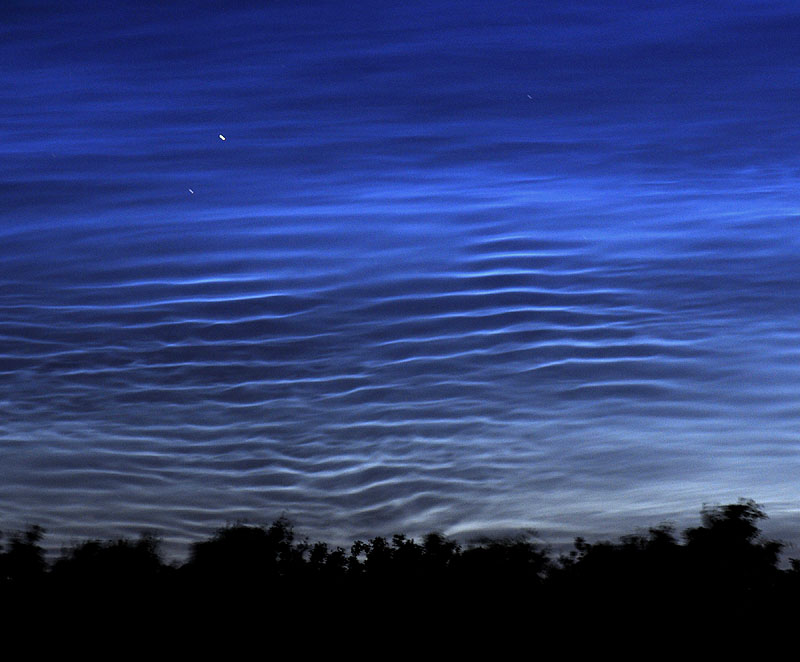
Noctilucent clouds at around
85km altitude - Photo by Jan Koeman,
Kloetinge, the Netherlands, July 2009
In
the two Es cloud formation path
live example shown below, captured at 18:12 UTC on
17th July 2018,
I was hearing the station of
SV1NZX
in KM17
square via Sporadic-E
on 50 MHz
at a very strong signal level, my station
G0ISW
in IO84
square being 2741 km
in distance away and therefore well beyond the maximum single hop distance
of 2400 km.
Looking at the live MUF mapping software
display there were two significant
Es
cloud areas in place (circled in red) on the path, both at a similar distance from our stations,
therefore it appears that the signal was being reflected from these separate
Es
clouds at the same time, with both
Es
clouds layers probably being slightly tilted
towards each other with wavy irregular cloud surfaces, the path being
Earth-Cloud-Cloud-Earth.
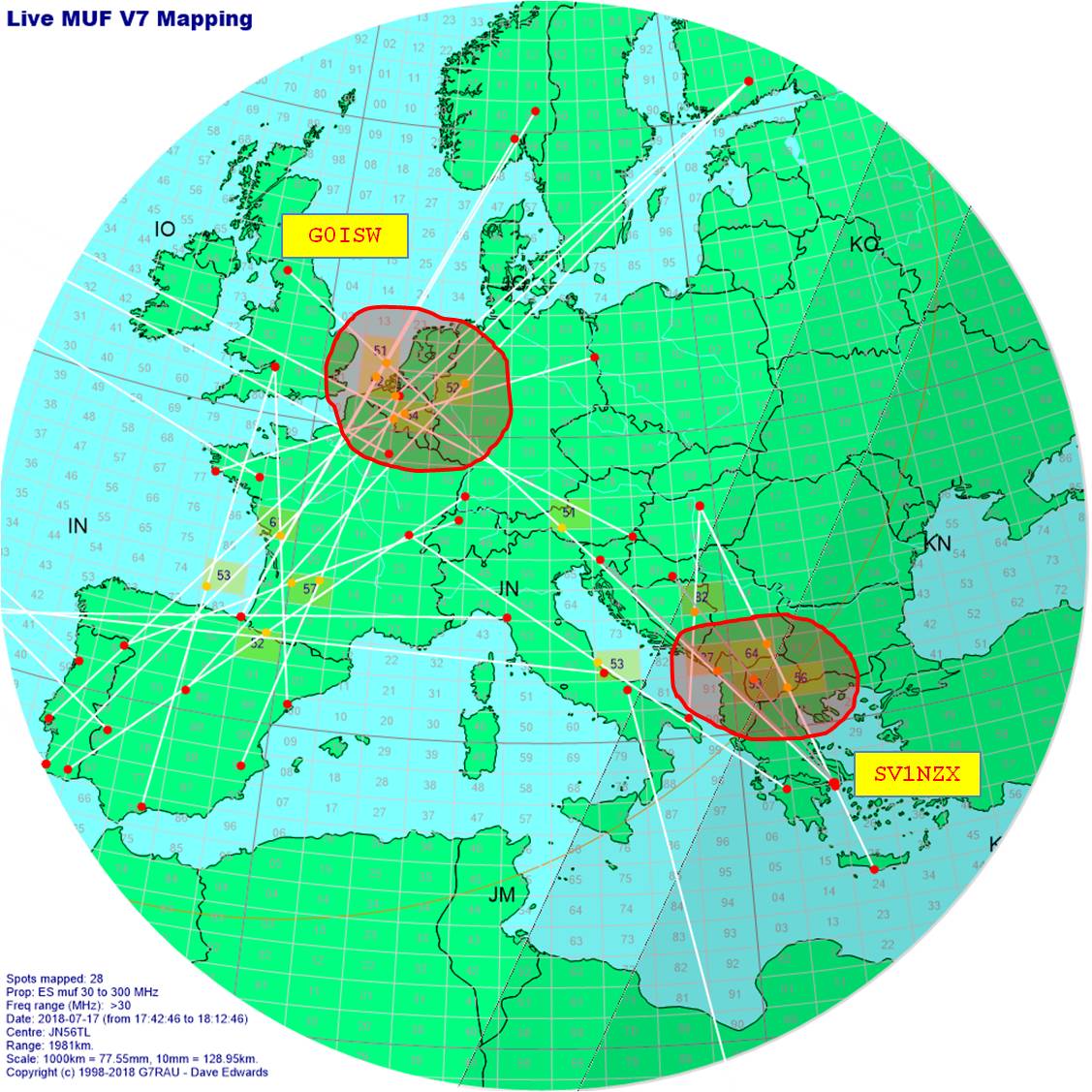
Be aware though that in
multi hop
Sporadic-E
propagation of two
(2xEs) or three
(3xEs)
clouds, they are unlikely to be evenly spread apart between the transmitting
and receiving stations, one cloud may be very close, the other/s very far
away or any combination, as well as differing altitudes.
Planetary Solar K-Index
For monitoring the Planetary Solar K index, observing the
suggested level 3 or less to allow
Sporadic-E, the NOAA Space Weather
Prediction Service is recommended,
Right
click on the image below and select 'open link in new tab' to see current
levels.
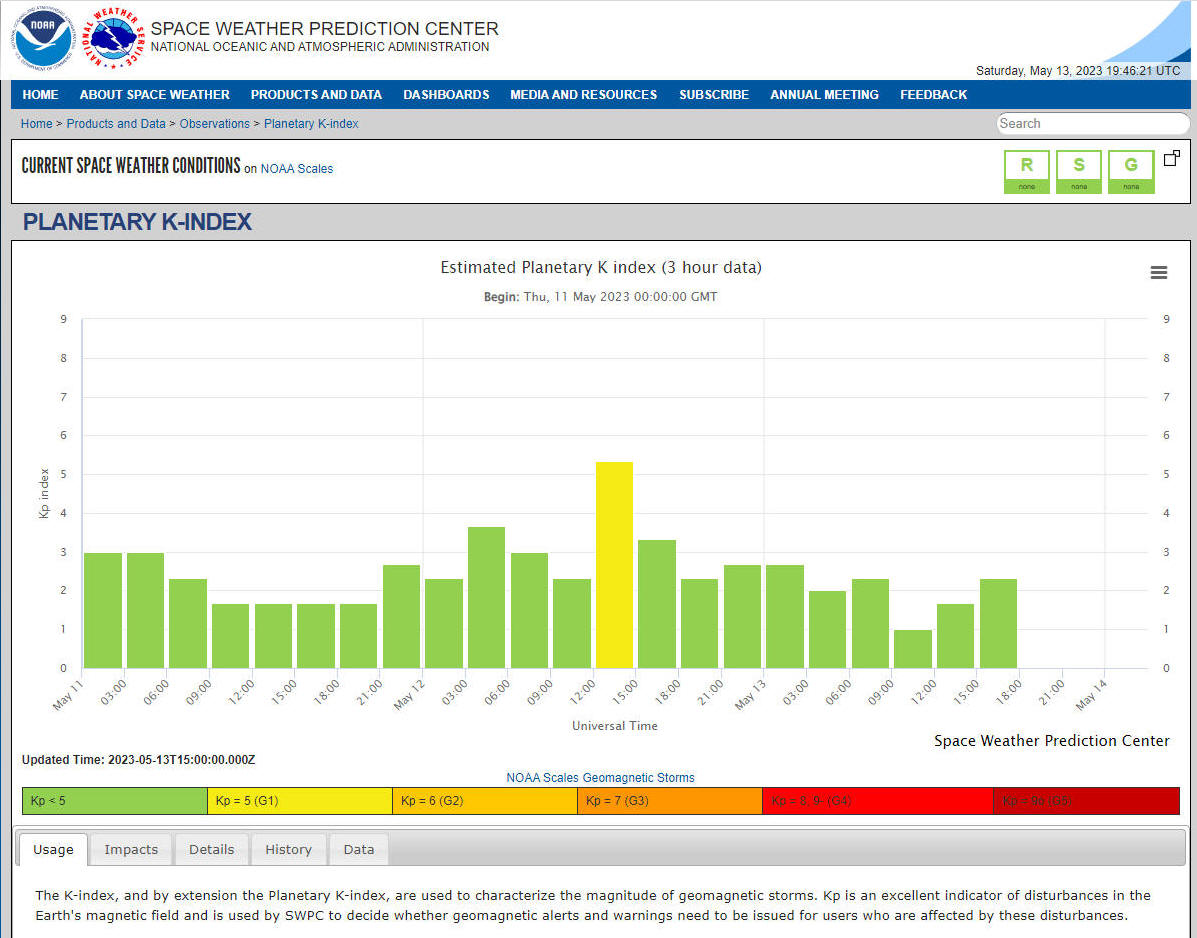
Total Electron Content (TEC) Maps
A TEC map, also known as a Total Electron Content map, can be useful for
visualizing and studying
Sporadic-E
(Es)
propagation in the ionosphere.
Sporadic-E
is a phenomenon in which irregular patches of ionisation occur in the
E-region of the ionosphere, typically at mid-latitudes.
Here's how a TEC map can be helpful for
Sporadic-E
visualisation:
1. TEC Measurement: TEC represents the total number of free electrons in a
column of unit cross-sectional area from the Earth's surface to the top of
the ionosphere. TEC maps provide a quantitative measurement of the electron
density variations in the ionosphere. By analyzing TEC values over a
geographical region, you can identify regions with enhanced electron density
associated with
Sporadic-E
events.
2. Ionospheric Irregularities:
Sporadic-E
events are characterised by the presence of localised ionospheric
irregularities. These irregularities can cause radio wave propagation
anomalies, affecting communication and navigation systems. TEC maps allow
you to identify regions where TEC gradients or fluctuations deviate from the
average ionospheric conditions, indicating the presence of
Sporadic-E.
3. Spatial Distribution: TEC maps provide a visual representation of TEC
values over a specific geographic area. By examining the spatial
distribution of TEC anomalies, you can identify regions that are more prone
to Sporadic-E
occurrence. This information can be valuable for planning radio
communication systems, particularly for high-frequency (HF) radio links.
4. Temporal Evolution: TEC maps can be generated and updated at regular
intervals, allowing you to observe the temporal evolution of
sporadic-E
events. By analysing successive TEC maps, you can track the movement,
expansion, and dissipation of
sporadic-E
regions. This knowledge can be useful for understanding the dynamics of
sporadic-E
and predicting its behaviour.
Overall, TEC maps provide a comprehensive view of the ionospheric electron
density distribution, enabling the identification, analysis, and
visualisation of
sporadic-E
events. They help researchers, radio operators, and scientists gain insights
into the behaviour of
sporadic-E,
leading to improved understanding and utilisation of the ionosphere for
various communication and navigation purposes.
Right
click on the image below and select 'open link in new tab' to see current
levels.
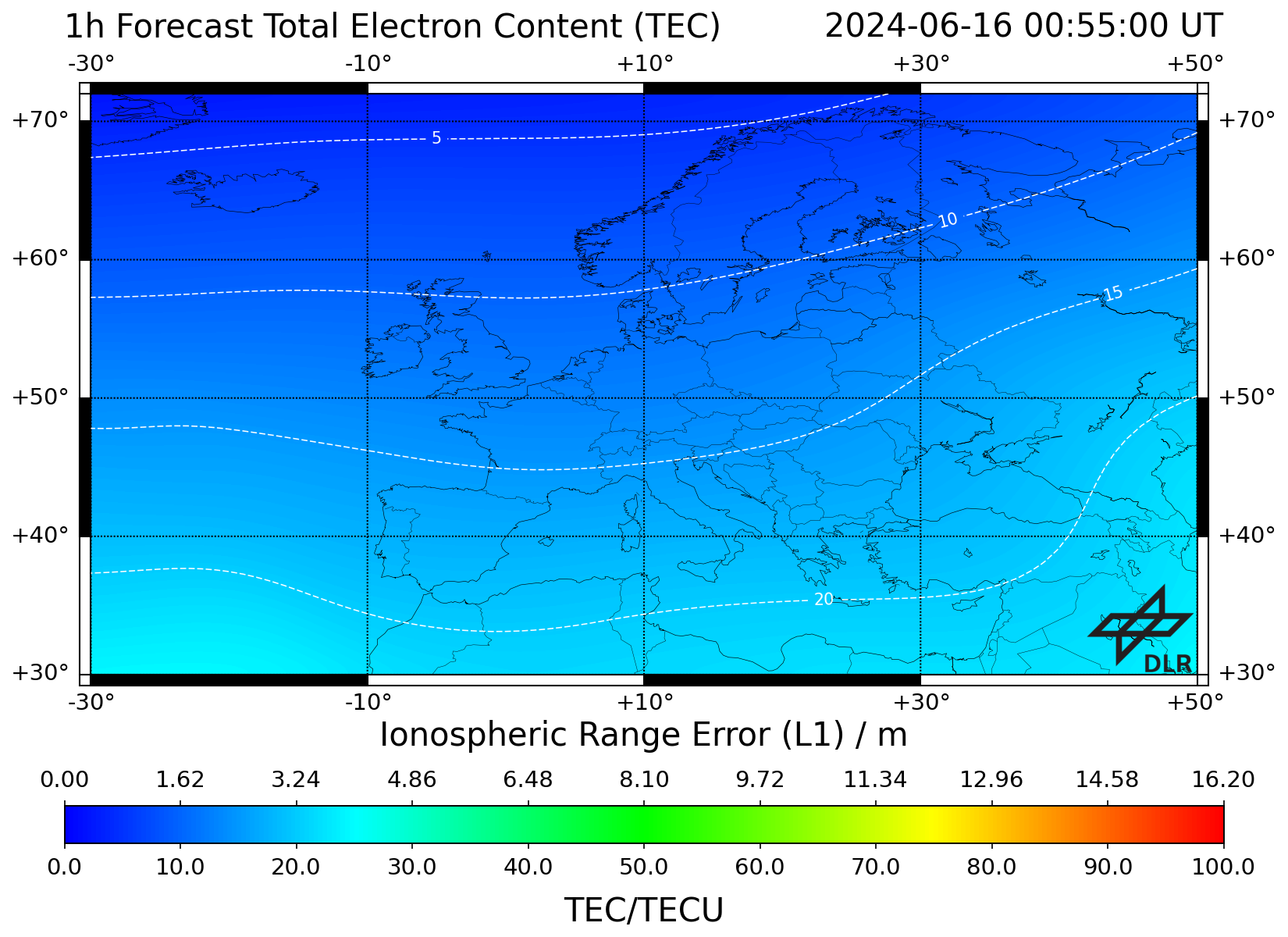
Ionosphere Monitoring and Prediction Centre” (IMPC) is operated
by the German Aerospace Centre (DLR) at the Neustrelitz
location. I thank DLR who is maintaining the IMPC
services.
Sporadic Es and
Ionospheric chart for Rome
Showing daily height of
Sporadic-E
clouds (h'Es)
and HF MUF.
S hown, if present, is the height of the
Sporadic-E
reflecting cloud layer, usually between
90-131 km
(h'Es),
with the higher the height the better, as it may indicate stronger ionised
metal bearing layers, which will support higher VHF frequencies and also last longer than
Es layers at lower altitudes.
The
live data Ionogram shown below from Rome, Italy is a very good guide to
whether or not Sporadic-E paths exist
from
central to Southern Europe on any given day, it is one of several Ionogram generating sites, the
others can be found from the RSGB website
here or the
DK5YA VHF page.
It is interesting to observe that the height of the
Sporadic-E
layers is not uniform across all of the locations in Europe at the
same time of measurement, for
example at 08:00 UTC on
13th July 2018
the heights ranged from
108 km
in Rome, 97 km
in Athens, 108 km
in Svalbard, 105 km
in Dourbes, Belgium, 115 km in Juliusruh,
Denmark, 103 km
in Tromso, Norway, 113
km in Gibilmanna and
115 km
in Pruhonice.
Also the
Sporadic-E
layer
heights vary by time of day, with Rome descending from
108 km
at 08:00 to 99 km
by 11:00 UTC, it was thought all
Sporadic-E
clouds descend over time after reaching their peak altitude.
(Right click on image below
and select 'open link in new tab' for current chart)
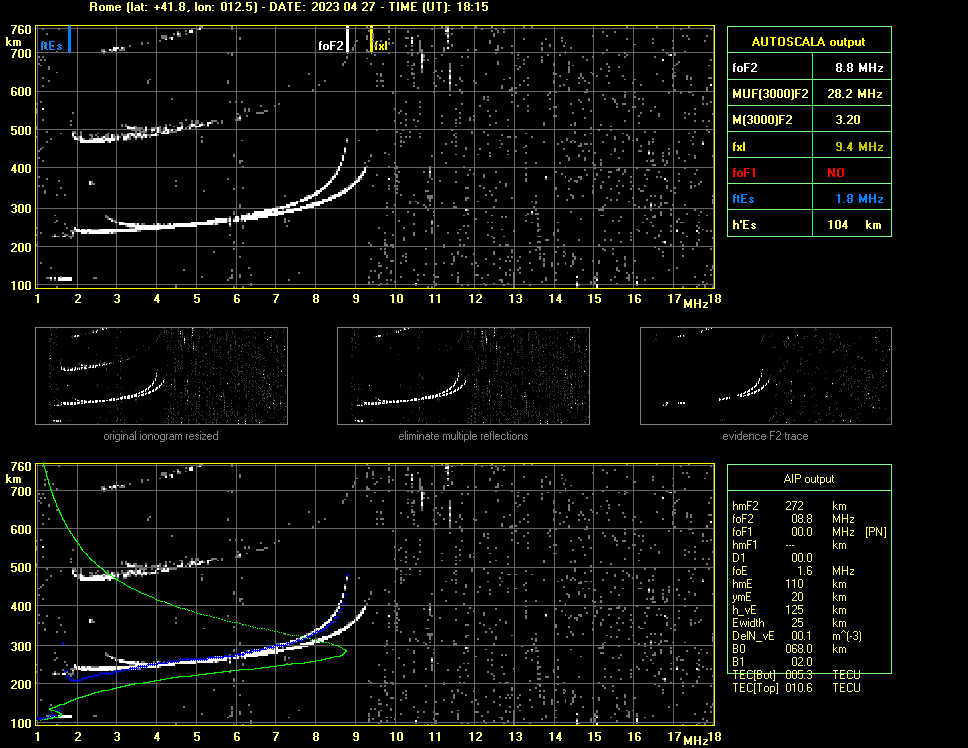
Image above courtesy of the Rome Observatory of the
Instituto Nazionale di Geofisica e Vulcanologia (INGV)
Observing the
Sporadic-E
cloud heights over several days in
June 2023 using the
Rome site h'Es
altitude data showed the following height patterns, from first detected
Es
presence onwards, typically early morning to late evening:
13th June 2023
104km->108km->122km->No
Es->126km->117km
14th June 2023
108km->99km->104km->117km
15th June 2023
113km->104km->113km->131km->117km->108km->104km->99km
17th June 2023
117km->113km->108km->104km->113km->108km
18th June 2023
131km->122km->113km->108km->104km->108km->104km->108km->No
Es->104km->108km->113km->108km->113km->117km->113km->104km->108km
From these observations we can say
that after peak Sporadic-E
cloud height is reached, the clouds do generally trend downwards over time as daylight
closes, however in the mornings some clouds rise to a peak, others drop
height before rising again to a peak later in the day and some clouds
disappear altogether, only to reappear later.
On the
Sunday 18th June 2023
the Sporadic-E
heights shown above were all over the place like a yo-yo.
Sporadic-E cloud height and related signal distances
The height of the
Sporadic-E
cloud directly influences the distances over which reflected VHF signals can
be received. If a single Es
cloud is located at a lower altitude within the E Region, the radio signals
will be reflected back at a lower angle, allowing them to reach receivers
that are relatively closer to the transmitter. Conversely, if the
Es cloud is situated at a
higher altitude, the signals will be reflected at a steeper angle allowing
them to reach receivers that are farther away.
However, for double hop
(2xEs) or rarer triple hop
(3xEs) Sporadic-E
propagation, lower cloud heights increase the chance of the VHF signal being
reflected off the first cloud, by the shallower angle of incidence
supporting a higher MUF, onto the underside of subsequent
Es clouds thereby
increasing the workable distance beyond that of a single higher
Es cloud. This often
leads to double hop (2xEs)
Sporadic-E
propagation being observed to be more prevalent in the early morning or late
evening, when the Sporadic-E
clouds are at their lower altitudes, typically they are at their highest
altitude at midday or in the afternoon.

Sporadic-E correlation with atmospheric effects
Sporadic-E on
144 MHz
defies any specific direct correlation with AGW, wind shear and thunder storms. In the
example below at 17:53 UTC on
23rd July 2018
there is a pronounced Es
reflecting layer shown over the Balkans and their mountain ranges, but
checks on live wind charts show no jet stream or other significant wind
activity anywhere near and also no lightning whatsoever.
After
sunset the ionised Es
layer usually fades until it can no longer support VHF signals being
reflected from it, probably due to no longer receiving solar radiation,
however on rare occasions
Sporadic-E
VHF
propagation has been known to occur even up to local midnight.
From observations in Europe, over the past 30 years,
Sporadic-E
clouds are randomly
generated signal
reflecting areas, which vary in size depending on the frequency band they
can support i.e. 50
MHz Sporadic-E
clouds are usually significantly larger and can often be around
500 x 500 km (5 x 5 grid
squares) in size, whereas on 144 MHz
they may often only be 50-100 km
in size i.e. a single grid square, unless a very significant and much rarer
large opening event. The usual small reflecting area on
144 MHz
means fewer stations will be ideally located to benefit from using it. Some
stations will enjoy the enhanced long distances being worked and others will
miss it entirely if not in the right place at the right time.
In the image below we can see that there was one locator square where the
50 MHz
Sporadic-E signal paths were crossing
in JO22,
no mountains nearby.
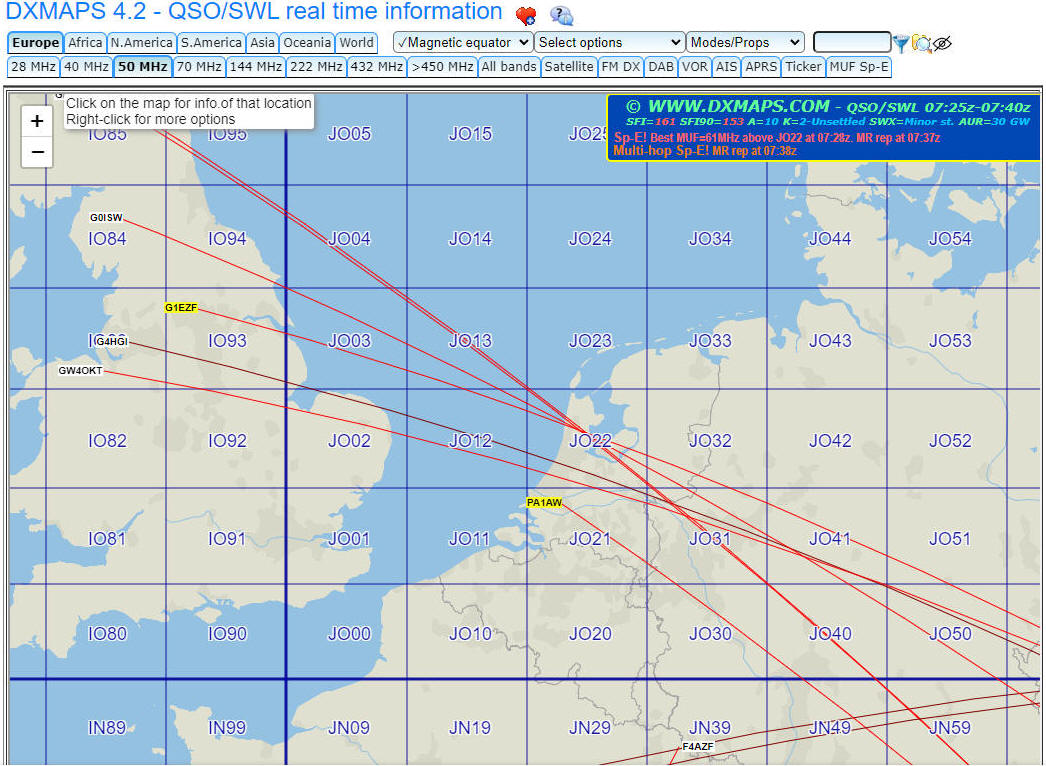
In
the images below white lines
show the paths on 50 MHz,
grey lines
are 70 MHz
and red lines
are 144 MHz.
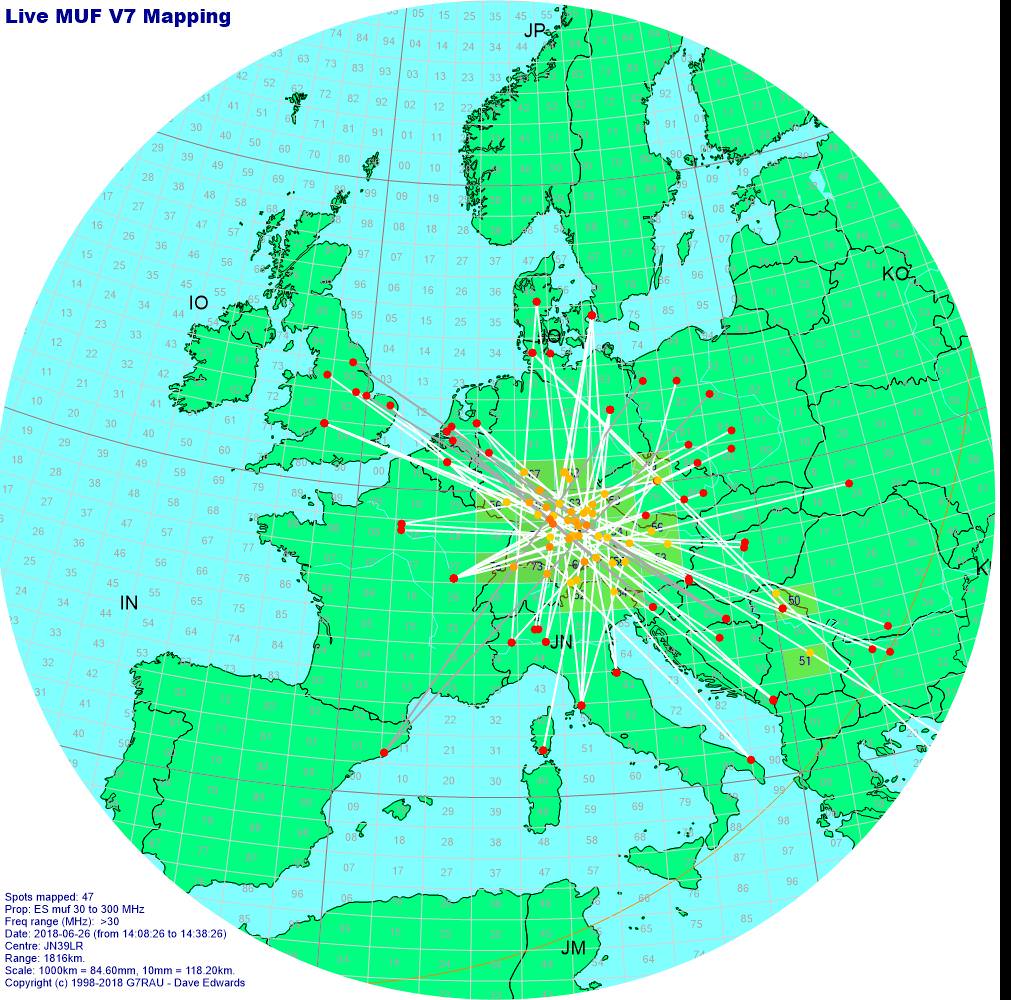 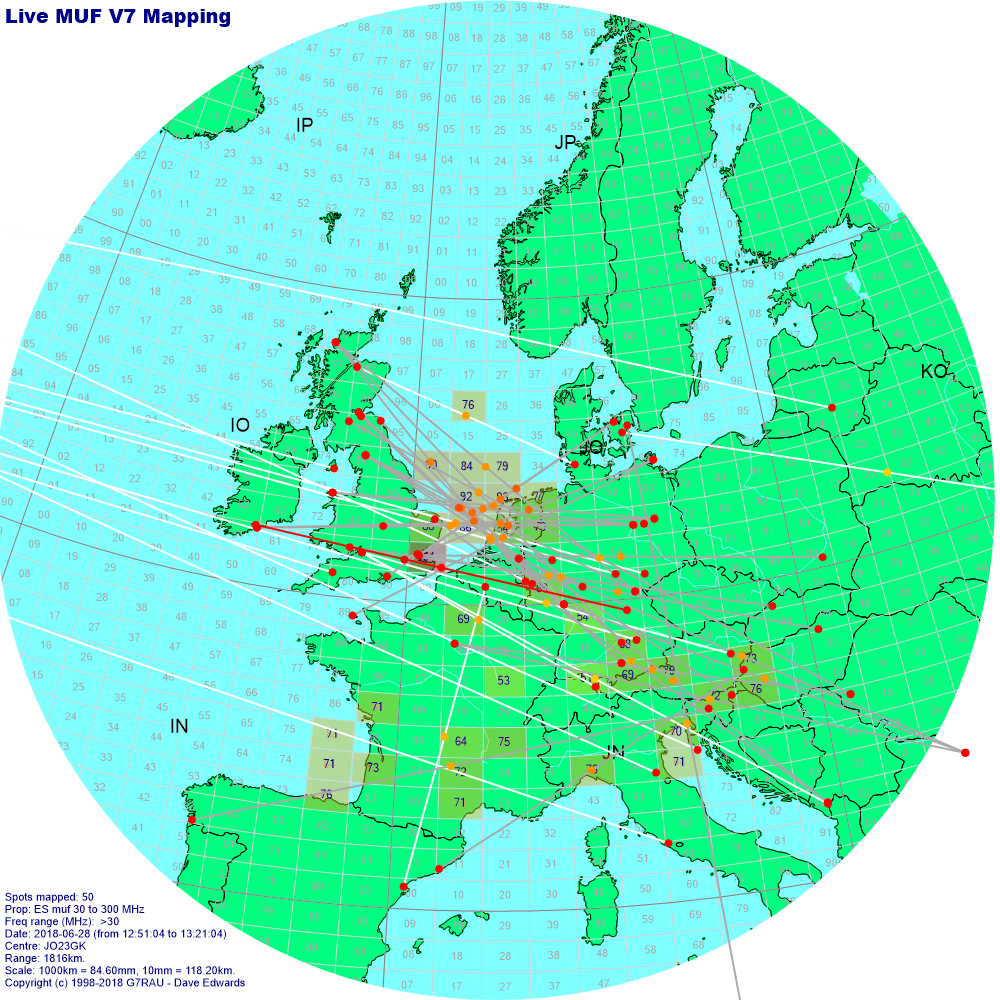
On 144 MHz
the Sporadic-E
layers in Summer have been observed to move slowly from East to West and sometimes
correlate with intense thunder storms, but not always. Note the correlation
between this very significant 144 MHz
Sporadic-E
opening reflection zone, shown below on 12th July 2018, and the live map of lightning
strikes at the same time in the same area. The 144 MHz
opening on the border of
Poland
with
Ukraine
shown below lasted just over 1 hour and despite much similar
lightning visible in
Norway
no such
Sporadic-E
opening occurred there. However later in the week further extensive thunder
storms were present and no Sporadic-E
was observed anywhere in Europe, all the necessary combination of
ingredients not being present.
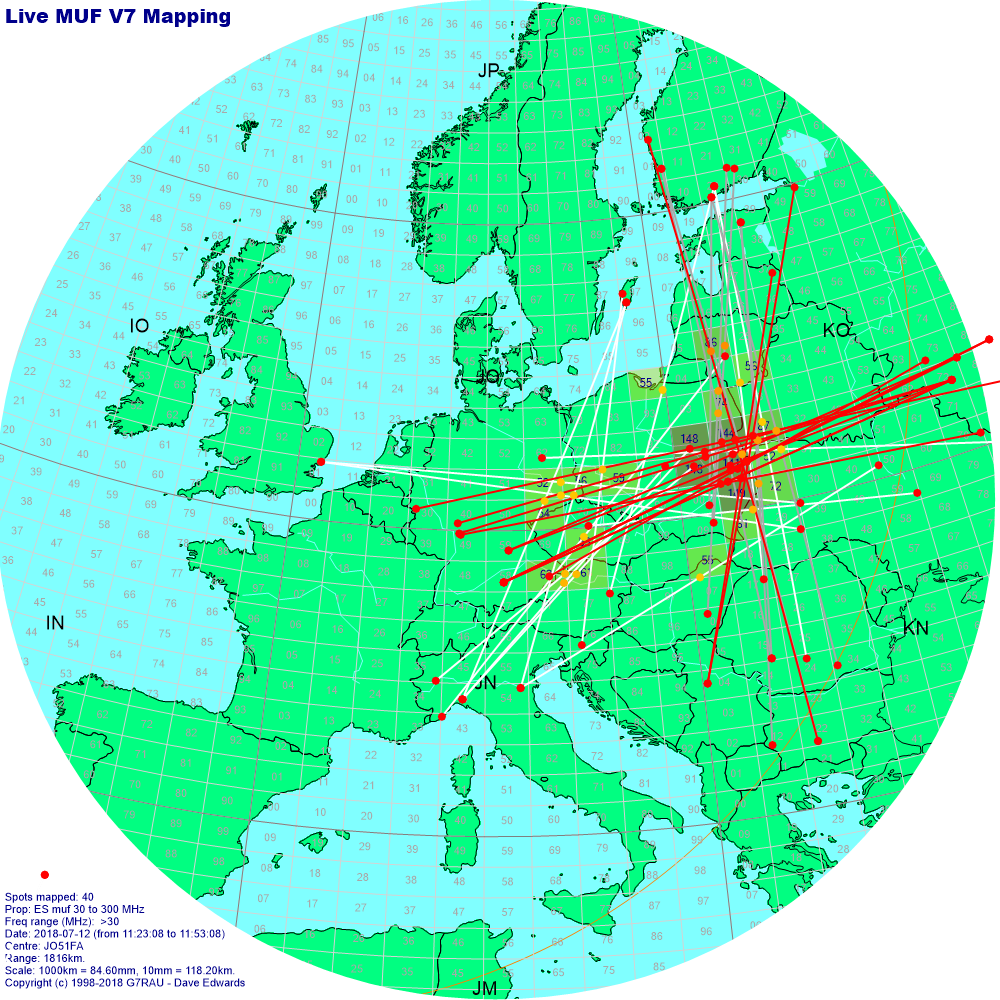
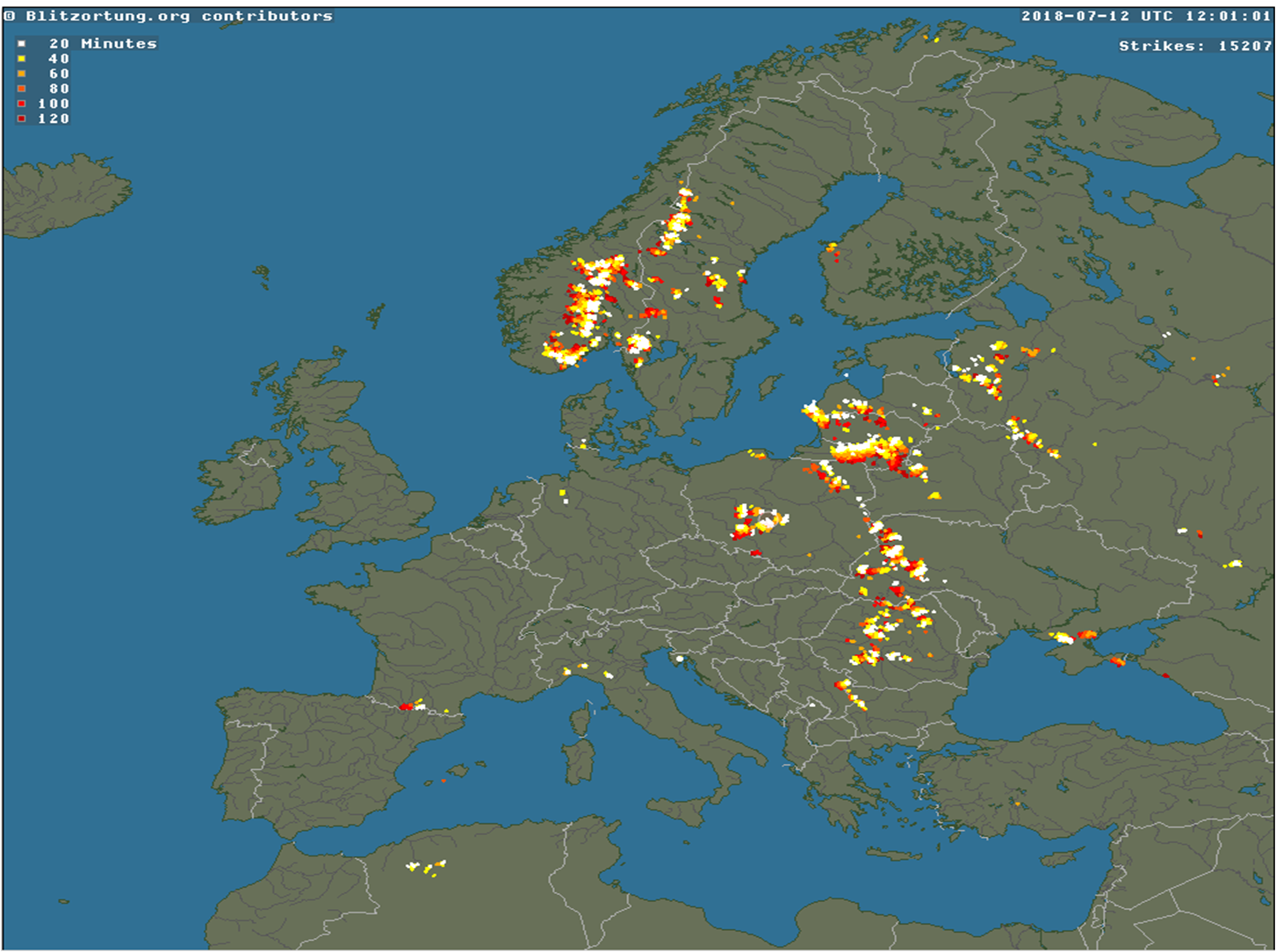
In addition whilst
50 MHz
Sporadic-E
band openings can last most of the day,
144 MHz
openings can be very short lived and occur much less frequently, only being
available for a few days each year and for much less time, sometimes only as
little as a few minutes or an hour and almost always in June.
From my own observations
144 MHz
Sporadic-E reflecting
areas do sometimes, but not always, coincide with intense thunder storms and
due to the height of the Es
reflecting layer being between 90-130 km
I theorised a link with the then little known electrical Sprite phenomenon perhaps,
possibly generating Atmospheric Gravity Waves (AGW) and causing wind shear
at 90 km
altitude and higher.
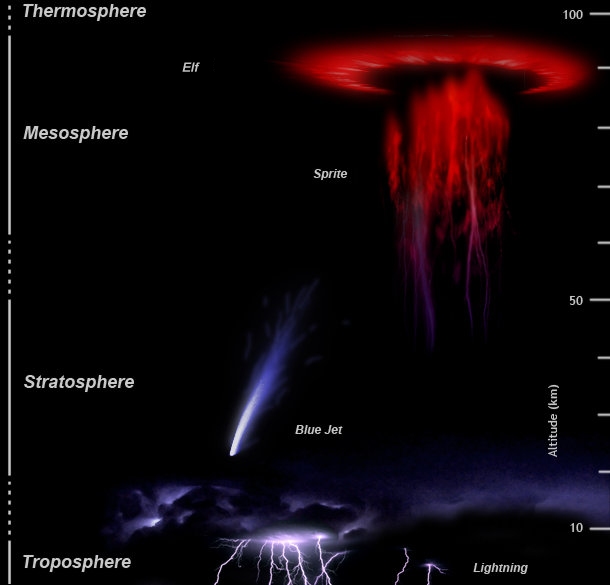
Image credit
https://en.wikipedia.org/w/index.php?curid=4262250
Abestrobi Own work CC BY-SA
3.0
The higher the frequency the more
intense the Sporadic-E
ionised
layer has to be to support forward scatter propagation via it, at
144 MHz
in particular it can be frustrating to see the small reflecting area favour
radio amateurs in a particular geographic area reasonably close, but in your
own location nothing is heard and vice versa. Sometimes the reflecting areas
at the centre of the lines connecting the QSOs converge over a particular
area each year, the
Bay of Biscay near France
is one such area. Often the reflecting layer/cloud moves over hours
in a East to West direction. Using the Live-MUF mapping software it
is very easy in real time to observe these events.
Sometimes
on
144 MHz
there may be correlation with
Es
reflecting areas and thunder storms generating extensive lightning
activity (another theory), but by no means do they coincide every
time. On the morning of
3rd May 2016
there was a clear
50 MHz
Es reflecting
layer centred over the Baltic states, but no wind shear or AGW from
mountains, nor any thunder
storm lightning activity found using live data, so the required ingredients
were much simpler.
In
June 1989, during a
particularly intense radio
Es event
on
144 MHz, I observed the distant DX stations
heard to
slowly all shift SW over the course of two hours, in a direction not associated
with the jet stream, but consistent with the Earth's rotation in
relation to the Sun.

If we
consider the 'wind shear' theory formulated in the 1960's by
Whitehead
(1961) and Axford (1963) in which vertical shears in the horizontal wind
form thin layers (several kilometres thick) from metallic ionisation through
ion-neutral collisional coupling and acting in the presence of the Earths
magnetic field and through the Lorentz force. The original metallic ions
thought to be present from meteoric origin.
Wind shear
from the Jet Stream at altitudes of between
9-16 km above ground level over
mountains has been suggested to have an association with
Sporadic Es, part of the so
called 'wind shear' theory. Using the live wind chart below and setting the
wind height altitude to 500 hPA (11 km)
should allow observations and comparisons to be conducted in real-time with
Sporadic Es
cluster maps to support or discount any such correlation, with wind effects.
(Right click on image below
and select o'pen link in new tab' for current live
jet stream map)
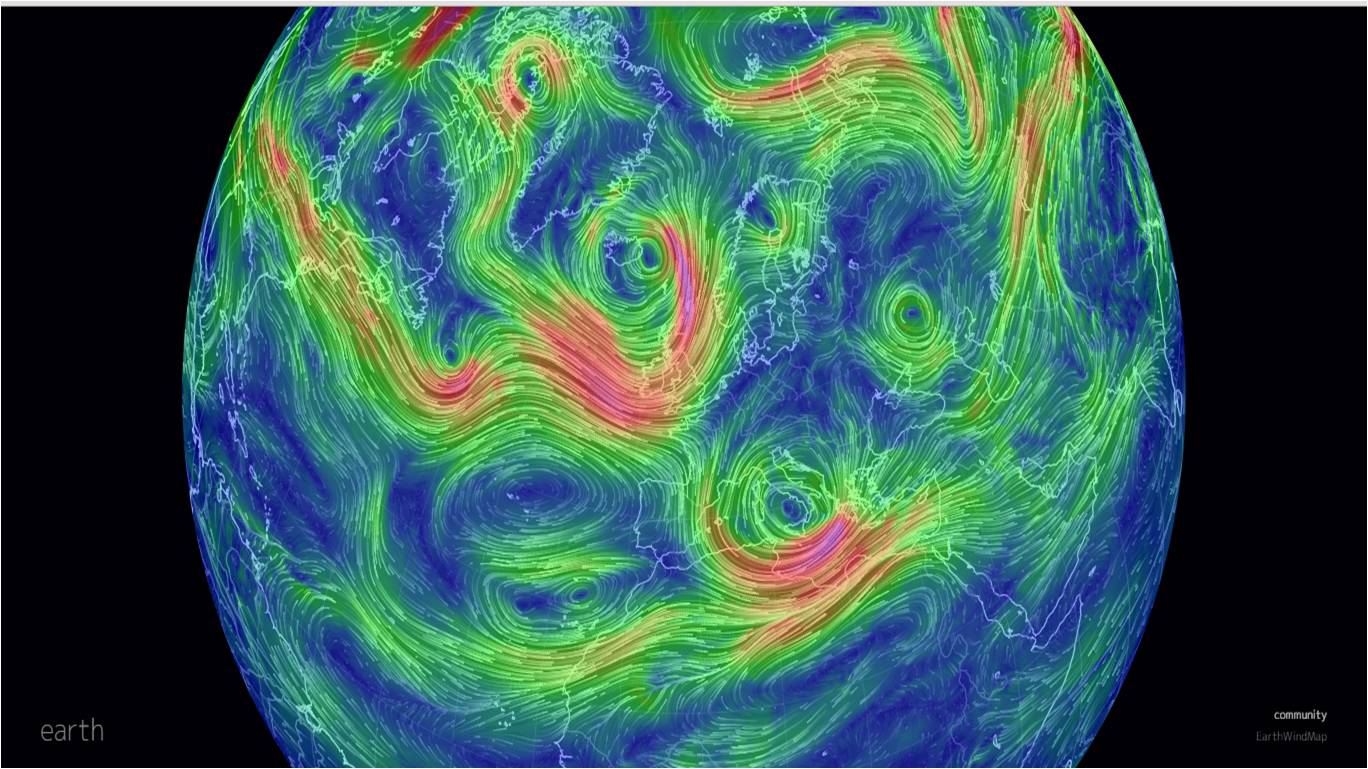
Noctilucent
clouds
do prove
that there are wind effects present at very high
90 km
altitudes caused by
Atmospheric Gravity Waves (AGW), their non uniform composition can be
likened to the theorised irregularity of
Sporadic-E
clouds.

Noctilucent clouds at around
85km altitude - Photo by Jan Koeman,
Kloetinge, the Netherlands,
July 2009
How
are there wind effects and potential 'wind shear' at
90 km
altitude required for Sporadic-E?
Well, Atmospheric Gravity Waves (AGW) required to form
Noctilucent clouds
and other wind effects at these high altitudes can be generated by either
violent intense thunderstorms or wind flow over high mountain ranges, which
cause vertical displacement of the air flow with the AGWs forming when
buoyancy pushes air up and gravity later pulls it back down.
The
AGW can be likened to a corrugated tin roof effect being placed on the
original horizontal air flow and these uneven waves of air then travel to
high altitudes and new waves form underneath so a sequence of waves will be
formed. AGW are medium scale waves with the horizontal wavelength ranging
from several tens to several thousands of kilometres and a vertical
wavelength of several kilometres. Using radar measurement AGW have been
observed to reach heights of around
85-88 km, the same height as
Noctilucent clouds. The AGW can even penetrate up to the Ionosphere where
they trigger ionospheric irregularities and add to the recipe for
Sporadic-E
likelihood.
The generally accepted height of the
Sporadic Es reflecting
layer is around 90-130 km, which is very
significantly higher than the jet stream altitude of
11 km.
Although annual the intensity of
Es
events varies by year and had been very poor compared with the 1980's and
1990's, despite peaks and troughs of the solar cycle. In 2017 and since it has
mostly been much better.
There is a
definite connection with the radiation intensity of the Sun
due to the primary seasonal Summer nature of the event in the Northern hemisphere.
Also the Es
events tend to mostly occur during daylight hours at VHF. A 3-6 day cycle
pattern of building up to a
Es
peak also seems quite prevalent where generated by jet stream wind shear, possibly an electric ion charge/discharge cycle period
perhaps, it does seem strange to see very active
Sporadic-E
one day and absolutely nothing the next day despite Solar
conditions appearing unchanged.
Fair weather return currents
can dissipate
Sporadic-E
clouds
Significant solar flares and thunderstorms can help generate
Sporadic-E
clouds in a much shorter time frame than by Jet Stream winds alone.
The Earth has a
Global Electric Circuit
(right click on image below for video explanation) with lots of variables
daily impacting upon it at Ionospheric altitudes, many of these factors will
contribute to whether or not VHF radio signals can be propagated over vastly
longer distances than normal on any given day.

A
very lively start to the day at 0845 UTC on
Sunday 28th May 2023
with a significant Sporadic-E
opening on 144 MHz,
MUF is already shortly afterwards
150
MHz. Looking at live
Lightning strike map of Europe, there is no correlation observed this time. However there is very intense Meteor activity today believed
originating from Comet 209P, which occurs every year between
24-31st May,
see images below.
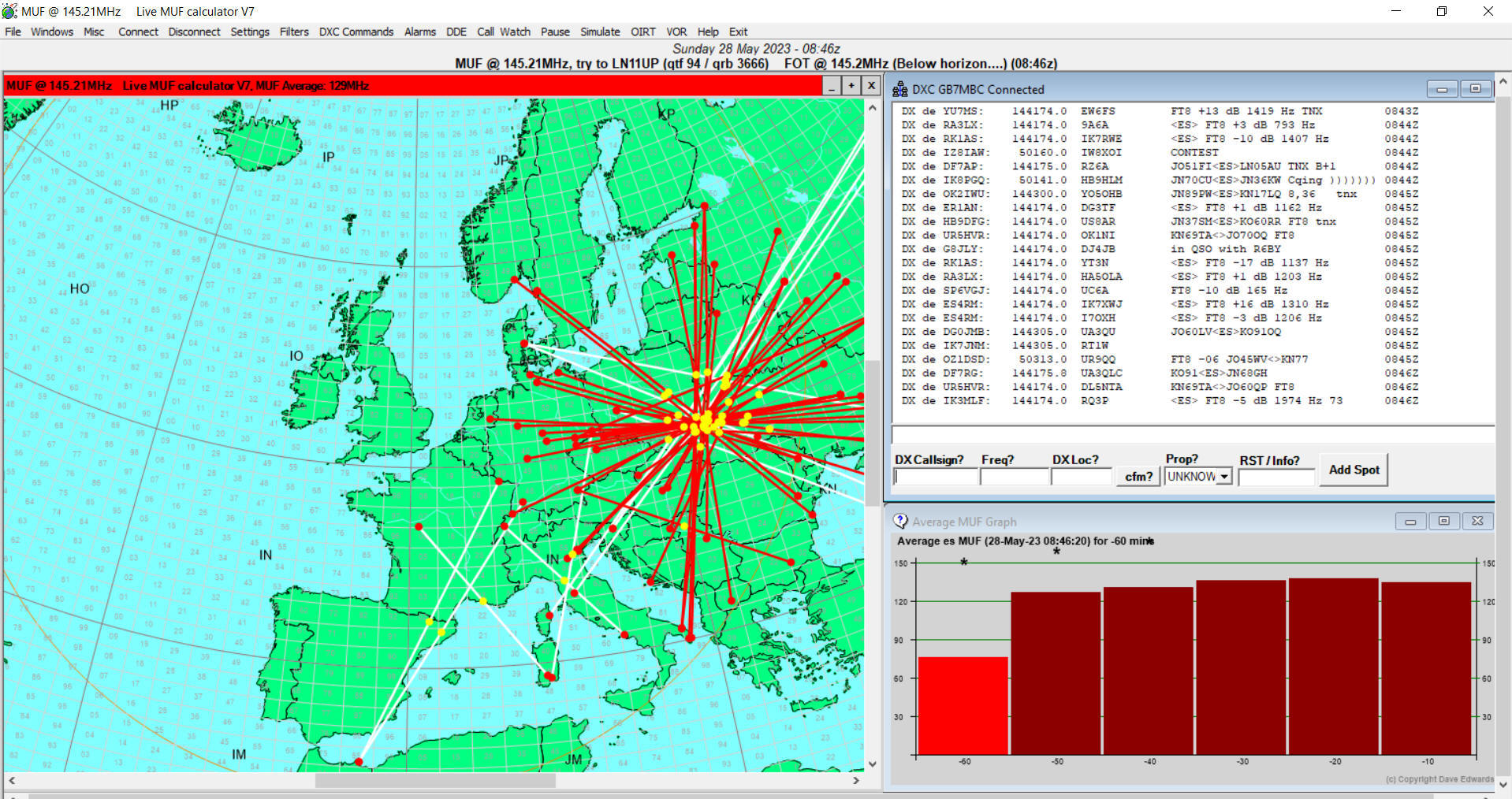
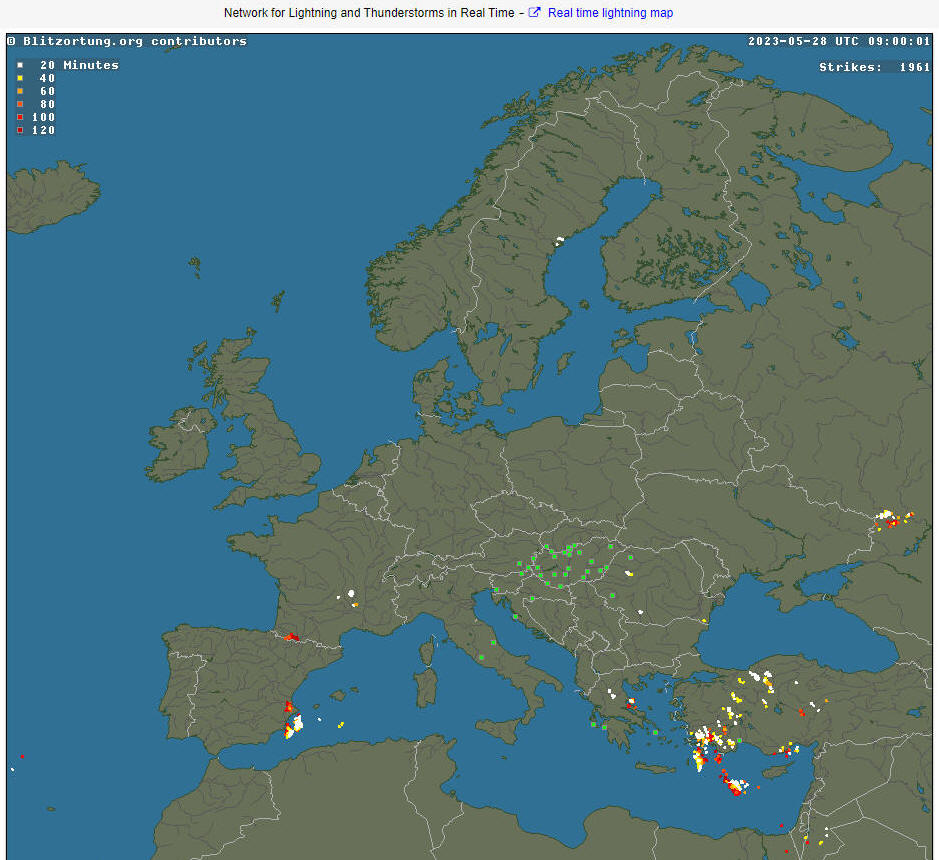
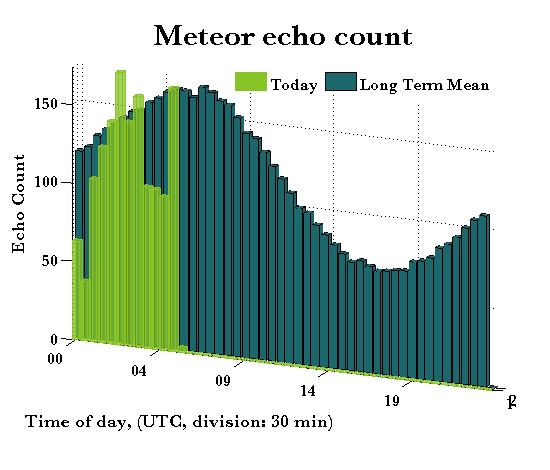
This
Sporadic-E
opening is staying frustratingly over central Poland at 1124 UTC and is now
only up to 70 MHz, it has moved a little further
West than earlier this morning. At 1305 UTC it still hasn't moved away from
Poland
and is getting weaker with just a few
50 MHz
spots being shown. By 1650 UTC the
Sporadic-E
opening on
50 MHz
largely gone and very little heard today here for the UK, surprising the
Es
didn't move or appear further West at all. Brief weak
50 MHz
opening from UK to Scandinavia this evening
Sporadic-E + Tropospheric
Ducting (TRDES)
Also
in June 2019
Sporadic-E +
marine
Tropo Ducting
allowed signals on the 144 MHz
band to be received from
D41CV
in the
Cape Verde Islands
off the West Coast of Africa to be received by
OE3NFC
in
Austria
at a distance of
5107 km,
the marine
Tropo ducting
path being from
Cape Verde to Southern Spain
where it joined the
Sporadic-E
path between
Southern Spain and Austria.
The
Sporadic-E cloud height is between
90-130km above the Earth,
so this combined Propagation mechanism favours a shallow angle of reflection
from the cloud down to the Sea surface, where it is then reflected from the
water into the very much lower Tropo Ducting 'pipe' and then can travel
considerably further. The height of the Tropo Ducting layer can vary from
just above the Earth's surface to several km high. Surface based ducting
typically forms over bodies of water and can be very close to that surface.
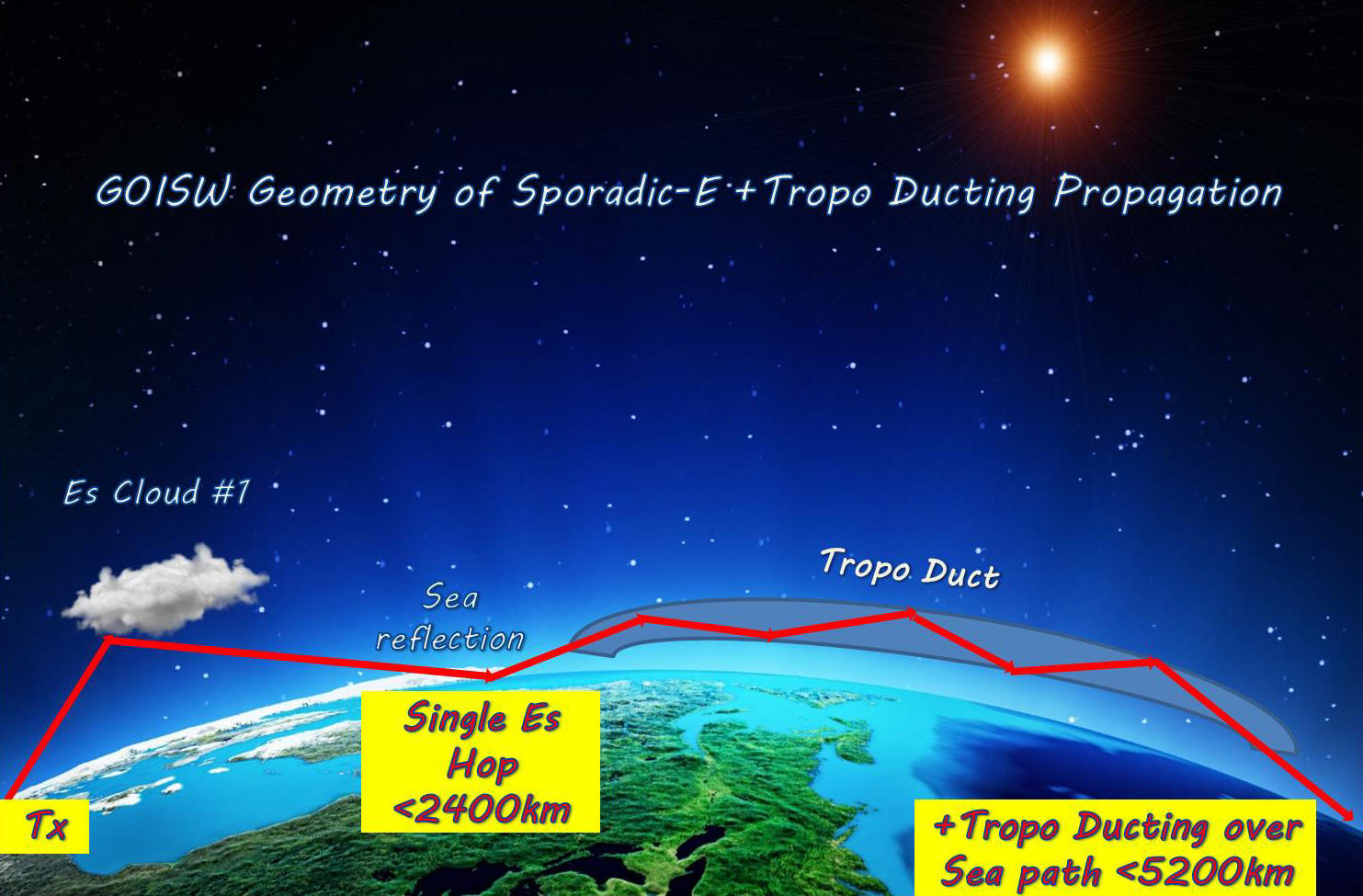
Sporadic-E + Trans
Equatorial Propagation (TEPES)
An
absolutely exceptional partial
Sporadic-E
contact occurred on the morning of
24th July 2018
between 0700-0800 UTC when
the station of VK8AW
(PH57) Darwin, Australia
worked and was heard by stations in
Europe
on
50 MHz
with the furthest station being
G3TXF
(IO71) in
England
at a distance of
14,118
km!
Previous theory and long established observations prior to 2018 stated there
should be no F2 or
Trans Equatorial Propagation (TEP)
propagation except at solar maximum, but having communicated via e-mail with
Gary Ashdown VK8AW
it appears that his signals were reaching
Southern Europe and the Middle East
via Trans Equatorial Propagation (TEP)
and were being further extended by widespread European
Sporadic-E
linking to it. Apparently
48-50 MHz
signals are observed by
VK8AW
regularly from the
Middle East and China and the new weak signal data mode
FT8 is allowing two way radio communications, where they were previously
almost unworkable or undetectable except at solar maximum in other modes
such as SSB.
This
mechanism of
TEP + Sporadic-E
propagation has been seen again on
50
MHz in
Summer 2019
with many stations in
Japan
working
Southern Europe
and even
UK
stations on the South coast of England.
On
7th May 2023
there was another good example of
Trans Equatorial Propagation (TEP)
joining up with Sporadic-E
on the 50 MHz
band in the evening, allowing stations in
Southern Europe
and
North America
to work stations in
South America,
which would have been too far for
Es
alone.
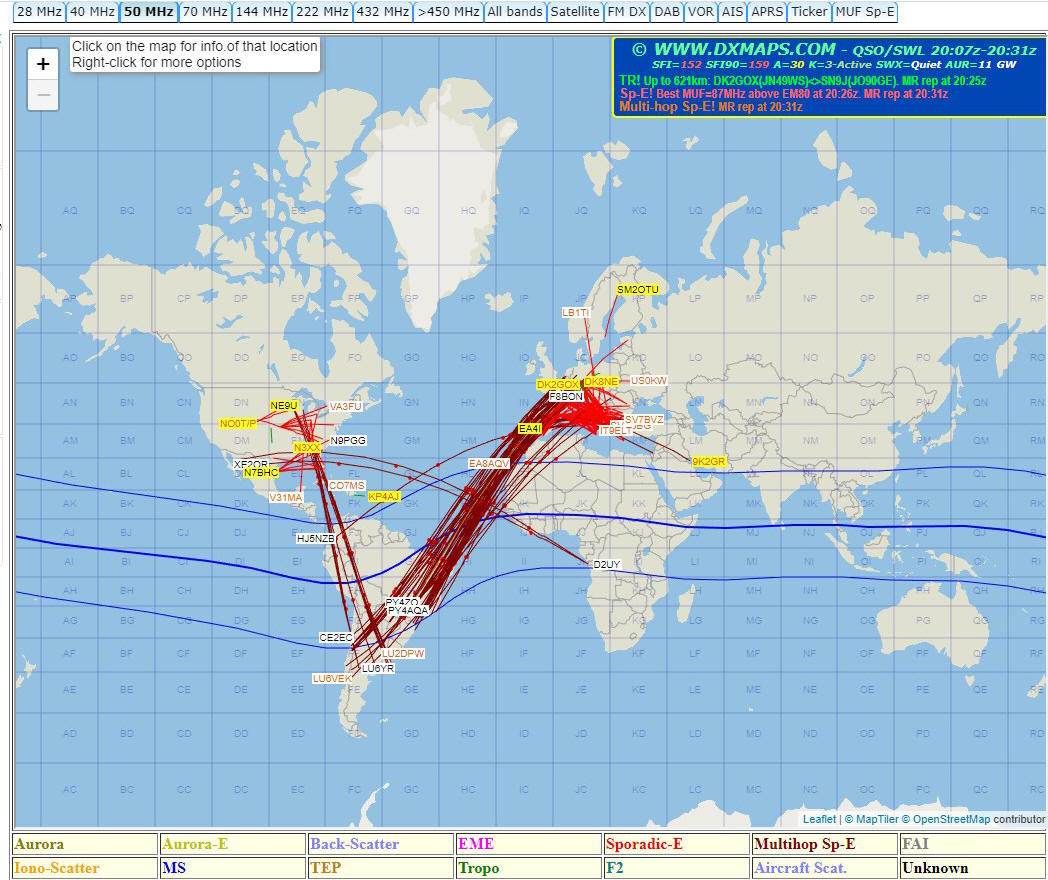
Another
good example of Trans Equatorial Propagation (TEP)
joining up with Sporadic-E
on the 50 MHz
band on Saturday 13th May 2023, stations in
Brazil
workable here in
Cumbria,
NW England
at around 1600 UTC
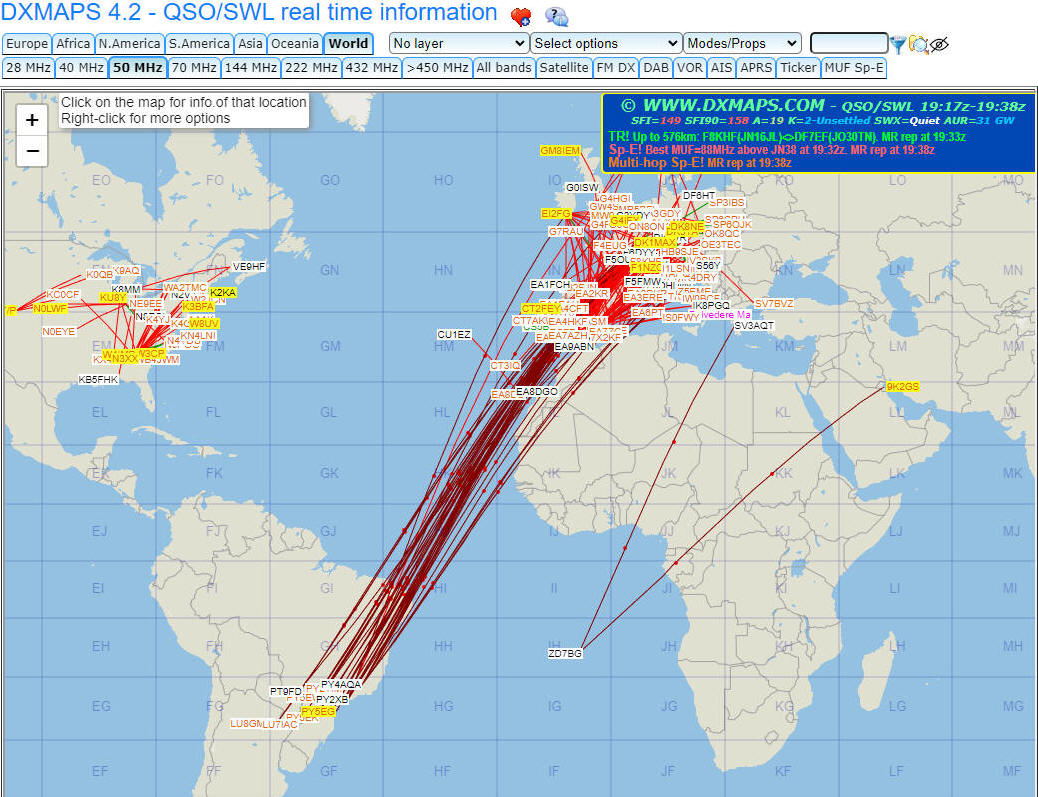
On Sunday
11th
August 2024 a
144 MHz TEP
contact using the Q65B
data mode took place between S50C
in JN76JG
and V51WW
in JH81OC
at a distance of 7211 km.
A fantastic result.
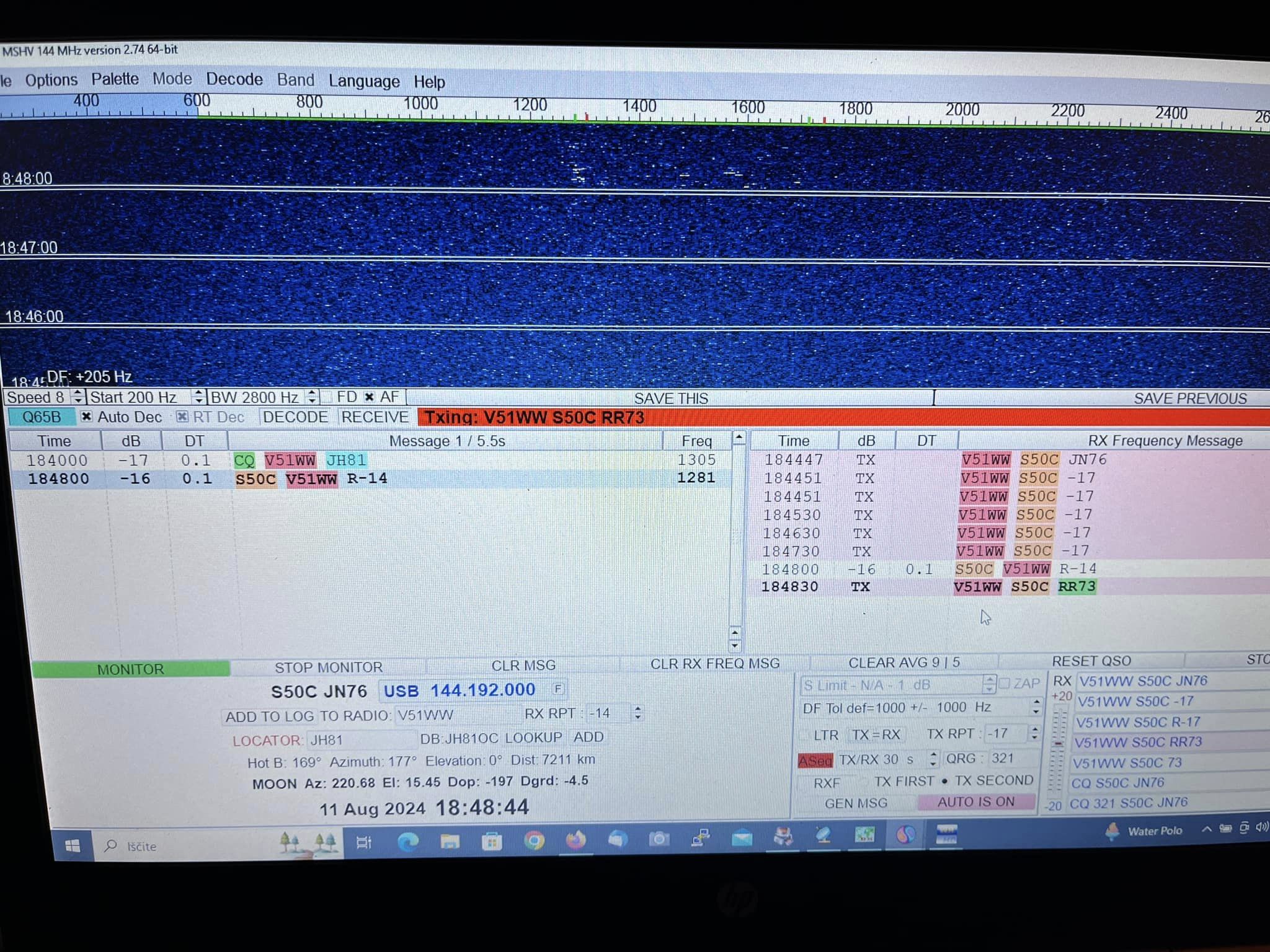
Highest recorded
Sporadic-E MUF
The
highest recorded
Sporadic-E MUF
that I can find so far online is
220MHz,
where Bill Duval K5UGM
(SK)
and John Moore W5HUQ/4
broke through a 1500km
path from
Texas to Florida, USA
on 14th June 1987
Intense Meteor Storm
generated
Sporadic-E propagation
When I participated in the fantastic Leonids
November 2002
meteor storm event, with
over 700+ meteors per minute,
the intensity was such that the whole 144 MHz band was wide open
for many hours in the morning with the high signal strengths associated with
Sporadic-E
signals.
The
extreme rarity of this type of event makes it very special to witness, for
me only once in my 40 years of being a Radio Amateur.
I have also observed other meteor showers coinciding with a
Sporadic-E like openings, as happened in
April 2017,
April 2021, and
April 2024 during the peak of the
Lyrids meteor shower, no other mention of
Sporadic-E by stations
until May, but the signal strengths I observed were very high and
prolonged again, for an hour or more.
The
long standing mystery of what exactly can generate
Sporadic Es
propagation continues, since it was first observed in the
1930's.
Anomalies investigated
using multiple data sources for later analysis
On
Sunday 2nd July 2023
at
1637 UTC
I heard
SV5DKL
on
50.313 MHz
FT8 via
Sporadic-E
at a distance of
3113km,
so at double hop
Es
distance, but look at the map below where the
Es
clouds (centre of doughnuts) do not appear to line up for this and
are showing the MUF
ES
for frequencies in the FM Broadcast band of at least
87.5 MHz.
That must mean then that the MUF
Es
clouds supporting my
50 MHz
reception must be in a different position or significantly larger in size
i.e. more to the North of the doughnut holes Es reflecting areas seen below.
We know that the higher the MUF frequency supported by any
ES
cloud, the smaller that cloud (doughnut hole) reflecting area will be and
conversely the lower the frequency supported the larger the
Es
cloud area will be.
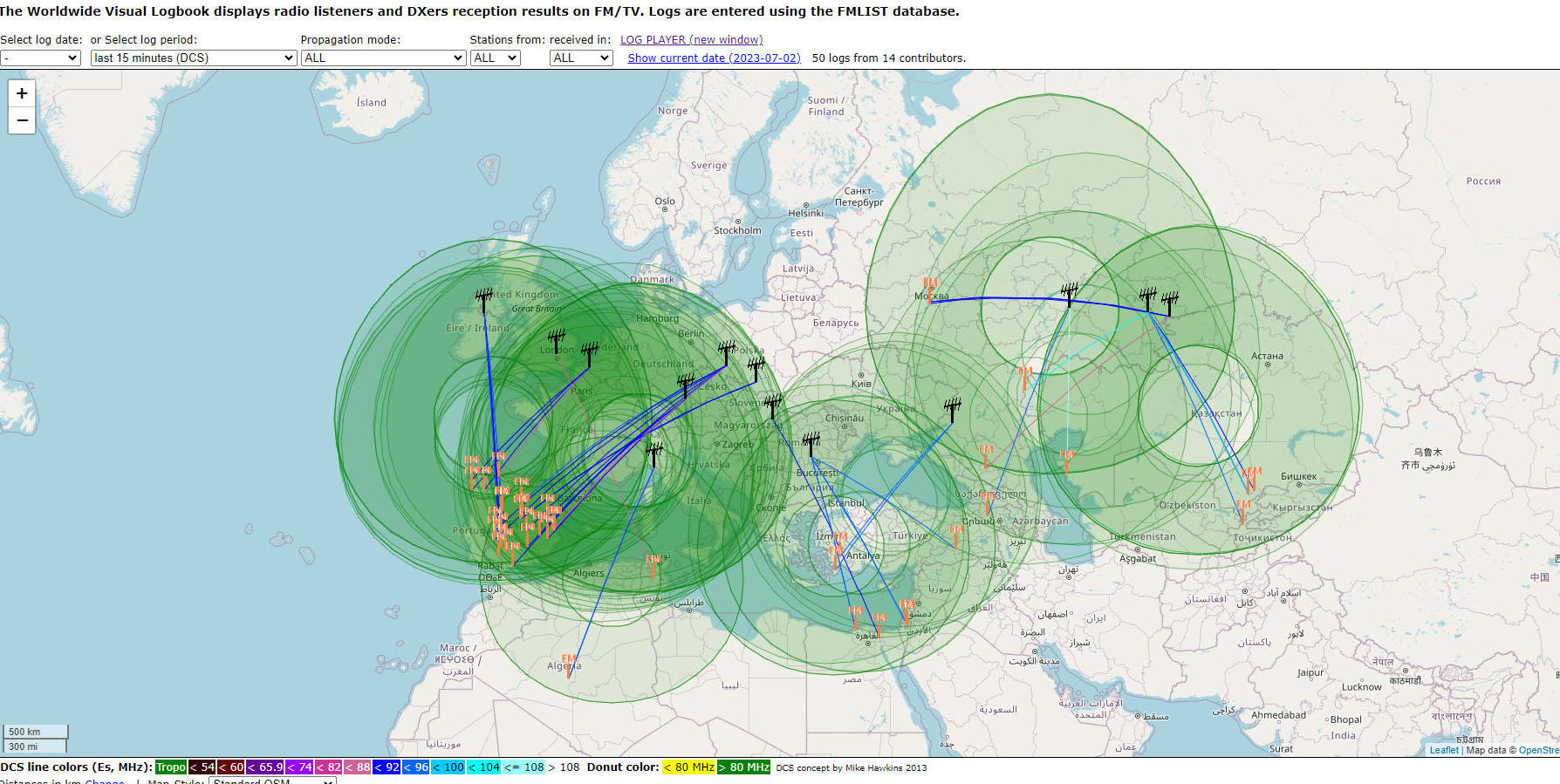
If we look instead at the map below from DXMAPS.com showing
50 MHz
spots seen in the DX Cluster, for the same time period, we can potentially
see two locations for the required double hop
50 MHz
Es
clouds, the first is possibly over
Austria
at the intersection of a few spot lines, the second over
Bosnia & Herzegovina.
That would make more sense, but is this correct? We need to see more
data to confirm or not.
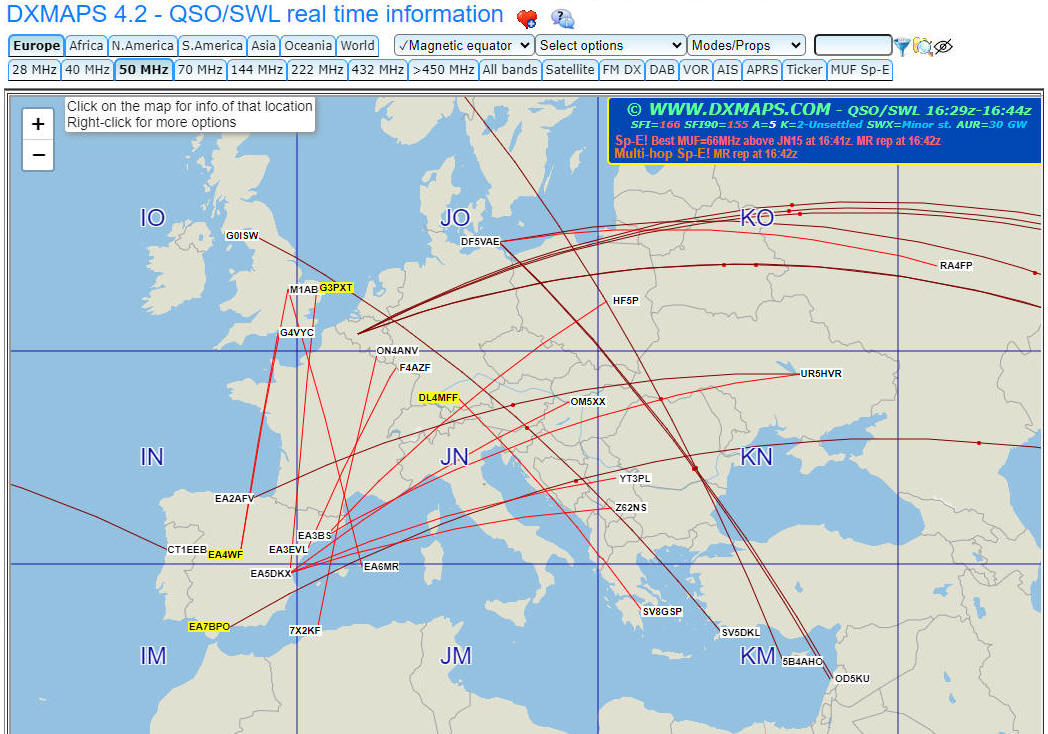
If we now look at the data image below, from PSKreporter.info, showing
stations worked/heard by me
G0ISW
for the same time period, we can definitely see the
Sporadic-E
path between me and
SV5DKL,
plus the similar double hop
2xEs
path for me hearing another station shown in
Israel.
Interesting to see at least 3 stations I heard in
Austria JN77/JN76,
who all appear to be directly beneath where I had initially suspected the
first
Es
cloud to be.
Therefore the first
Es
cloud cannot be directly over these stations in
Austria,
but must be earlier in the path, over
Germany
instead about locator squares
JO30/JO40,
at the midpoint between
G0ISW
and the three stations in
Austria
for what is clearly an
Es
single hop distance. The second
ES
cloud initial speculation location remains the same, somewhere over
Bosnia,
or further to the South East.
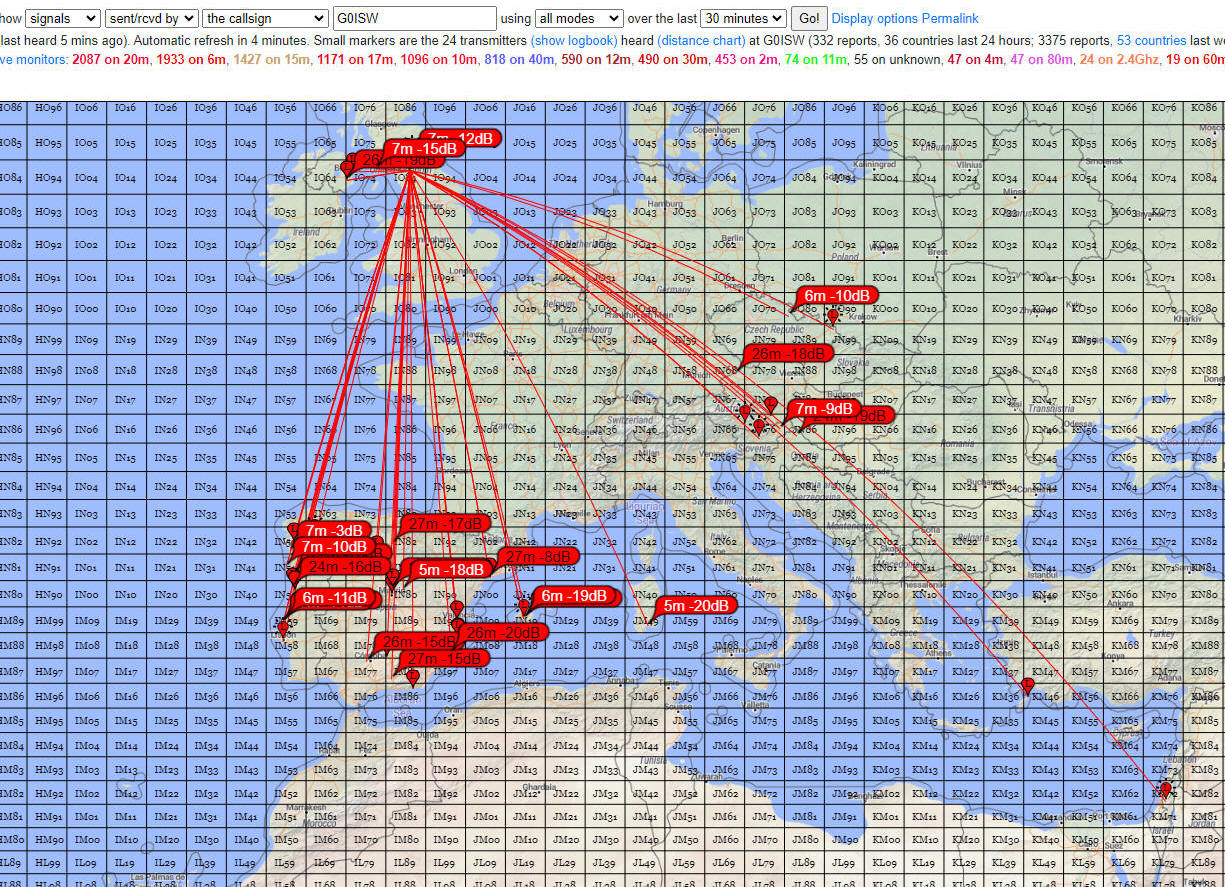
Unidentified Propagation
analysis (UK to Japan 50 MHz) Solved
Here we see
below on the morning of
Wednesday
12th July 2023
an opening on
50 MHz
between the
UK/Europe
and Japan
at distances of
over 8600km.
All areas are within daylight. The maximum triple hop
Sporadic-E
distance is
7200km,
so could this be
Quadruple
hop Es (4xES)?
We can
discount
TEP
involvement as all stations are well above the magnetic Equator. The only
other option for VHF at these distances would be F2 layer propagation.
Looking at
the DX Cluster spots for
50 MHz
there are very few single hop
Sporadic-E
spots showing within Europe so far. The SFI is at 214, unusually high
indicating recent solar activity above the normal yesterday, it was an
M-Class 5.8 solar flare. We are two years away from the next expected 11
year peak of the solar cycle, in July 2025. F2 propagation for
50 MHz
would then be expected, as previously seen, only over the Winter months, not
Summer now.
Conclusion
is that this can only therefore be
Quadruple
hop Sporadic-E (4xES)
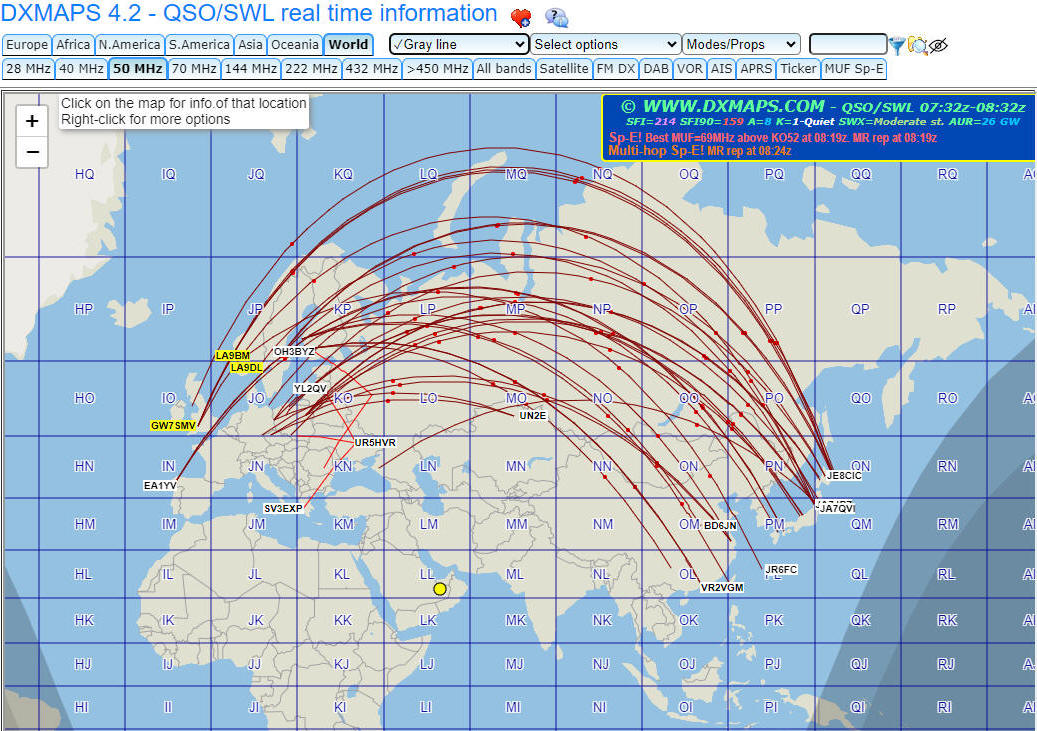

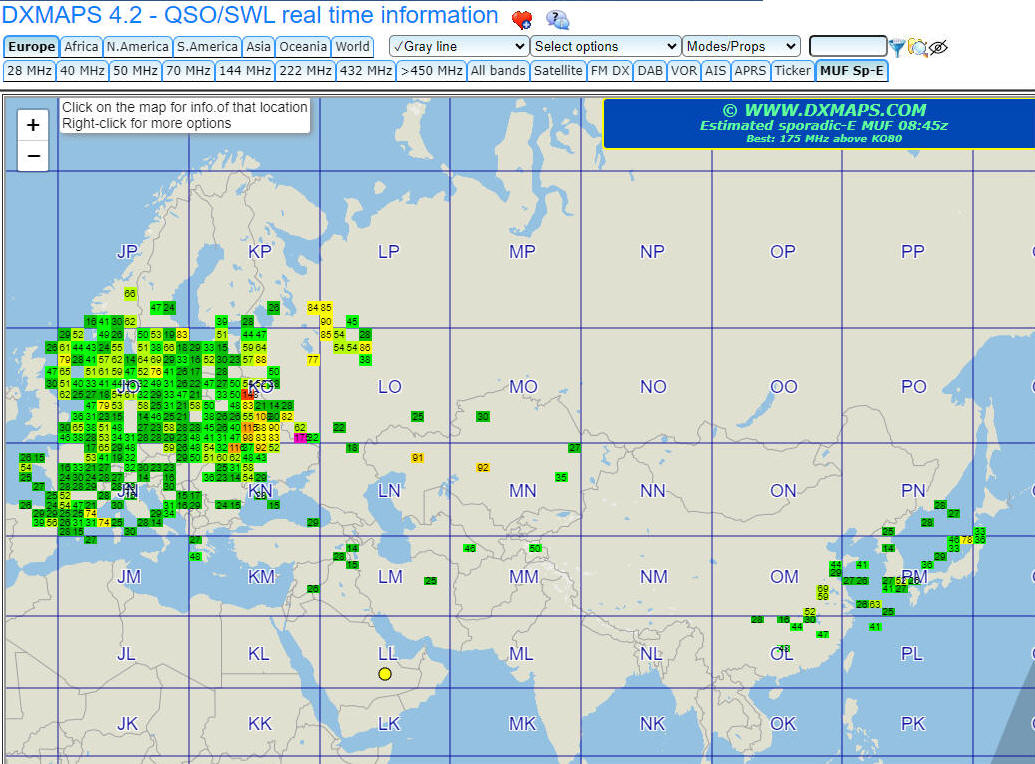
Interestingly a short time later by 0900 UTC a significant
Sporadic-E
opening on
144 MHz
had developed, centred over Ukraine, this supports
Es
clouds with clearly high enough MUF for
50 MHz
being present earlier over the Europe to Japan path. Quadruple hop
Sporadic-E (4xES)
now looking more and more certain.
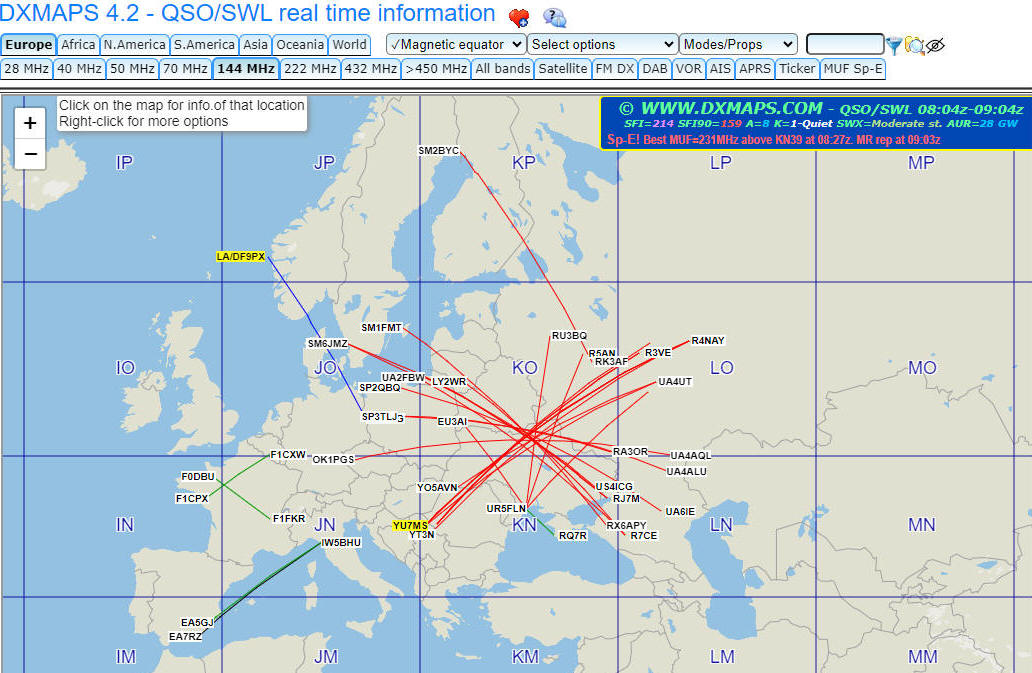
We can see
from the MUF map below for
Sporadic-E
that there are
Es
clouds that would support
50 MHz
signals over
Europe, Ukraine, Russia, China and Japan.
The lack of further reported MUF ES clouds in between may be
accounted for by the scarcity of amateur radio stations within
Siberia and Mongolia.
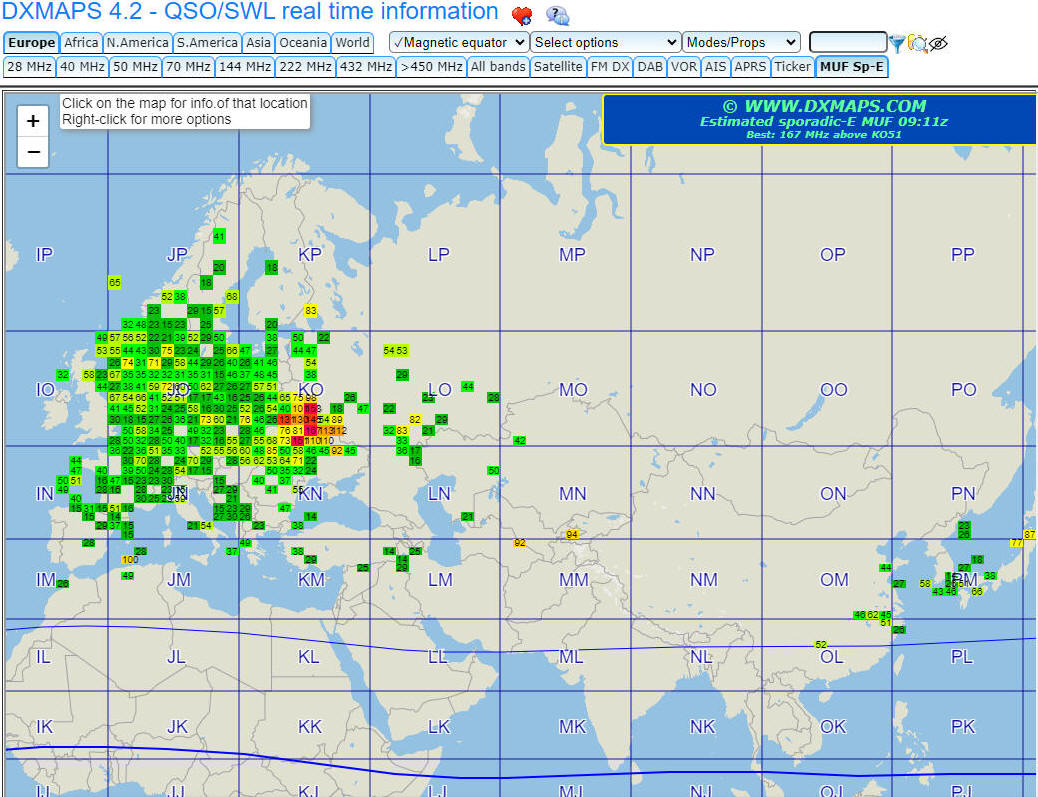
Quadruple hop 50 MHz
Sporadic-E (x4 ES) UK to Japan path
We have
seen this very rare event recently in
2023, after solar flares, on entirely daylight
paths between Europe and Japan on
50 MHz,
however this morning
Saturday
22nd July 2023 at 11.41 UTC
we can see it is still possible after the sun has completely set in Japan.
The solar flares with their extensive ionising radiation appear to be
generating broad areas of Sporadic-E enhancement over huge distances, the
latest flare was
M 3.81
class
on 19th July
2023.
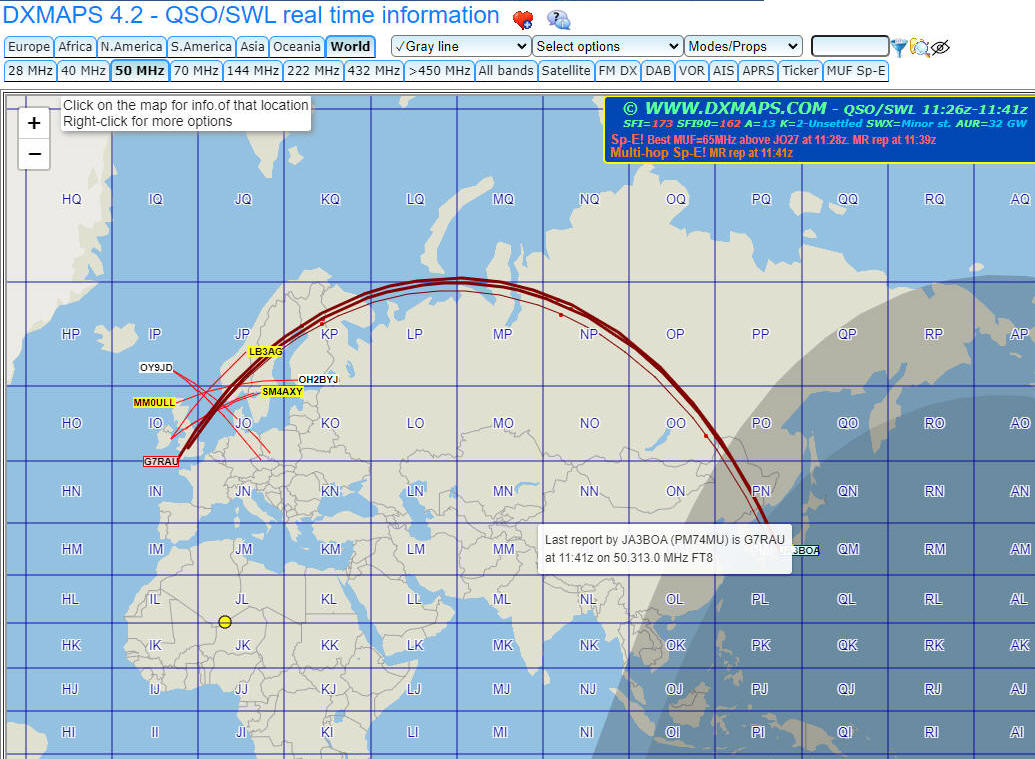 |
